Last Days Watchman
Signs – Seasons – Events
? ? Sun news for May 4, 2024: Almost X flare and sun stuff headed to Earth
? ? ? Yesterday’s X1.7 flare produced a CME and after analysis, was determined to be Earth-directed.
? ? The sun stayed at a high activity level.
? MORE at EarthSky: https://t.co/xD29wLfm4e pic.twitter.com/NwVFClqsb8
— Dr. C. Alex Young (@TheSunToday) May 4, 2024
Sun news for May 4, 2024: Almost-X flare! And sun-stuff headed to EarthToday’s top story: Yesterday’s X1.7 flare produced a coronal mass ejection (CME). Now, modeling and analysis shows a component is Earth-bound. The sun-stuff should arrive late May 5 to early May 6. We have the possibility for a G1(minor) to a G2 (moderate) geomagnetic storm. And that means auroras! Over the past day, the sun stayed at a high activity level, producing an almost-X flare. Active region AR3663 produced an M9.1 flare at 6:19 UTC on May 4. This sunspot region kept flaring all day, releasing four Ms and eight C flares for a total of 13 flares during our observation period.
Last 24 hours: Sun activity is high during the past day with the production of an almost-X flare and six M flares in total. Between 11 UTC yesterday and 11 UTC today, the sun released 20 flares: six M flares and 14 C flares. On May 4, at 6:19 UTC, active region AR3663 in the northwest produced an M9.1 flare, which was the largest event. Shortly after the flare, an R2 (moderate) radio blackout affected an area over the Bay of Bengal. The M flares of the period:
M1.2 flare by AR3654 at 22:47 UTC on May 3. R1 (minor) radio blackout on the Pacific Ocean over Hawaii.
M1.1 flare by AR3663 at 23:16 UTC on May 3. R1 (minor) radio blackout on the Pacific Ocean west of Hawaii.
M2.4 flare by AR3663 at 23:30 UTC on May 3. R1 (minor) radio blackout on the Pacific Ocean west of Hawaii.
M1.6 flare by AR3663 at 0:36 UTC on May 4. R1 (minor) radio blackout on the west Pacific Ocean.
M9.1 flare by AR3663 at 6:19 UTC on May 4. R2 (moderate) radio blackout over the Bay of Bengal. (The largest)
M1.5 flare by AR3663 at 7:07 UTC on May 4. R1 (minor) radio blackout over India.
The lead flare producer of the period was active region AR3663, which produced 13 flares, four M flares (the M9.1 included) and 8 C flares. The sun has six labeled regions on its Earth-facing side, including newcomer AR3666.
Next 24 hours: The chance for C flares is 99%. The chance for M flares is 75%. The chance for an X flare increased to 25%, as compared to yesterday’s 15%.
Next expected CME: Modeling and analysis of yesterday’s X1.7 event determined an associated coronal mass ejection (CME) is Earth-directed. The arrival is estimated to be late May 5 to early May 6. Two filament eruptions associated with active region AR3661 are under analysis. No other Earth-directed CMEs have been observed in coronagraph imagery.
Current geomagnetic activity: Earth’s magnetic field is quiet at the time of this writing (11 UTC on May 4). After the storm, there is calm. All perturbations calmed down to quiet levels after yesterday’s unexpected G3 (strong) geomagnetic storm. Conditions for G1 (minor) to G2 (moderate) geomagnetic storming may occur today, from late May 5 to early May 6. The coronal mass ejection (CME) that the sun launched during yesterday’s X1.7 event would be the cause of this activity. There may be the additional influence of high-speed solar wind from coronal holes. Together with this coronal mass ejection (CME), there is a good chance for auroral displays. Clear skies, aurora watchers!
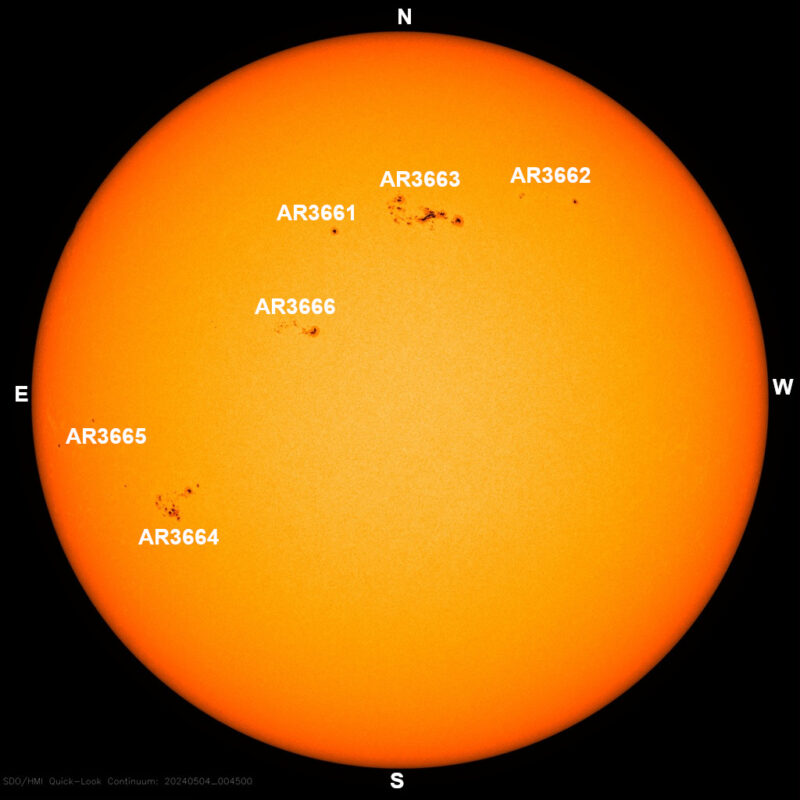 This image shows sun activity – with the most active regions labeled – as of 0 UTC on May 4, 2024. Original image, without labels, via NASA SDO. Courtesy of NASA/SDO and the AIA, EVE, and HMI science teams, with labeling by EarthSky. Today’s sun is posted by Armando Caussade. Why are east and west on the sun reversed?Sun news for May 3, 2024: KABOOM, X flare! Big storm at Earth
The EarthSky sun news team created this 1-minute video summary for you.
This image shows sun activity – with the most active regions labeled – as of 0 UTC on May 4, 2024. Original image, without labels, via NASA SDO. Courtesy of NASA/SDO and the AIA, EVE, and HMI science teams, with labeling by EarthSky. Today’s sun is posted by Armando Caussade. Why are east and west on the sun reversed?Sun news for May 3, 2024: KABOOM, X flare! Big storm at Earth
The EarthSky sun news team created this 1-minute video summary for you.
Kaboom! For the first time in over a month, the sun has blasted an X flare, the strongest category of solar flare. The X1.7 came from sunspot region AR3663 at 2:22 UTC on May 3. It caused a strong R3 radio blackout in an area over the Philippine Sea, south of Japan. The X flare marks a peak in the strong activity observed from this region recently; it’s been growing in size and magnetic complexity, becoming the only region to show a high potential beta-delta configuration. And it lived up to that potential! We’ve also seen excitement at Earth over the past day. An unexpected G3 (strong) geomagnetic storm started at 17:59 UTC on May 2, with the disturbance lasting for two three hour periods. Conditions for auroral displays were possible in northern latitudes as far south as Iowa and Oregon in the US. However, although some auroras were reported, the magnetic field orientation was not optimal for strong auroral activity. And on top of that, the storm occurred during the day over North America. But there’s still a chance for auroras tonight, so don’t put away those cameras …
Last 24 hours: Sun activity is high after the production of an X flare and three M flares. Between 11 UTC yesterday and 11 UTC today we saw 24 flares: an X, three M flares, and 20 C flares. The largest event was, of course, the X1.7 flare from AR3663 at 2:22 UTC on May 3. Here’s a breakdown of the past day’s major flares:
M2.8 by AR3664 at 20:57 UTC on May 2. R1 (minor) radio blackout over the Pacific Ocean east of Hawaii.
M2.7 by AR3664 at 0:15 UTC on May 3. R1 (minor) radio blackout over the Pacific Ocean west of Hawaii.
X1.7 by AR3663 at 2:22 UTC on May 3. R3 (strong) radio blackout over the Philippine Sea south of Japan.
M4.4 flare by AR3663 at 8:11 UTC on May 3. R1 (minor) radio blackout over the Arabian Sea.
The lead flare producer of the period was active region AR3663, which produced 13 flares: the X, an M, and 11 Cs. Closely behind was AR3664 in the southeast, which produced two Ms and seven C flares. The sun currently has seven labeled regions on its Earth-facing side, including newcomer AR3665.
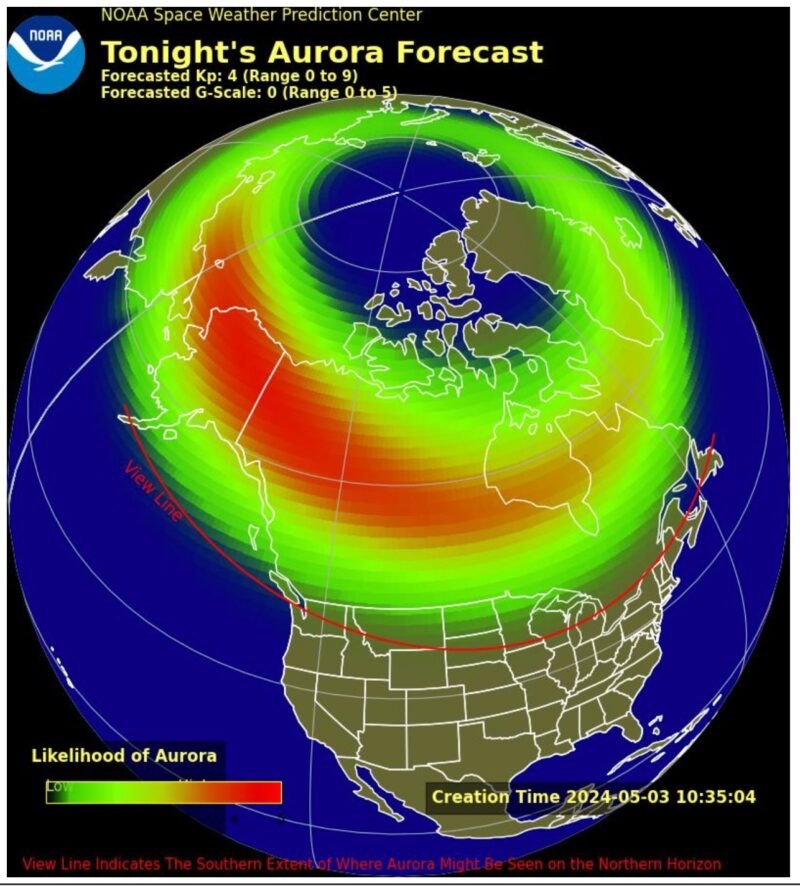 Here’s tonight’s aurora forecast, via NOAA. Good luck!Sun news for May 2, 2024: Bye bye, AR3654
The EarthSky sun news team created this 1-minute video summary for you. Can you see the comet?
Here’s tonight’s aurora forecast, via NOAA. Good luck!Sun news for May 2, 2024: Bye bye, AR3654
The EarthSky sun news team created this 1-minute video summary for you. Can you see the comet?
Sunspot region AR3654 has really grabbed our attention during its journey across the sun’s face. After growing to be as wide as 3 Earths, it blasted an enormous almost-X flare on Tuesday night. But now its time on the Earth-facing side of the sun is coming to an end, as it starts to rotate out of view. It’s given us a parting gift, though. Shortly after the almost-X flare, it launched a huge blob of sun-stuff – a coronal mass ejection (CME) – toward Earth. This is expected to arrive on May 4, possibly causing a G1 (minor) geomagnetic storm. And that could mean auroras! Plus, although its position on the solar limb (edge) makes it hard to determine AR3654’s magnetic complexity, it does still appear to have the potential to produce some big flares. Let’s see if it’s got any final action in store for us.
Last 24 hours: Solar activity during the past day was moderate after the production of four faint M flares. Between 11 UTC yesterday to 11 UTC today, the total flare production was 17: four Ms flares and 13 C flares. The largest event was an M1.9 flare from AR3654 at 14:44 UTC on May 1. All the M flares produced R1 (minor) radio blackouts over the sun-lit Earth. Here’s a breakdown of the M flares:
M1.8 flare by AR3654 at 14:32 UTC on May 1
M1.9 flare by AR3654 at 14:44 UTC on May 1 (the largest)
M1.8 flare by AR3663 at 22:31 UTC on May 1
M1.0 flare by AR3663 at 2:17 UTC on May 2
The lead flare producer of the period was active region AR3663 in the northeast quadrant, which produced six flares: two Ms and four Cs. The sun currently has six labeled regions on its Earth-facing side, including newcomer AR3664.
An almost-X flare! It happened late yesterday (23:23 UTC on April 30). The M9.5 flare produced an R2 (moderate) radio blackout over the Pacific Ocean west of Hawaii. It’s not uncommon for a large flare to follow an earlier large flare. Will we see a true X flare from AR3654? After yesterday’s blast, the region reduced its magnetic complexity. It’s now showing a beta-delta configuration, indicating a reduced potential for flaring. The sun’s rotation is about to carry this region out of view. It’s located close to the sun’s southwest limb (edge), and that location is making it difficult for experts to analyze its exact magnetic configuration. Stay tuned.
Last 24 hours: Sun activity is high with the production of an M9.5 flare. Between 11 UTC yesterday to 11 UTC today, the sun produced seven solar flares: four C flares and three M flares. The largest event was an almost-X flare, an M9.5 flare from active region AR3654 at 23:46 UTC on April 30. Prior to the M9.5, the region produced two small M flares, both of which – like the main flare – produced R1 (minor) radio blackouts over the Pacific Ocean. The lead flare producer was AR3654 with five flares, two Cs and the three Ms of the period, including the M9.5 flare. There are five regions on the Earth-facing side of the sun. There is a newcomer in the northeast quadrant, AR3663.
Excitement is brewing on our star, with sunspot region AR3654 looking like a potential X flare producer. This giant sunspot region has continued to grow over the past day, and its beta-gamma-delta magnetic complexity indicates that it could produce some seriously large solar flares. Bring it on, AR3654! We’ve not seen an X flare since March 28, when our old friend AR3615 gave us an X1.1. AR3654 has a few days to bring the action before it rotates out of view over the southwestern limb (edge). Before it does, be sure to take a look at this sunspot through safe solar viewing or eclipse glasses – it’s big enough that you don’t need any magnification aid. What you won’t be able to see are the four coronal holes that are currently adding to the excitement on our sun. These are regions where the sun’s magnetic field opens into space, letting fast solar wind pour out. Since this wind can disturb Earth’s magnetic field, these coronal holes are giving us an increased chance for auroras at the moment. So, all we need now for an amazing auroral display is an Earth-bound coronal mass ejection (CME) from a big flare… We’re looking at you, AR3654!
Last 24 hours: Sun activity has been moderate over the past day with the production of an isolated M flare. Between 11 UTC yesterday to 11 UTC today, the sun released 13 solar flares: 12 C flares and one M flare. The largest event was an M1.6 flare from AR3654 at 1:14 UTC on April 30. The flare produced an R1 (minor) radio blackout over the Pacific Ocean at the boundaries of the Philippine Sea. The lead flare producer of the period was AR3654 with nine flares, including the M flare. There are currently five regions on the Earth-facing side of the sun, including newcomers AR3661 and AR3662.
Sunspot region AR3654 continues to increase in size and maintain its magnetic complexity. We expected more to come from the region, and it did not disappoint. It fired off 15 of the observation period’s 17 flares, including two M flares. The region also grew from an area twice that of Earth to more than three times that of Earth. With your eclipse glasses, you should be able to glimpse it from Earth. AR3654 is located near the equator in the western hemisphere. This means that if the region erupts, there is a greater chance for solar stuff to head our way, especially solar energetic particles. Will AR3654 send more activity our way? Stay tuned.
Last 24 hours: Solar activity is moderate, with two M flares over the past 24 hours from AR3654. The sun released 17 solar flares15 C flares and two M flares. The largest event, an M3.7 flare, happened at 00:54 UTC on April 29. The second event, an M2.5 flare, happened at 00:33 on April 29. Both M flares produced an R1 (minor) radio blackout over the Pacific Ocean. AR3654 grew to an area three times that of Earth over the current observation period, 11 UTC yesterday to 11 UTC today. The region has maintained its delta region. Two filaments erupted from the northeast and southeast limbs (edges) around 6:52 UTC. There are six regions on the Earth-facing side of the sun now.
? ? Sun news for April 29, 2024: Giant sunspot continues to grow
? ? Sunspot region AR3654 continues to increase in size and maintain its magnetic complexity. We expected more from the region, and it did not disappoint.
? MORE at EarthSky: https://t.co/xD29wLfm4e pic.twitter.com/WKei6mFYrP
— Dr. C. Alex Young (@TheSunToday) April 29, 2024
Sun news for April 28, 2024: huge sunspot region poised for more action!Sunspot region AR3654 doubled in size over the past day. It’s now about 2 planets in diameter. With your eclipse glasses, you might be able to glimpse it from Earth. At its location near the center of the sun’s visible disk, it could give us some excitement over the next few days. That’s because, besides growing in size, AR3654 has increased in magnetic complexity, indicating a potential for more flares. It already produced two M flares over the past day. Will we see more? Plus, given AR3654’s location on the sun’s visible disk, any eruptions will have a chance of sending sun-stuff our way. And that could mean more auroras in the days ahead. The region appears to have produced a small coronal mass ejection at around 11 UTC on April 27. That event could impact Earth in mid-to-late May 1. Stay tuned.
Last 24 hours: Solar activity is moderate, with two M flares over the past 24 hours from AR3654. The largest event, an impulsive M3.0 flare, happened at 21:29 UTC on April 27. The second event, an M2.1 flare, happened at 12:33 on April 27. AR3654 is now the largest sunspot region on the sun’s disk. Overall, flare production was lower over the past day (11 UTC yesterday to 11 UTC today), with two M and five C flares. A new Region, 3660, got its number. There are nine regions on the Earth-facing side of the sun now.
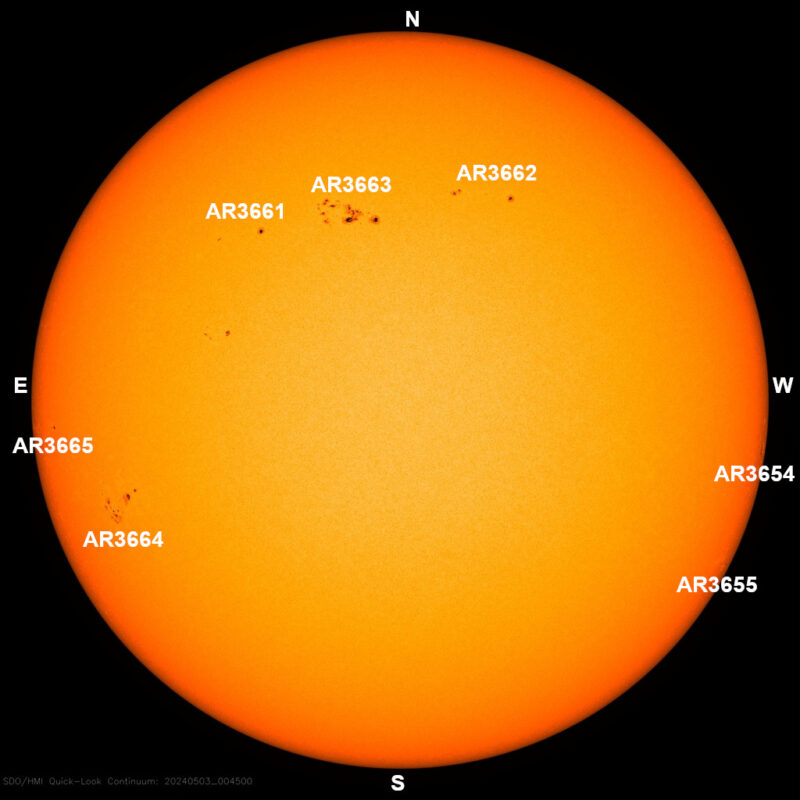 This image shows sun activity, with the most active regions labeled, as of 0 UTC on May 3, 2024. Courtesy of NASA/SDO and the AIA, EVE, and HMI science teams, with labeling by EarthSky.
This image shows sun activity, with the most active regions labeled, as of 0 UTC on May 3, 2024. Courtesy of NASA/SDO and the AIA, EVE, and HMI science teams, with labeling by EarthSky.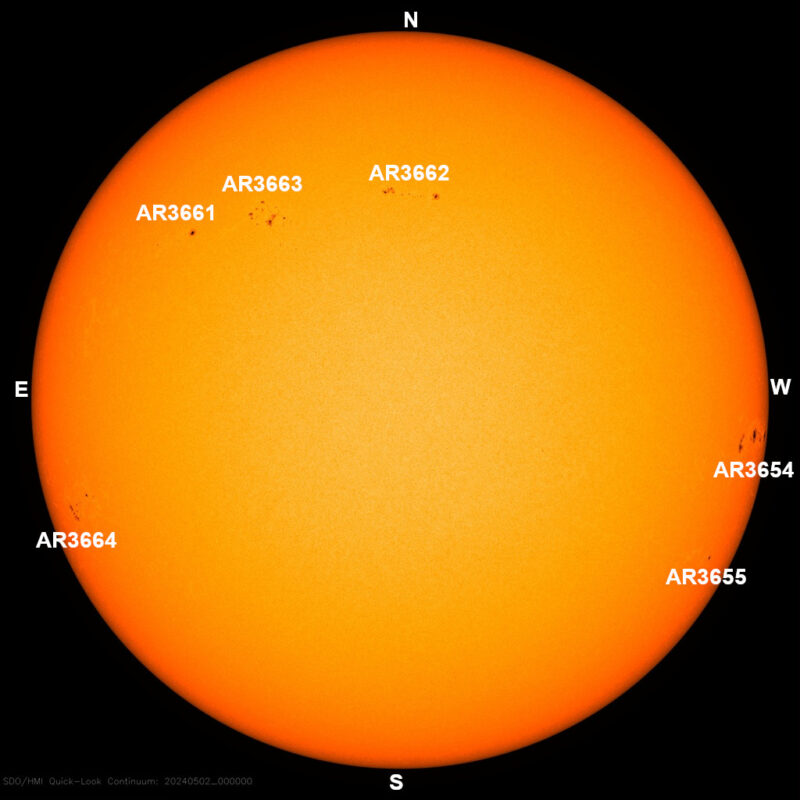 This image shows sun activity, with the most active regions labeled, as of 0 UTC on May 2, 2024. Courtesy of NASA/SDO and the AIA, EVE, and HMI science teams, with labeling by EarthSky.
This image shows sun activity, with the most active regions labeled, as of 0 UTC on May 2, 2024. Courtesy of NASA/SDO and the AIA, EVE, and HMI science teams, with labeling by EarthSky.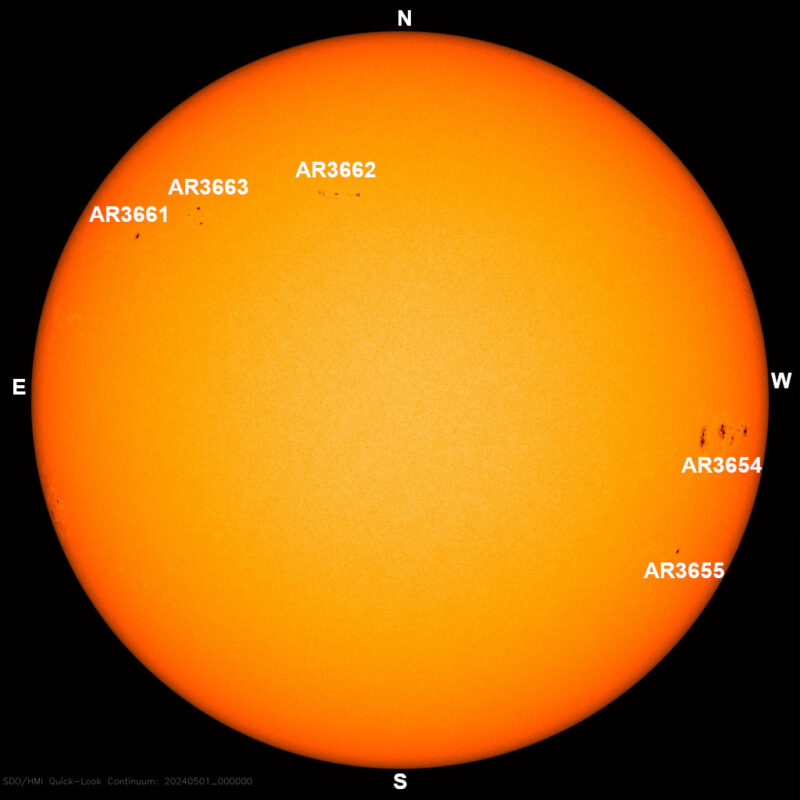 This image shows sun activity, with the most active regions labeled, as of 0 UTC on May 1, 2024. Courtesy of NASA/SDO and the AIA, EVE, and HMI science teams, with labeling by EarthSky.
This image shows sun activity, with the most active regions labeled, as of 0 UTC on May 1, 2024. Courtesy of NASA/SDO and the AIA, EVE, and HMI science teams, with labeling by EarthSky.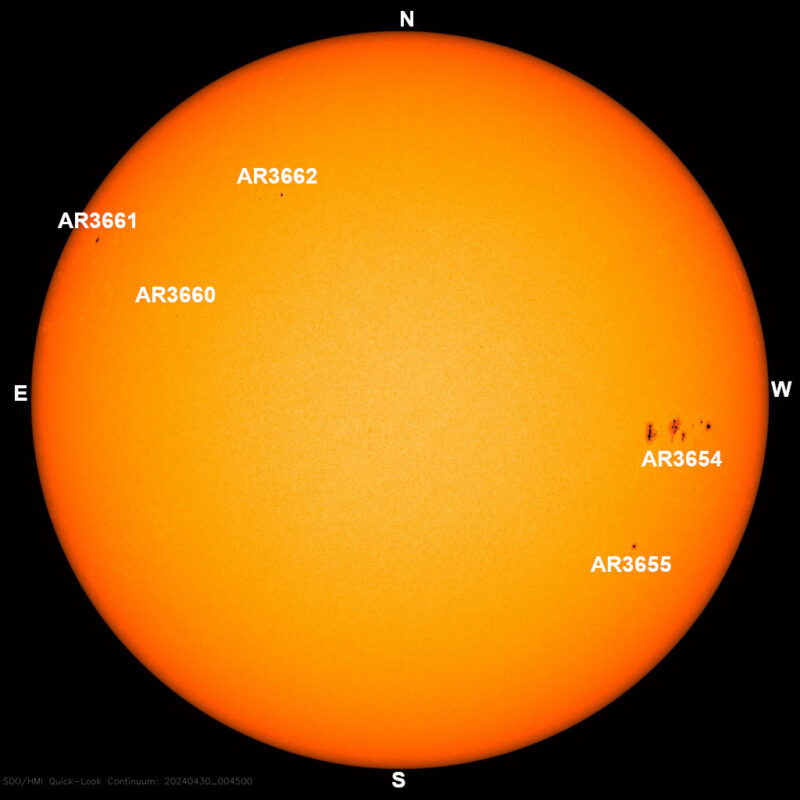 This image shows sun activity, with the most active regions labeled, as of 0 UTC on April 30, 2024. Courtesy of NASA/SDO and the AIA, EVE, and HMI science teams, with labeling by EarthSky.
This image shows sun activity, with the most active regions labeled, as of 0 UTC on April 30, 2024. Courtesy of NASA/SDO and the AIA, EVE, and HMI science teams, with labeling by EarthSky.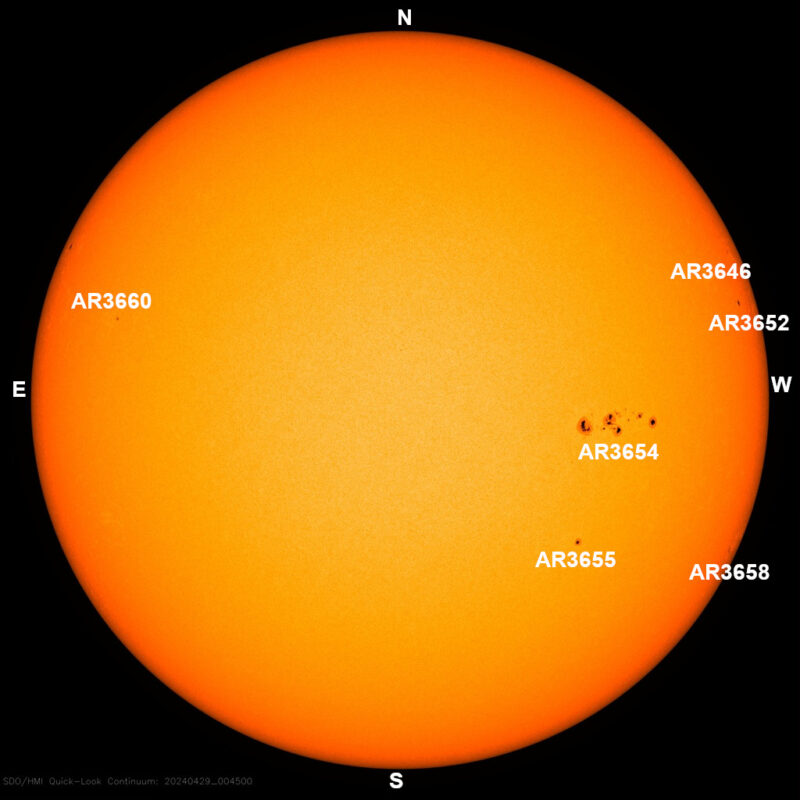 This image shows sun activity, with the most active regions labeled, as of 0 UTC on April 29, 2024. Courtesy of NASA/SDO and the AIA, EVE, and HMI science teams, with labeling by EarthSky.
This image shows sun activity, with the most active regions labeled, as of 0 UTC on April 29, 2024. Courtesy of NASA/SDO and the AIA, EVE, and HMI science teams, with labeling by EarthSky.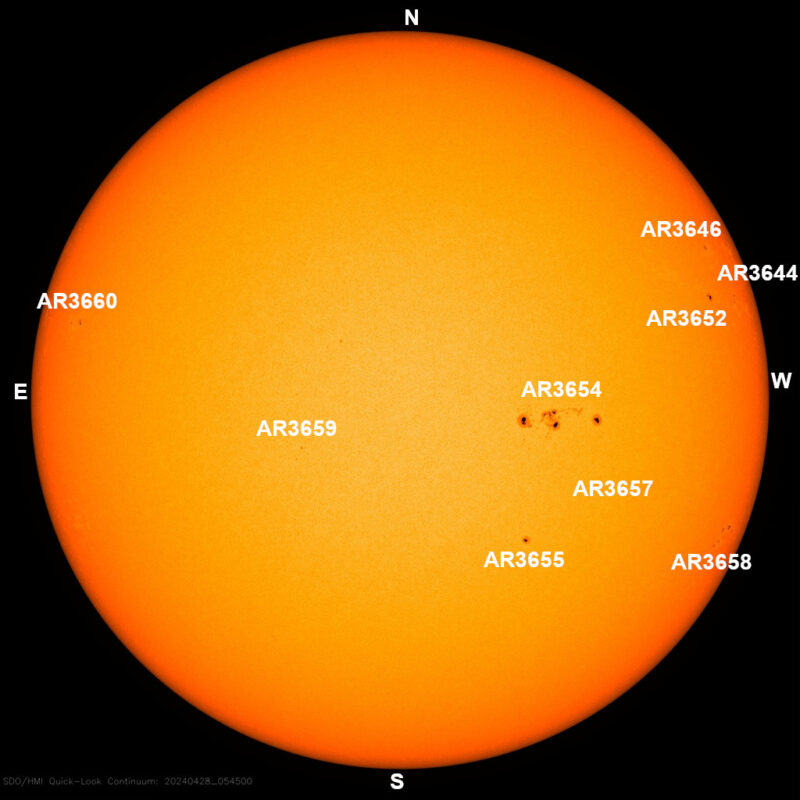 This image shows sun activity, with the most active regions labeled, as of 5 UTC on April 28, 2024. Courtesy of NASA/SDO and the AIA, EVE, and HMI science teams, with labeling by EarthSky.
This image shows sun activity, with the most active regions labeled, as of 5 UTC on April 28, 2024. Courtesy of NASA/SDO and the AIA, EVE, and HMI science teams, with labeling by EarthSky. This image shows sun activity, with the most active regions labeled, as of 3 UTC on April 27, 2024. Courtesy of NASA/SDO and the AIA, EVE, and HMI science teams, with labeling by EarthSky.Sun images from our community
This image shows sun activity, with the most active regions labeled, as of 3 UTC on April 27, 2024. Courtesy of NASA/SDO and the AIA, EVE, and HMI science teams, with labeling by EarthSky.Sun images from our community
Are you a fan of sun images? We invite you all to send us your beautiful recent photos of sunspots and auroras. We love receiving them and sharing them! And to those of you who’ve already posted a photo to our community page, thank you.
 View at EarthSky Community Photos. | Patricio León in Santiago, Chile, captured this filtered image of the sun on May 3, 2024. Patricio wrote: “Complex sunspot AR3663, upper center, has already emitted an X flare and it is detectable with protected eye; interesting enough I think.” Thank you, Patricio!
View at EarthSky Community Photos. | Patricio León in Santiago, Chile, captured this filtered image of the sun on May 3, 2024. Patricio wrote: “Complex sunspot AR3663, upper center, has already emitted an X flare and it is detectable with protected eye; interesting enough I think.” Thank you, Patricio!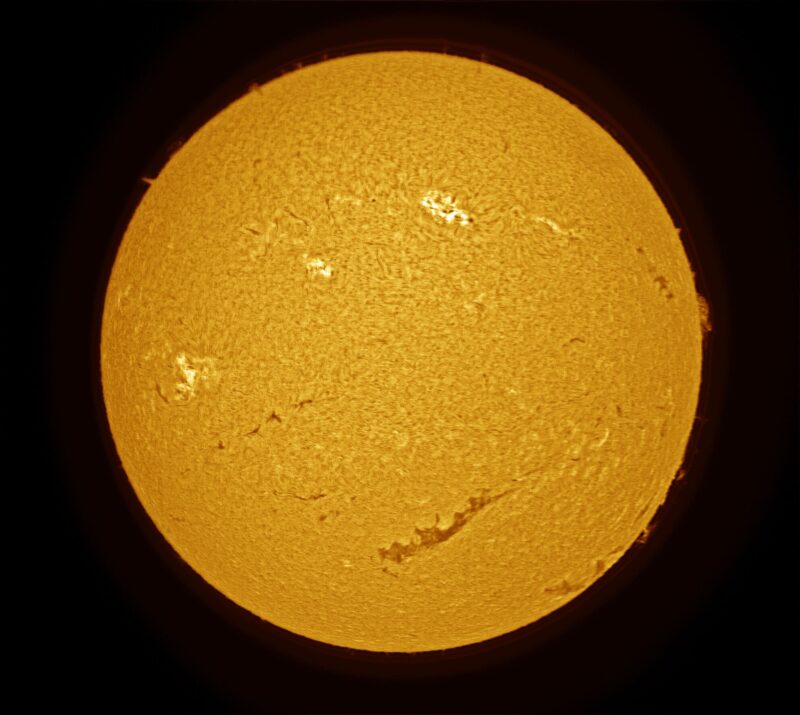 View at EarthSky Community Photos. | Jim Militello in Tucson, Arizona, captured this hydrogen-alpha filtered image of the sun on May 3, 2024. Jim wrote: “The image shows a few active regions with sunspots and a large filament.” Thank you, Jim!
View at EarthSky Community Photos. | Jim Militello in Tucson, Arizona, captured this hydrogen-alpha filtered image of the sun on May 3, 2024. Jim wrote: “The image shows a few active regions with sunspots and a large filament.” Thank you, Jim!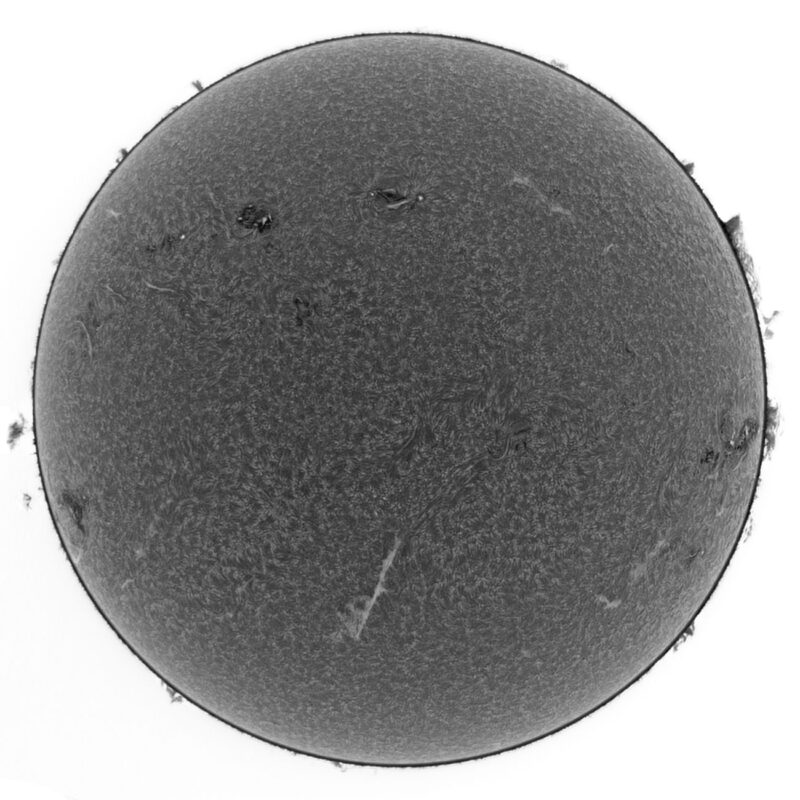 View at EarthSky Community Photos. | Mario Rana in Hampton, Virginia, captured this filtered image on May 1, 2024. Mario wrote: “Active region AR3654 is rotating out of view while AR3664 is rotating into view. There are some beautiful prominences too.” Thank you, Mario!
View at EarthSky Community Photos. | Mario Rana in Hampton, Virginia, captured this filtered image on May 1, 2024. Mario wrote: “Active region AR3654 is rotating out of view while AR3664 is rotating into view. There are some beautiful prominences too.” Thank you, Mario! View at EarthSky Community Photos. | David Hawkes in Sheffield, United Kingdom, captured this filtered image of the sun on April 30, 2024. David wrote: “Perfect conditions, the giant active region 3654 is still visible dominating the western limb.” Thank you, David!
View at EarthSky Community Photos. | David Hawkes in Sheffield, United Kingdom, captured this filtered image of the sun on April 30, 2024. David wrote: “Perfect conditions, the giant active region 3654 is still visible dominating the western limb.” Thank you, David! View at EarthSky Community Photos. | David Hoskin in Halifax, Nova Scotia, Canada, captured this filtered image of the sun on April 28, 2024. David wrote: “Filtered white light image of the sun captured earlier today. The large sunspot group (inset) is AR3654, which unleashed an M-class solar flare on April 27.” Thank you, David!
View at EarthSky Community Photos. | David Hoskin in Halifax, Nova Scotia, Canada, captured this filtered image of the sun on April 28, 2024. David wrote: “Filtered white light image of the sun captured earlier today. The large sunspot group (inset) is AR3654, which unleashed an M-class solar flare on April 27.” Thank you, David!Bottom line: Sun news for May 4, 2024. AR3663 is at it again. It produced an almost-X flare. Also, yesterday’s X flare sent a CME our way. Auroras!?
The post Sun news May 4: Almost-X flare! And sun-stuff headed to Earth first appeared on EarthSky.
EarthSky’s Deborah Byrd and Kelly Kizer Whitt answered questions from our readers and viewers about this meteor shower. Eta Aquariid Q and A here!
We’re about to reach our annual fund-raising goal! Thank you to all who’ve donated! Donate here.
May 2024 meteors … the Eta AquariidsWhen to watch: New moon will fall a few days after the peak of the 2024 Eta Aquariid shower. So, mornings around the peak will be dark and moonless. The best mornings to watch are May 5 and 6, 2024, in the hours before dawn. Why before dawn? See Radiant below. The American Meteor Society is listing 8:43 UTC on May 5 as the shower’s predicted** peak time. But times vary between different experts. And the peak of this shower stretches out over several days. So you can expect elevated numbers of meteors a few days before and after the peak time.
Nearest moon phase: New moon will fall at 03:22 UTC on May 8. So a thin waning crescent moon will not obscure the 2024 Eta Aquariids on the mornings around the predicted peak.
Radiant: Will rise in the wee hours, climbing toward its highest point at dawn. That’s why before dawn will be the best time to watch this shower.
Duration of shower: April 15 to May 27.
Expected meteors at peak, under ideal conditions: In the southern half of the U.S., you might see 10 to 20 meteors per hour under a dark sky, with no moon, when the radiant is high in the sky. Farther south – at latitudes in the Southern Hemisphere – you might see two to three times that number.
Note: The Eta Aquariids’ radiant will be on the ecliptic, which will ride low in the sky on spring mornings as seen from the Northern Hemisphere. That’s why this shower favors the Southern Hemisphere. It’s often that hemisphere’s best meteor shower of the year.
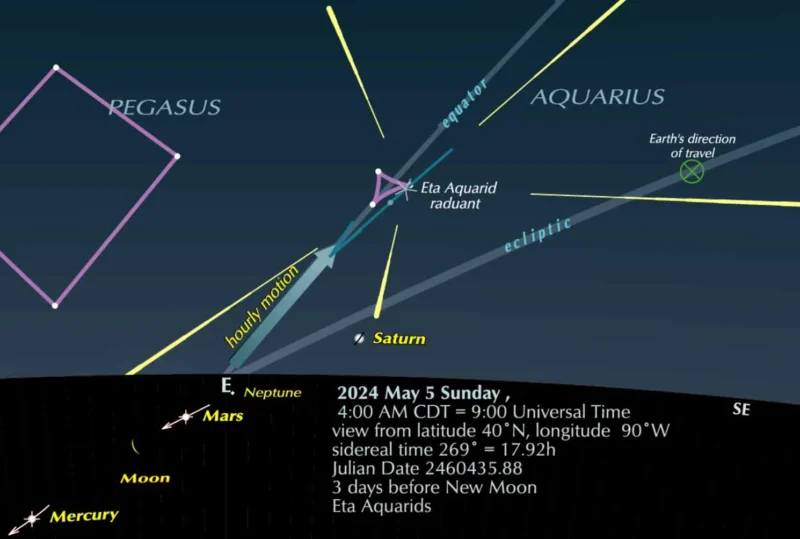 This sky scene shows the radiant of the Eta Aquarids climbing into view after midnight. With each passing hour, the radiant moves higher and more meteors may show above the horizon. Notice the point marked ‘Earth’s direction of travel.’ The orbit of the meteors (and their parent comet) is retrograde: contrary to Earth’s orbital direction. So the meteors hit the front – the morning side – of Earth. That is why they make swift trails, and why we see most of them after midnight. Chart and caption via Guy Ottewell’s blog. Used with permission.More about this shower’s radiant
This sky scene shows the radiant of the Eta Aquarids climbing into view after midnight. With each passing hour, the radiant moves higher and more meteors may show above the horizon. Notice the point marked ‘Earth’s direction of travel.’ The orbit of the meteors (and their parent comet) is retrograde: contrary to Earth’s orbital direction. So the meteors hit the front – the morning side – of Earth. That is why they make swift trails, and why we see most of them after midnight. Chart and caption via Guy Ottewell’s blog. Used with permission.More about this shower’s radiant
If you trace the paths of the Eta Aquariid meteors backward, they all seem to radiate from a certain point in front of the constellation Aquarius the Water Bearer. This point on the sky’s dome is called the radiant of the meteor shower, which nearly aligns with the faint star Eta Aquarii. Hence, this meteor shower gets its name from this star.
Eta Aquarii is one of the four stars making up the Y-shaped Water Jar asterism in the northern part of Aquarius. If you can find the Water Jar in the constellation Aquarius, you’ve located the radiant point for the Eta Aquariid meteors. The alignment of the radiant and the star is, of course, coincidental. Eta Aquarii is some 170 light-years away – trillions upon trillions of miles away – while the Eta Aquariid meteors burn up nearby – only 60 miles (100 km) above Earth’s surface.
Meteor shower radiants are sometimes misunderstood by casual meteor-watchers. You don’t need to know where they are to watch a meteor shower. That’s because the meteors fly every way across the sky, in front of numerous constellations. However, the higher a shower’s radiant appears in your sky, the more meteors you’re likely to see. For the Eta Aquariids, the radiant soars highest in the nighttime sky just before dawn. That’s one of the reasons why you can expect to see the most meteors in the wee morning hours.
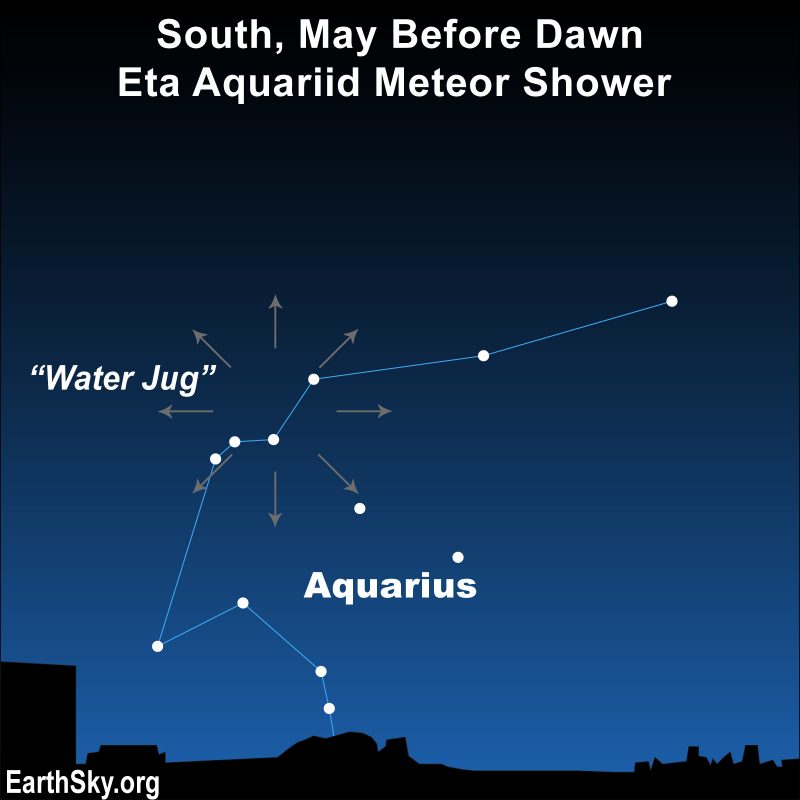 The radiant point of the Eta Aquariid meteor shower is near the star Eta Aquarii in the constellation Aquarius the Water Bearer. The radiant rises in the wee hours after midnight and is still climbing toward its highest point at dawn. That highest point is in the south as viewed from the Northern Hemisphere, closer to overhead for the Southern Hemisphere. That’s why the Southern Hemisphere sees more meteors (the radiant is higher up), and it’s why – for all of us around the globe – the hours before dawn are best for this shower.How to view a meteor shower
The radiant point of the Eta Aquariid meteor shower is near the star Eta Aquarii in the constellation Aquarius the Water Bearer. The radiant rises in the wee hours after midnight and is still climbing toward its highest point at dawn. That highest point is in the south as viewed from the Northern Hemisphere, closer to overhead for the Southern Hemisphere. That’s why the Southern Hemisphere sees more meteors (the radiant is higher up), and it’s why – for all of us around the globe – the hours before dawn are best for this shower.How to view a meteor shower
As with all meteors in annual showers, no special equipment is required to watch the Eta Aquariids. But a little luck always helps.
Find a dark, open sky away from artificial lights, and sprawl out on a reclining lawn chair.
Make yourself comfortable with a hot flask of your favorite beverage. Keep warm but not so snug that you fall asleep!
Meteor watching is a lot like fishing. Sometimes you catch a good number of them, and sometimes you don’t.
Meteor showers: Tips for watching the show
The Eta Aquariids’ parent cometThis section is by the late, great Don Machholz (1952-2022), who discovered 12 comets …
The object responsible for the Eta Aquariid meteor shower – that is, its parent comet – is the famous Halley’s Comet. This comet is in a retrograde orbit around the sun. That means it runs around the sun in the opposite direction from Earth and all the other planets. As a result, we pass near its path twice, one time along the outbound portion of the comet’s orbit. That happens every early May, causing the Eta Aquariid meteor shower. The other time is along the inbound portion of the comet’s orbit, and that passage causes the Orionid meteor shower in late October of each year.
Halley’s Comet orbits the sun on an average of every 76 years (the range is from 74 through 79 years due to perturbations of the planets). So, in most years, the comet is nowhere near when we sweep through its orbit, and when debris left behind by the comet enters our atmosphere to create Halley’s two meteor showers.
Perhaps you saw Halley’s Comet when it returned last, in 1985/86. It has been observed since the year 240 BCE. Presently, the comet is traveling heading back toward the sun at about 0.6 miles a second (0.9 km/sec).
In December of 2023, the comet reached its farthest point from the sun, which binds it in orbit. Then – pulled inexorably by the sun’s gravity – it curved around and is heading back toward the inner solar system again. Halley’s Comet will be back in 2061.
While waiting for Halley’s Comet to return, watch for the next best thing: the Eta Aquariid meteor shower in early May.
 Halley’s comet, the parent of the May Eta Aquariid and October Orionid meteor showers. Dust from this comet will light the night as Eta Aquariid meteors on the morning of May 5. Image via NASA.Eta Aquariid meteor shower photos from EarthSky’s community
Halley’s comet, the parent of the May Eta Aquariid and October Orionid meteor showers. Dust from this comet will light the night as Eta Aquariid meteors on the morning of May 5. Image via NASA.Eta Aquariid meteor shower photos from EarthSky’s community
 View at EarthSky Community Photos. | Eliot Herman in Tucson, Arizona, captured this photo of an Eta Aquariid meteor on May 5, 2021. He wrote: “1:48 am on peak night. The radiant is still below the horizon, resulting in this long-trail meteor with the beautiful green, typical of Halley’s comet-derived meteors. My backyard view.” Thank you, Eliot!
View at EarthSky Community Photos. | Eliot Herman in Tucson, Arizona, captured this photo of an Eta Aquariid meteor on May 5, 2021. He wrote: “1:48 am on peak night. The radiant is still below the horizon, resulting in this long-trail meteor with the beautiful green, typical of Halley’s comet-derived meteors. My backyard view.” Thank you, Eliot!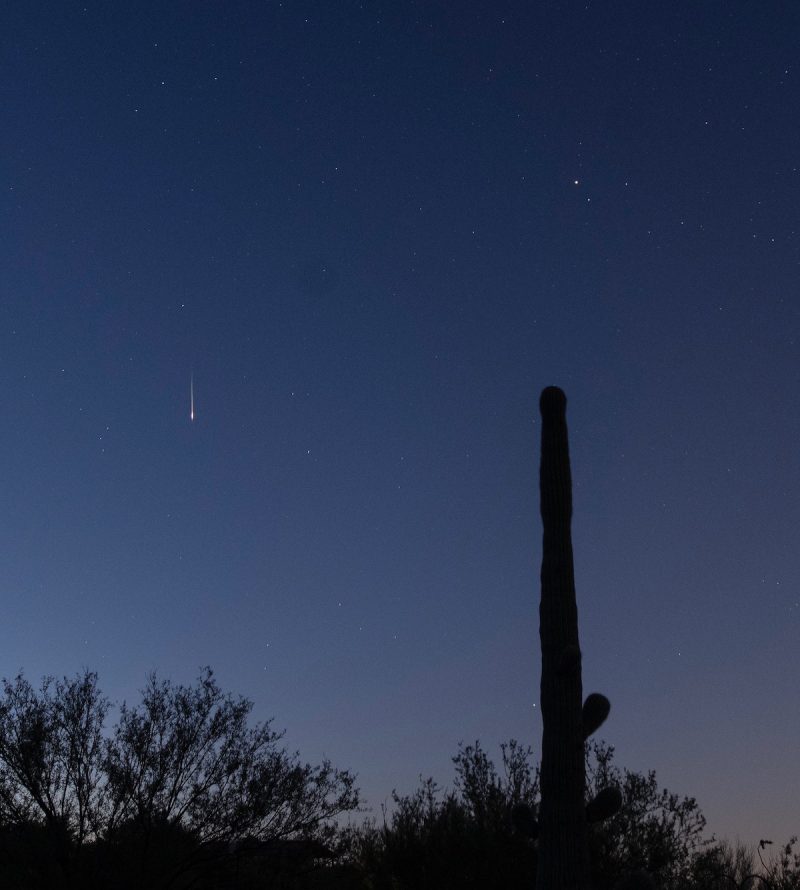 You can see the Eta Aquariids’ radiant point – the Water Jar asterism in the constellation Aquarius, visible as a noticeable pattern of 4 stars in the top left – in this photo by Eliot Herman in Tucson, Arizona, on May 4, 2020. Thank you, Eliot! Used with permission.
You can see the Eta Aquariids’ radiant point – the Water Jar asterism in the constellation Aquarius, visible as a noticeable pattern of 4 stars in the top left – in this photo by Eliot Herman in Tucson, Arizona, on May 4, 2020. Thank you, Eliot! Used with permission. View at EarthSky Community Photos. | Mary Jo Machnica in Hamburg, New York, captured this photo of an Eta Aquariid on May 6, 2021. She wrote: “I knew that the Eta Aquariids meteor shower was going to peak this morning. I knew there was going to be a ton of light pollution. But, it didn’t matter. I just needed to be under the stars. Needing to feel small. Getting there right before 3 AM. I set up my camera. Super damp out! Glad I have my lens warmer. With everything set up. I just keep taking photo after photo hoping to capture a glimpse of a meteor. I see a couple meteors with my eyes, but they don’t show up in the photo … That’s ok. I keep snapping away.” Thank you!
View at EarthSky Community Photos. | Mary Jo Machnica in Hamburg, New York, captured this photo of an Eta Aquariid on May 6, 2021. She wrote: “I knew that the Eta Aquariids meteor shower was going to peak this morning. I knew there was going to be a ton of light pollution. But, it didn’t matter. I just needed to be under the stars. Needing to feel small. Getting there right before 3 AM. I set up my camera. Super damp out! Glad I have my lens warmer. With everything set up. I just keep taking photo after photo hoping to capture a glimpse of a meteor. I see a couple meteors with my eyes, but they don’t show up in the photo … That’s ok. I keep snapping away.” Thank you!Bottom line: May’s Eta Aquariid meteor shower is good over several mornings. But the best time is on May 5 and 6, 2024, in the hours before dawn.
Read more: Why the Eta Aquariids are best from the Southern Hemisphere.
Visit EarthSky’s meteor shower guide for 2024
Report a fireball (very bright meteor) to the American Meteor Society: it’s fun and easy!
**Predicted peak times and dates for meteor showers are from the American Meteor Society. Note that meteor shower peak times can vary. Back to top.
The post Eta Aquariid meteor shower this weekend! Q&A here first appeared on EarthSky.
The Eta Aquariid meteor shower has a broad peak. But the best times to watch will likely be before dawn on May 5 and 6, 2024. With the new moon a few days away, there won’t be any moonlight to hinder meteor watching. Under ideal conditions, you might see around 20 meteors per hour. More details in the 1-minute video below, from EarthSky’s Marcy Curran.
Want more about the Eta Aquariids? Try this Q and A from EarthSky’s Deborah Byrd and Kelly Kizer Whitt:
May 5 morning: Moon near Saturn, Mars and MercuryOn the morning of May 5, 2024 – especially if you’re out there watching meteors – notice the waning moon, a thin crescent, about to slip into the sunrise glare. The planets Mars and Saturn will be easy to spot. But – unless you are in Earth’s Southern Hemisphere – you might not see Mercury on these mornings. From the Northern Hemisphere, Mercury is vanishing near the sunrise. But the morning of May 6 might be a good time to catch it (see the chart below), since the waning moon will be near it. Do you notice a lovely glow on the unlit side of the moon? That’s earthshine! It’s reflected light from the Earth.
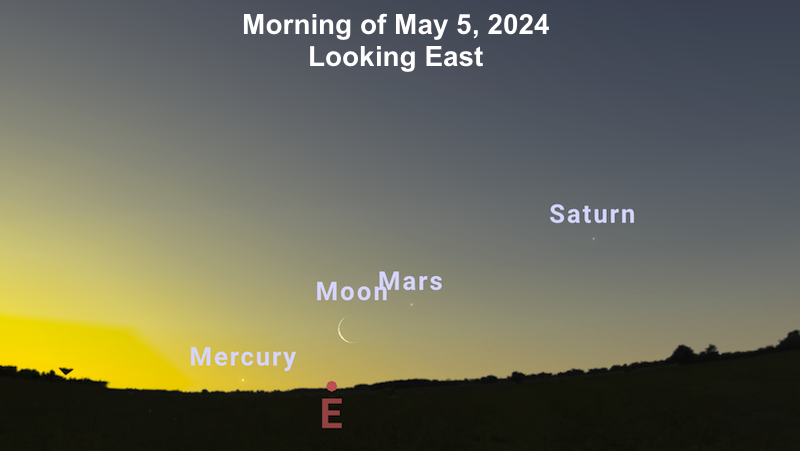 On the morning of May 5, the moon has waned to a thinner crescent, but it is still near the planets. Chart via Stellarium.org. Used with permission.May 5: Moon reaches perigee
On the morning of May 5, the moon has waned to a thinner crescent, but it is still near the planets. Chart via Stellarium.org. Used with permission.May 5: Moon reaches perigee
The moon will reach perigee – its closest point in its elliptical orbit around Earth – at 22 UTC (5 p.m. CDT) on May 5, 2024, when it’s 225,659 miles (363,163 kilometers) away.
May 6 morning: Moon near MercuryCan you still see the moon on the morning of May 6, 2024? If so, you might be able to find Mercury, too. They’ll both lie low on the horizon; binoculars might help locate them. Reddish Mars and golden Saturn will be higher in the sky.
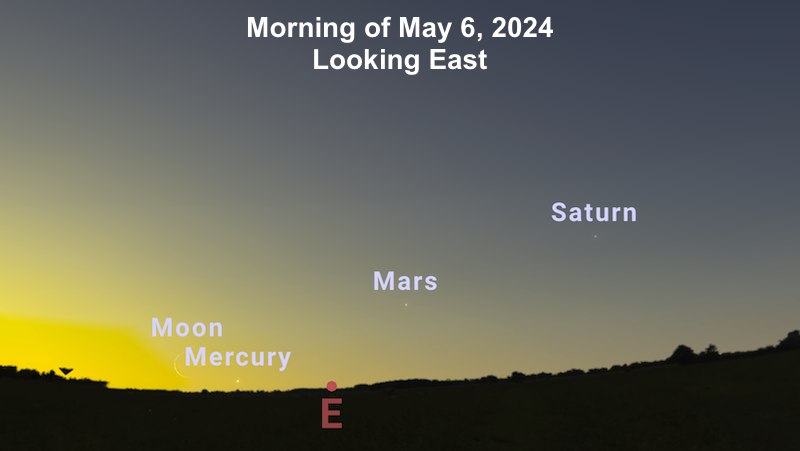 Chart via Stellarium.org. Used with permission.May 8: New moon
Chart via Stellarium.org. Used with permission.May 8: New moon
The instant of new moon will fall at 3:22 UTC on May 8, 2024 (10:22 p.m. CDT on May 7). That night is a perfect time for stargazing under dark skies.
Moon phases in May May 9: Mercury at greatest morning elongationMercury reaches its greatest elongation – 26 degrees – from the morning sun at 22 UTC (5 p.m. CDT) on May 9, 2024.
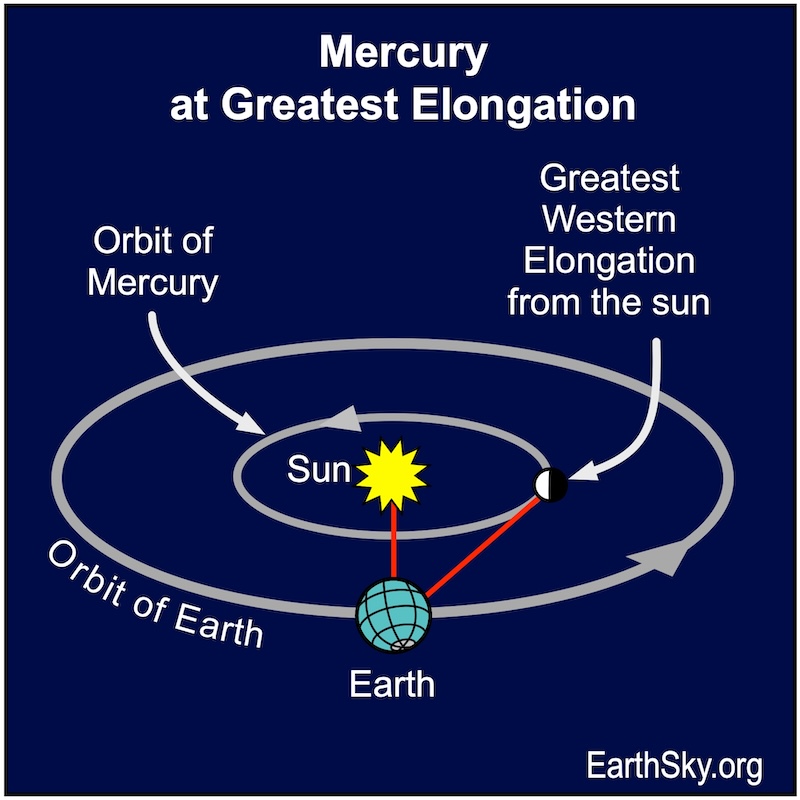 Chart via EarthSky.
Chart via EarthSky.Our charts are mostly set for the northern half of Earth. To see a precise view – and time – from your location, try Stellarium Online.
May 10 evening: Moon between Capella and BetelgeuseOn the evening of May 10, 2024, the waxing crescent moon – glowing with earthshine – will lie between two bright stars. The golden star is Capella in the constellation Auriga the Charioteer. And in vivid contrast to golden Capella is the bright red supergiant star Betelgeuse, the brightest star in Orion the Hunter. You can follow them until almost midnight.
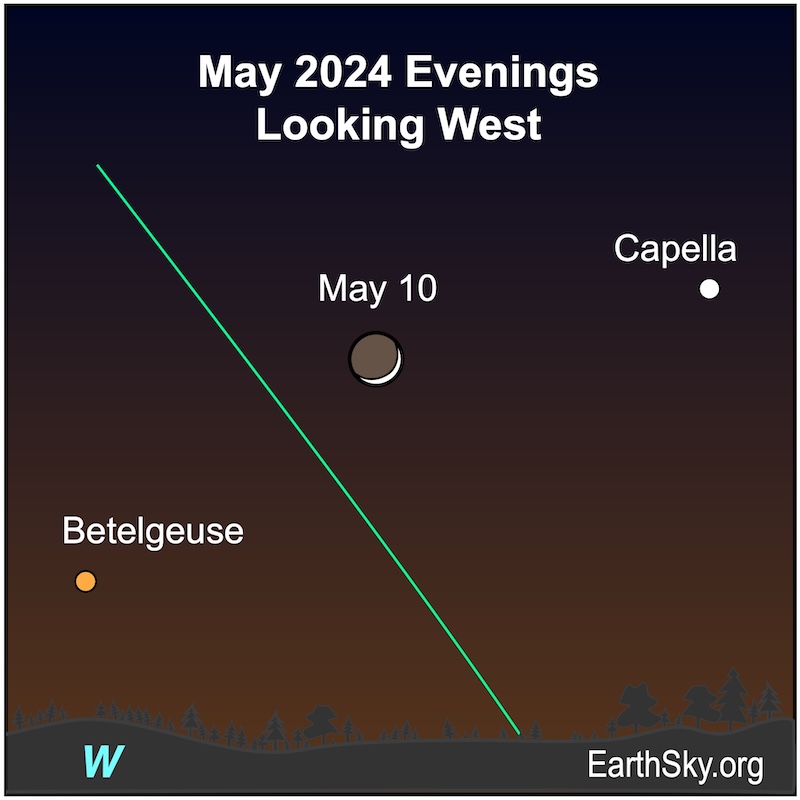 Chart via EarthSky.May 12 evening: Moon close to the twin stars of Gemini
Chart via EarthSky.May 12 evening: Moon close to the twin stars of Gemini
On the evening of May 12, 2024, the waxing crescent moon will shine near Pollux and Castor, the twin stars of Gemini. Even though they are known as twins, they really don’t look alike. Pollux is a bit brighter and it’s a golden star, while Castor is a white light. They’ll rise before sunset and travel across the sky’s dome before setting near midnight.
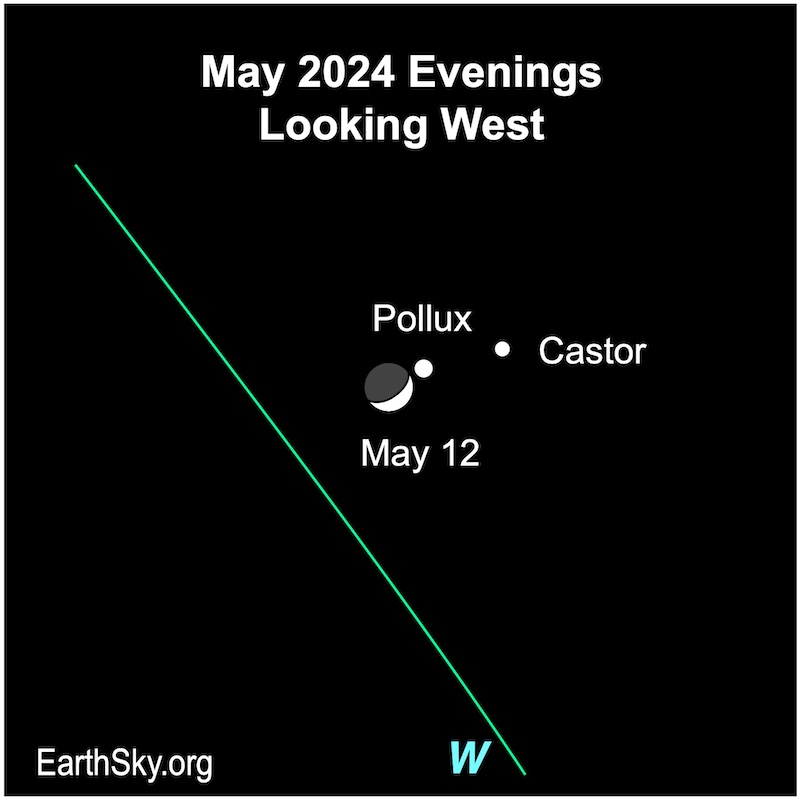 Chart via EarthSky.May 13 evening: Moon near Pollux and Castor and close to the Beehive
Chart via EarthSky.May 13 evening: Moon near Pollux and Castor and close to the Beehive
The thick waxing crescent moon will lie near M44, the Beehive star cluster, on the evening of May 13, 2024. You’ll need binoculars to spot dozens of the stars in the Beehive. Also nearby will be the bright twin stars of Gemini: Pollux and Castor. You can see them until around midnight.
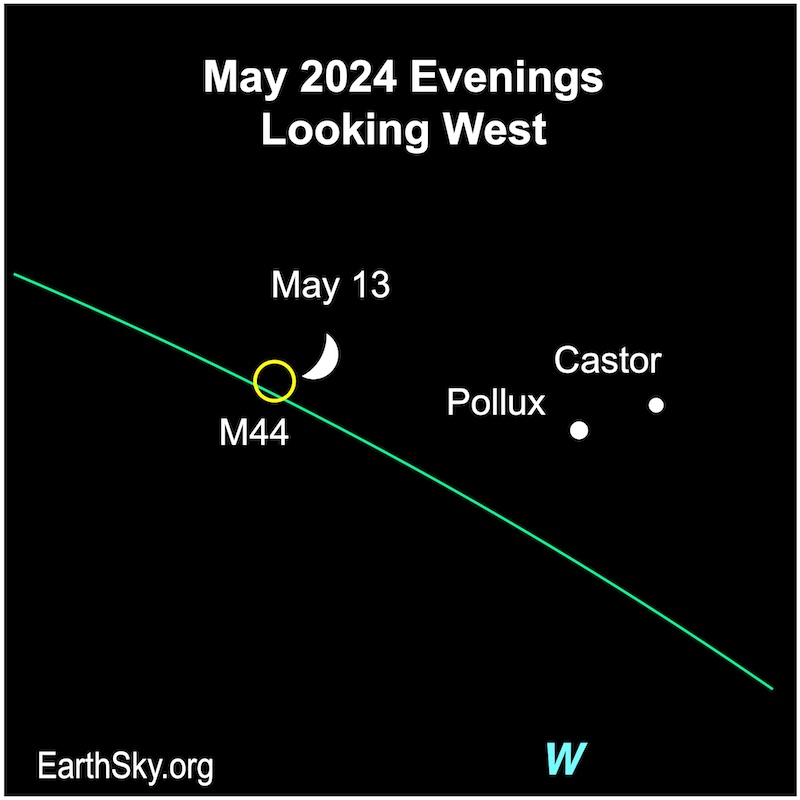 Chart via EarthSky.May 13 evening: Moon near Beehive binocular view
Chart via EarthSky.May 13 evening: Moon near Beehive binocular view
Through binoculars, two dozen stars can be spotted in the Beehive. The moon will glow in the binocular field’s upper right. This lovely open star cluster contains around 1,000 stars. The Beehive is located in the constellation of Cancer the Crab.
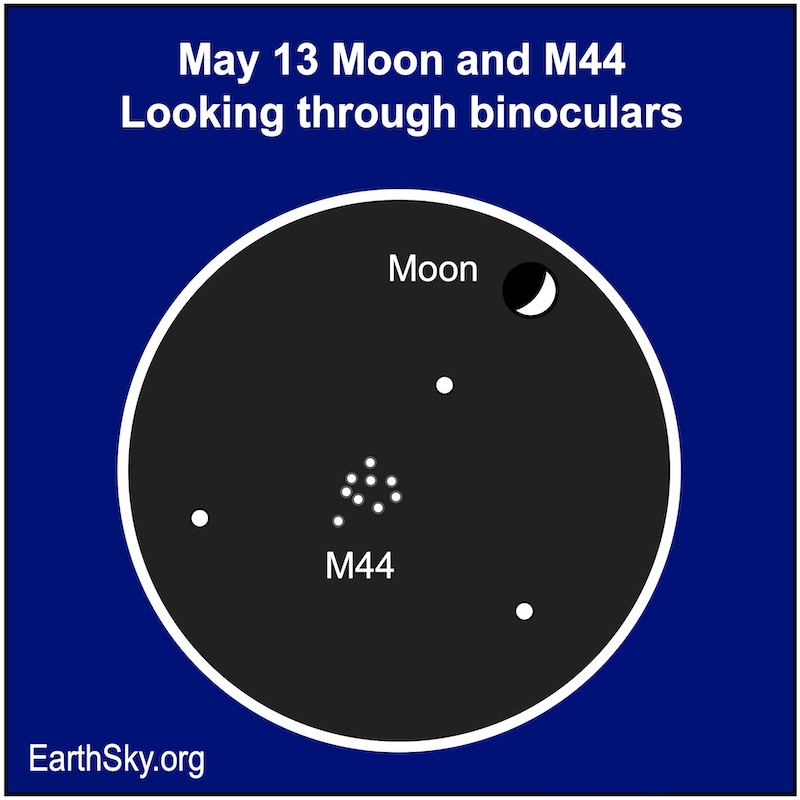 Chart via EarthSky.May 15: 1st quarter moon
Chart via EarthSky.May 15: 1st quarter moon
The instant of 1st quarter moon will fall at 11:48 UTC on May 15, 2024 (6:48 a.m. CDT). A 1st quarter moon rises around noon your local time and sets around midnight. Watch for it high in the sky at sundown.
Our charts are mostly set for the northern half of Earth. To see a precise view – and time – from your location, try Stellarium Online.
May 15 evening: Moon near RegulusOn the evening of May 15, 2024, the 1st quarter moon will hang near the bright star Regulus, the brightest star in Leo the Lion. They’ll be visible through a few hours after midnight.
 Chart via EarthSky.May 17: Moon reaches apogee
Chart via EarthSky.May 17: Moon reaches apogee
The moon will reach apogee – its farthest distance from Earth in its elliptical orbit around Earth – at 19 UTC (2 p.m. CDT) on May 17, 2024, when it’s 251,431 miles (404,640 kilometers) away.
May 18: Jupiter in conjunction with the sun
Jupiter will lie on the opposite side of the sun from Earth on May 18, 2024, and can’t be seen. This point in its orbit is called superior conjunction.
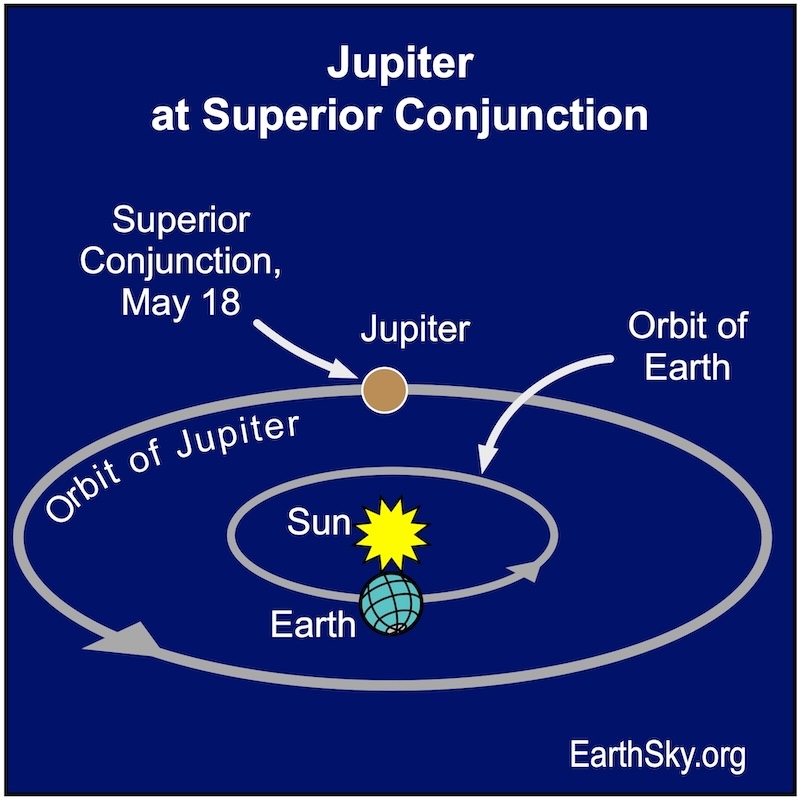 Chart via EarthSky.May 19 and 20 evenings: Moon near Spica
Chart via EarthSky.May 19 and 20 evenings: Moon near Spica
On the evenings of May 19 and 20, 2024, the fat waxing gibbous moon will hang near the bright star Spica in Virgo the Maiden. They’ll rise before sunset and be visible through several hours after midnight.
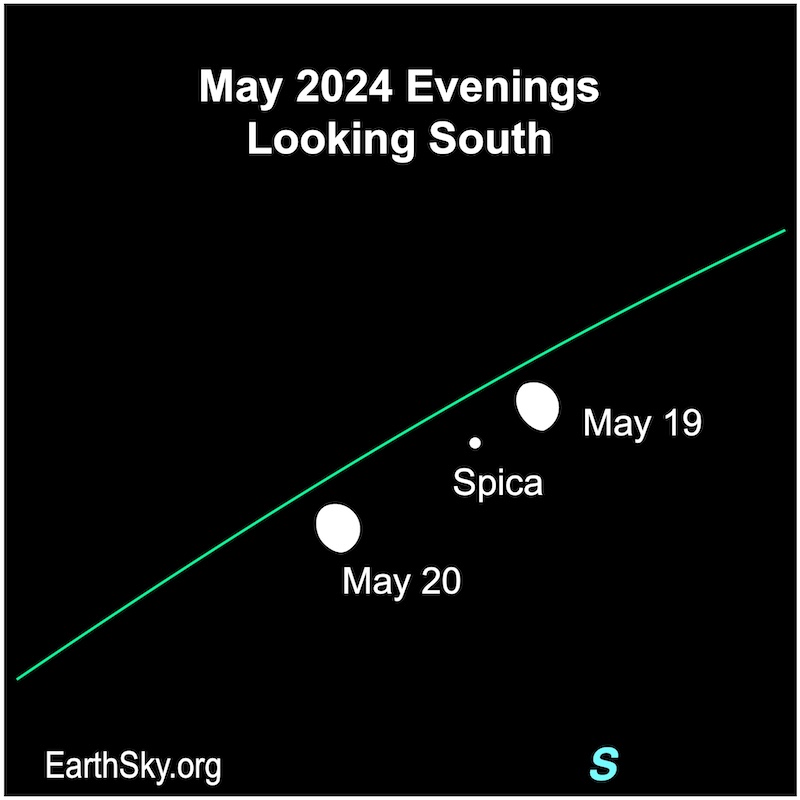 Chart via EarthSky.May 22 evening: Moon near Antares
Chart via EarthSky.May 22 evening: Moon near Antares
On the evening of May 22, 2024, the waxing gibbous moon will lie near the bright red star Antares in Scorpius the Scorpion. They’ll be visible from early morning until dawn.
 Chart via EarthSky.
Chart via EarthSky.Our charts are mostly set for the northern half of Earth. To see a precise view – and time – from your location, try Stellarium Online.
May 23: Full moonThe full moon will occur at 13:53 UTC (8:53 a.m. CDT) on May 23, 2024. It’ll be visible all night.
May 23: Full moon close to AntaresOn May 23, 2024, the bright red star Antares in Scorpius the Scorpion will lie close to the full moon. Full moon occurs at 13:53 UTC (8:53 a.m. CDT) on May 23, 2024. It’ll be visible all night. Also, sky watchers in the Americas, Western Africa and Middle Africa will see the moon pass in front of – or occult – Antares near 3 UTC on May 24. Other locations may see Antares very close to the limb of the moon.
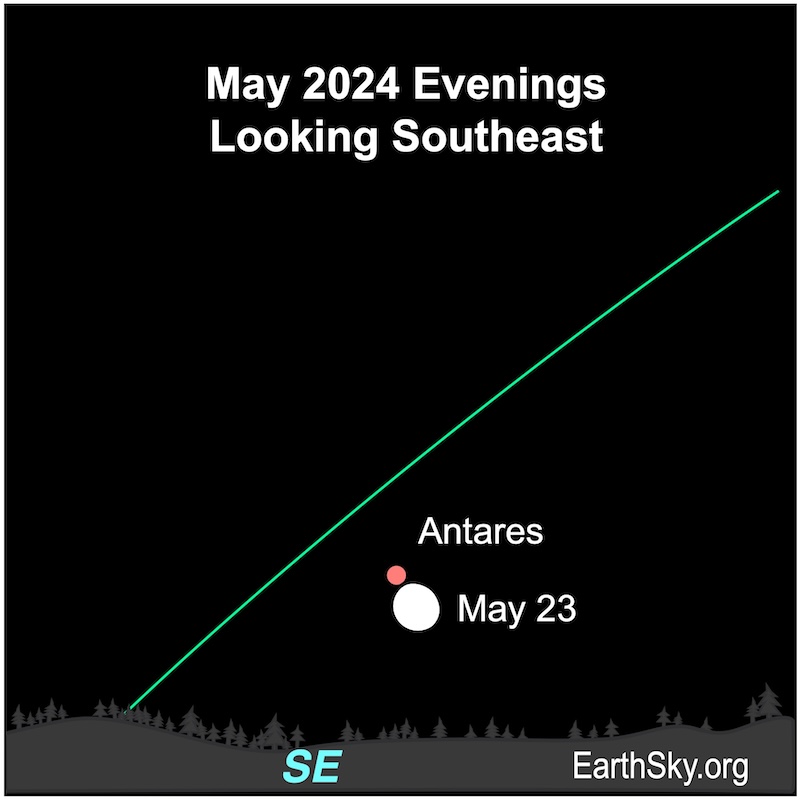 Chart via EarthSky.
Chart via EarthSky.Our charts are mostly set for the northern half of Earth. To see a precise view – and time – from your location, try Stellarium Online.
May 30: Last quarter moonThe instant of last quarter moon will fall at 17:13 UTC on May 30, 2024 (12:13 p.m. CDT). It’ll rise after midnight your local time and will set around noon. Look for it high in the sky before dawn.
Our charts are mostly set for the northern half of Earth. To see a precise view – and time – from your location, try Stellarium Online.
May 31 morning: Moon visits SaturnIn the early morning hours of May 31, 2024, the moon will hang very close to Saturn. Also, sky watchers in parts of Argentina, Chile, Brazil and Uruguay among others will see the moon pass in front of – or occult – Saturn near 8 UTC on May 31.
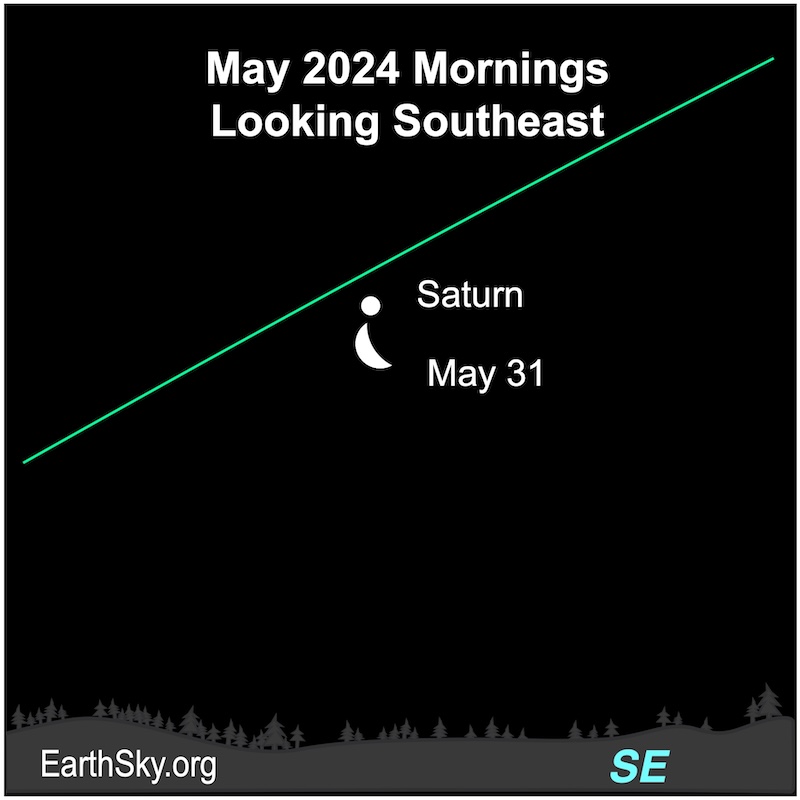 Chart via EarthSky.
Chart via EarthSky.The Bears and the Dippers
Ursa Major the Great Bear is home to the Big Dipper. The Big Dipper is an asterism – a well-known group of stars – not an official constellation. You’ll find the Big Dipper high overhead from mid-northern latitudes in the May evening skies. You can use the Big Dipper to find many stars and constellations. One important star to locate is Polaris, the Pole Star or North Star. The 2 outer stars – Dubhe and Merak known as The Pointers – in the bowl of the Dipper point to Polaris. Polaris marks the end of the handle of the Little Dipper. The Little Dipper is part of Ursa Minor the Lesser Bear.
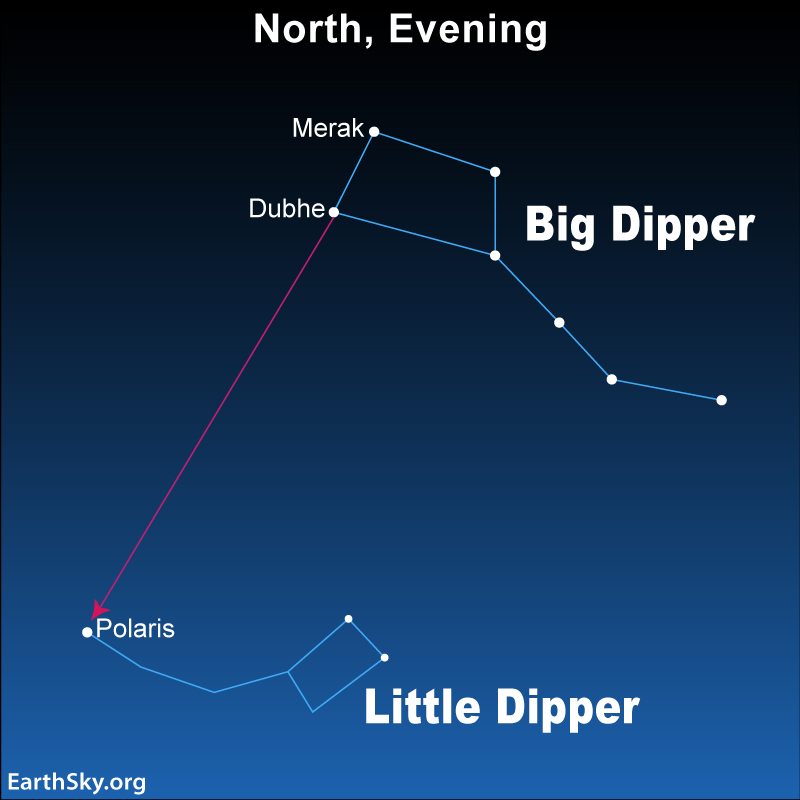 Chart via EarthSky.
Chart via EarthSky.Leo the Lion
Next, you can use the Big Dipper to locate Leo the Lion. Draw an imaginary line southward from the pointer stars in the Big Dipper – the two outer stars in the Dipper’s bowl – to point toward Leo the Lion. The brightest star in Leo is Regulus. Under darker skies, you’ll see Regulus is the punctuation mark of a backward question mark pattern of stars. That is known as the Sickle. It’s also an asterism and part of Leo the Lion.
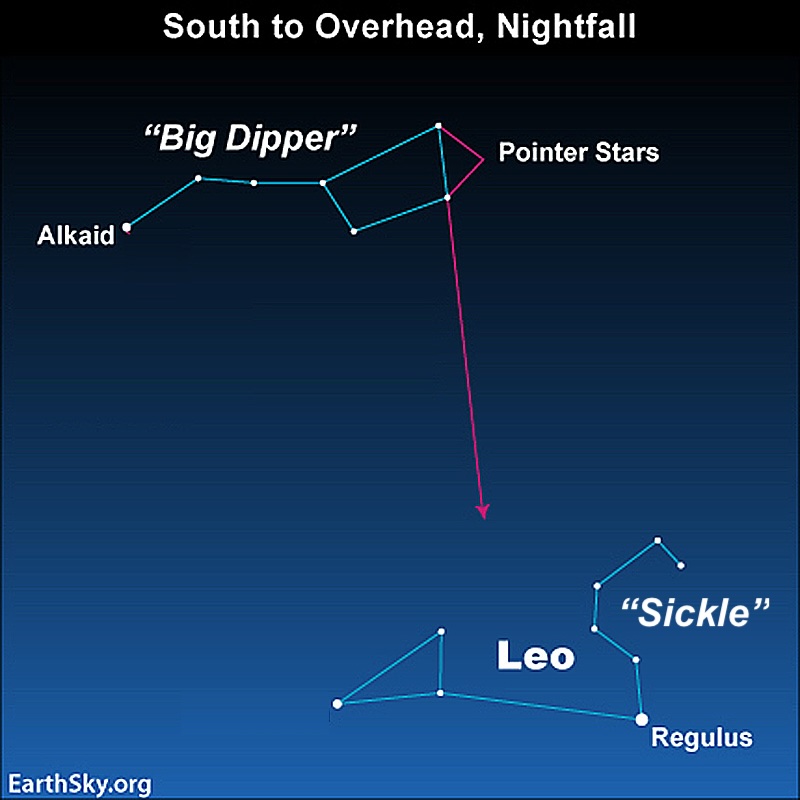 Chart via EarthSky.
Chart via EarthSky.Arcturus and Spica
You can also use the Big Dipper to locate the bright star stars Arcturus and Spica. Many stargazers know this mnemonic arc to Arcturus, and speed on to Spica.
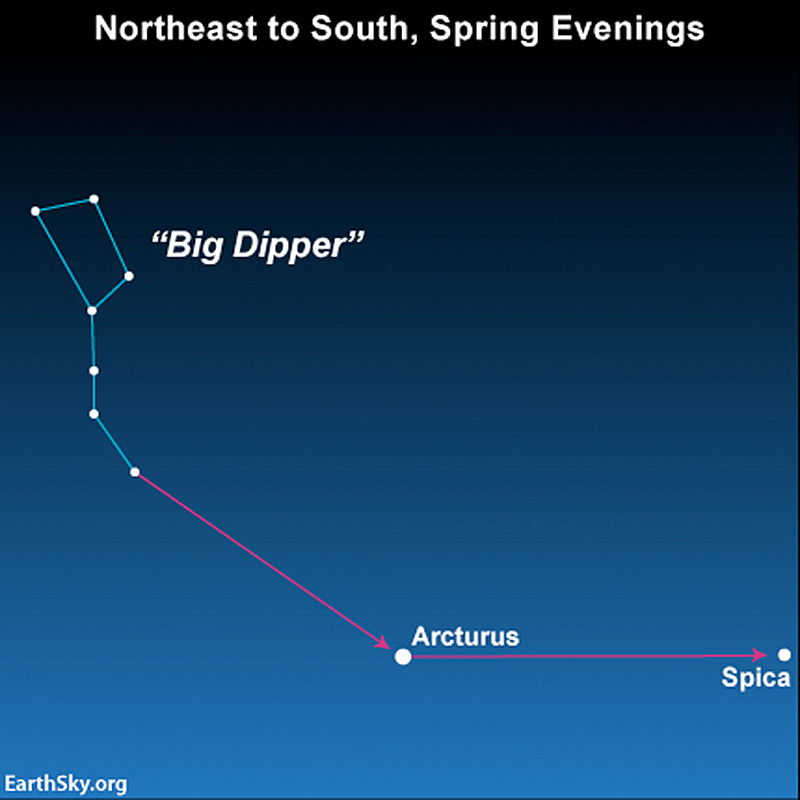 Chart via EarthSky.
Chart via EarthSky.Boötes the Herdsman
Arcturus is in the constellation Boötes the Herdsman. Boötes has the shape of a kite, and Arcturus is at the point where you’d attach a tail. You can see it on spring evenings in the Northern Hemisphere.
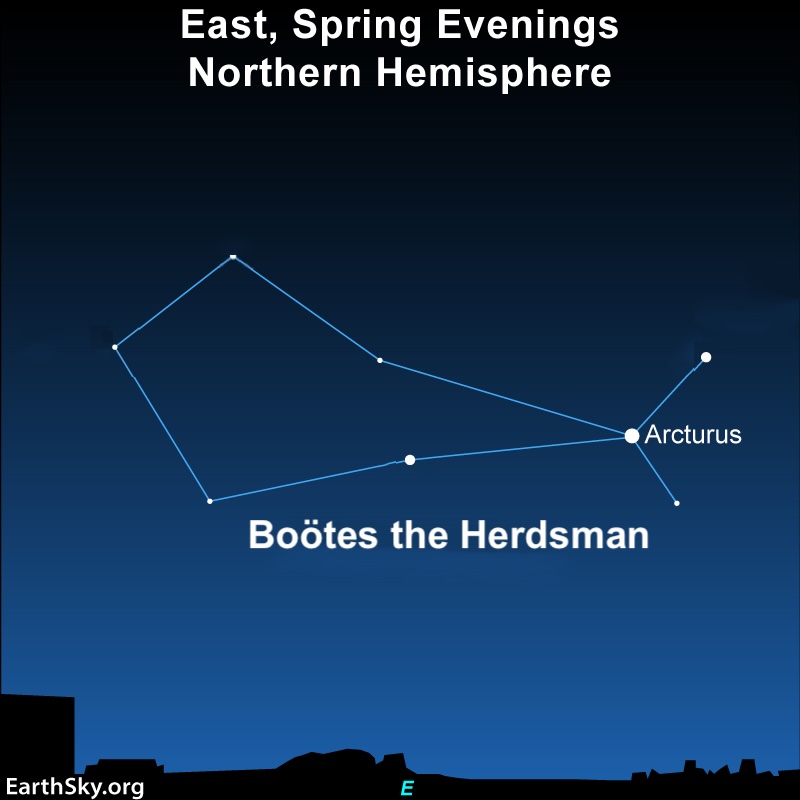 Chart via EarthSky.
Chart via EarthSky.Virgo the Maiden
The constellation Virgo the Maiden is easy to find by using the handle of the Big Dipper to arc to Arcturus in Boötes, then speeding on (spiking down) to Spica, Virgo’s brightest star.
 Chart via EarthSky.
Chart via EarthSky.Have fun exploring the sky!
Visible planets in the May morning skyIn May 2024, look for this trio of planets in the morning sky. Mercury lies low in the morning twilight with Mars and Saturn lined up across the sky dome.
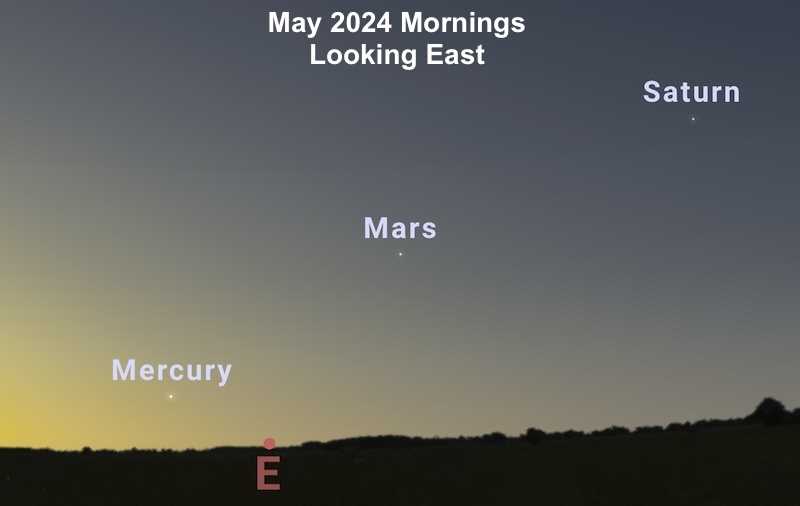 Chart via Stellarium.org. Used with permission.Mars and Saturn
Chart via Stellarium.org. Used with permission.Mars and Saturn
You can see Mars and Saturn before dawn in the morning sky in May. They’ll climb higher each day and drift apart as the month goes by. Both are shining around 1st magnitude. Notice they are different colors, Mars is reddish and Saturn is golden.
In May 2024, Mars will shine at magnitude 1.1, and its disk will reach 5 arc minutes diameter by month’s end. It’ll have a close visit from the waning crescent moon on May 4 and 5, 2024. An occultation on May 4 will be visible in areas including Madagascar, Mauritius, Reunion and Seychelles, among others. Mars spends the month in the dim constellation of Pisces the Fish. It’ll rise about 90 minutes before the sun on May 1 and will rise about two hours before the sun by month’s end.
Saturn begins and ends the month of May with close passes from the moon. They’ll pair up on May 3 and 31. And occultations are visible in the Southern Hemisphere on both May 3 and May 31. Saturn will be dimming slightly in May because its ring system is closing – they’ll be edge-on in 2025 – and it’s getting farther from Earth. You can still notice an interesting comparison – in color and brightness – between Saturn and Mars throughout May. However, the two planets will grow farther apart as the month passes. Saturn spends the month in the faint constellation of Aquarius the Water Bearer. It’ll rise about two hours before the sun on May 1 and will rise about three hours before the sun by month’s end.
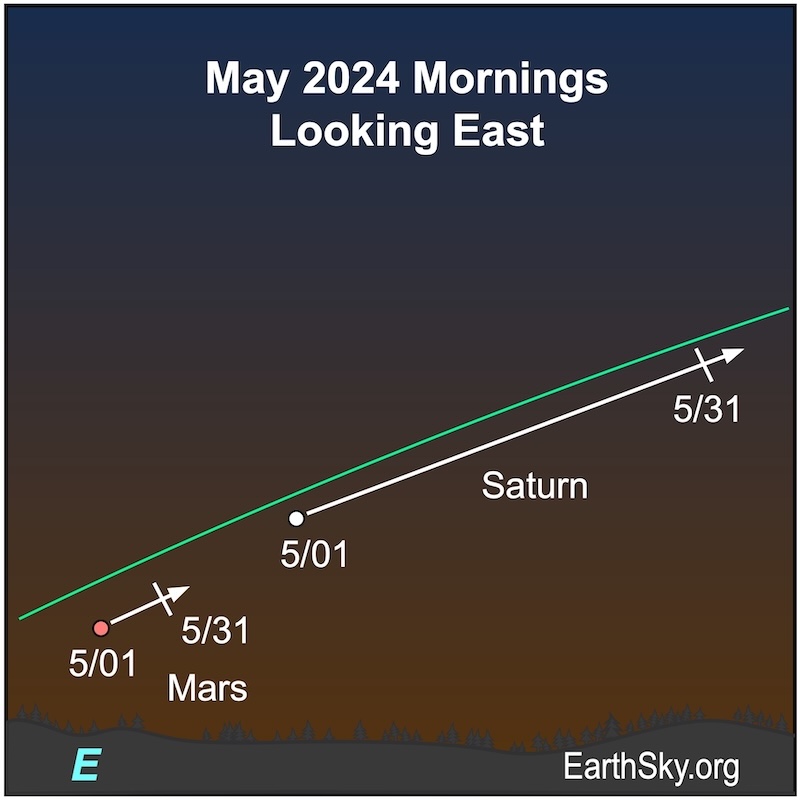 Chart via EarthSky.Mercury
Chart via EarthSky.Mercury
Mercury climbs higher further from the morning sun through May 9, 2024, when it reaches its greatest morning elongation and is 26 degrees from the sun. It’ll be shining at magnitude 0.6. It’ll continue to brighten a bit for the rest of the month until it slips from view. This will be the best morning apparition of 2024 for Southern Hemisphere observers. Mercury spends most of its time this month in the dim constellation of Pisces the Fish. It’ll rise about 45 minutes before the sun on May 1 and will rise about 30 minutes before the sun by month’s end. You might also spot Mars higher in the sky in the morning twilight.
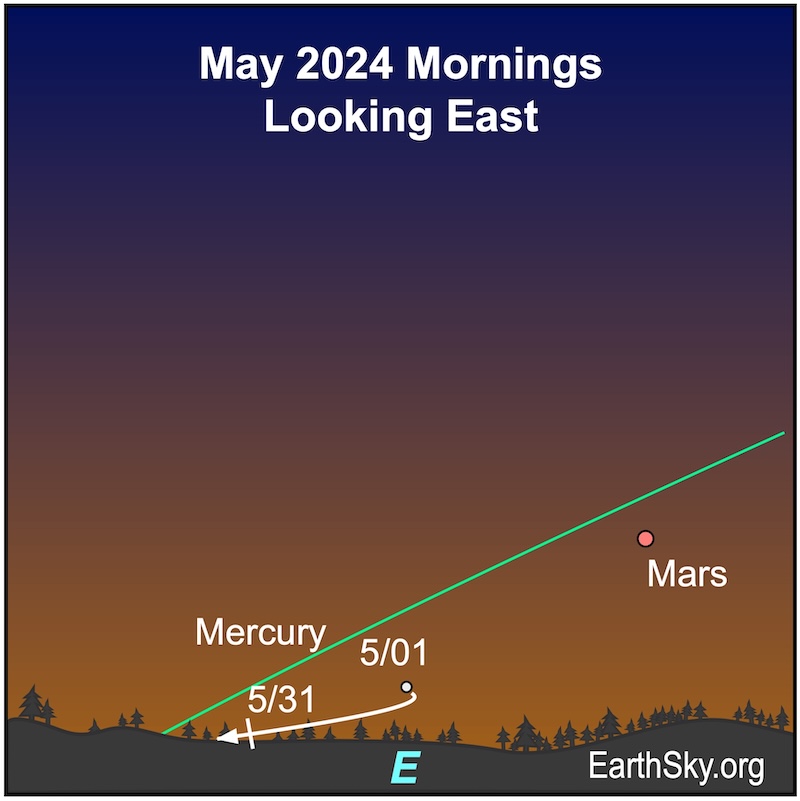 Chart via EarthSky.Where are Venus and Jupiter?
Chart via EarthSky.Where are Venus and Jupiter?
Both Venus and Jupiter are too close to the sun to be visible this month. Venus will emerge in the evening sky around the beginning of August. And Jupiter will emerge in the morning sky by early August.
Our charts are mostly set for the northern half of Earth. To see a precise view – and time – from your location, try Stellarium Online.
Thank you to all who submit images to EarthSky Community Photos! View community photos here. We love you all. Submit your photo here.
Looking for a dark sky? Check out EarthSky’s Best Places to Stargaze.
Sky dome maps for visible planets and night skyThe sky dome maps come from master astronomy chart-maker Guy Ottewell. You’ll find charts like these for every month of 2024 in his Astronomical Calendar.
Guy Ottewell explains sky dome maps
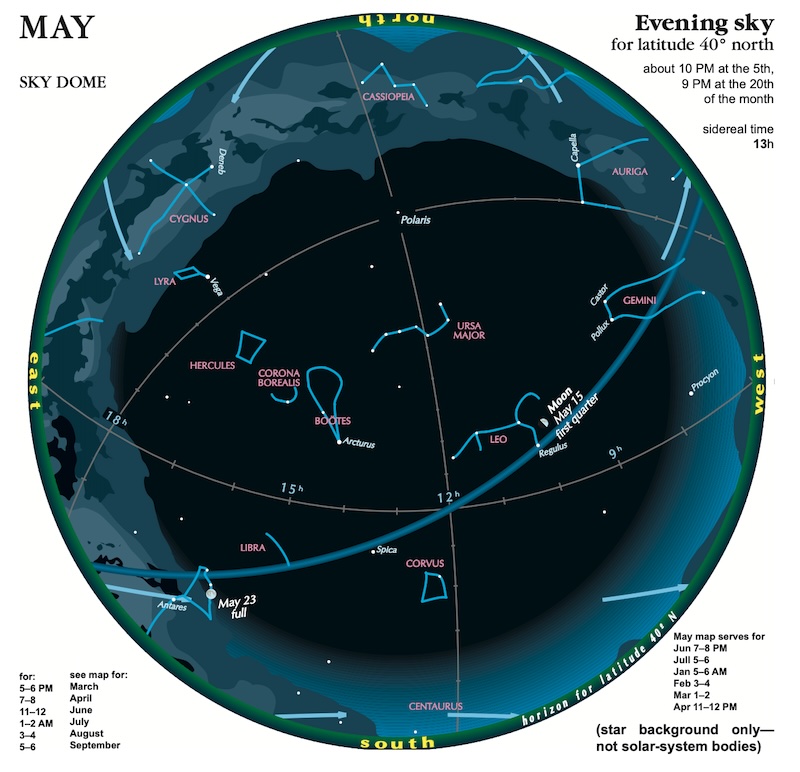 Here is the sky dome view for May 2024. It shows what is above the horizon at mid-evening for mid-northern latitudes. The view may vary depending on your location. Image via Guy Ottewell’s 2024 Astronomical Calendar. Used with permission.Heliocentric solar system visible planets and more
Here is the sky dome view for May 2024. It shows what is above the horizon at mid-evening for mid-northern latitudes. The view may vary depending on your location. Image via Guy Ottewell’s 2024 Astronomical Calendar. Used with permission.Heliocentric solar system visible planets and more
The sun-centered charts come from Guy Ottewell. You’ll find charts like these for every month of 2024 in his Astronomical Calendar.
Guy Ottewell explains heliocentric charts.
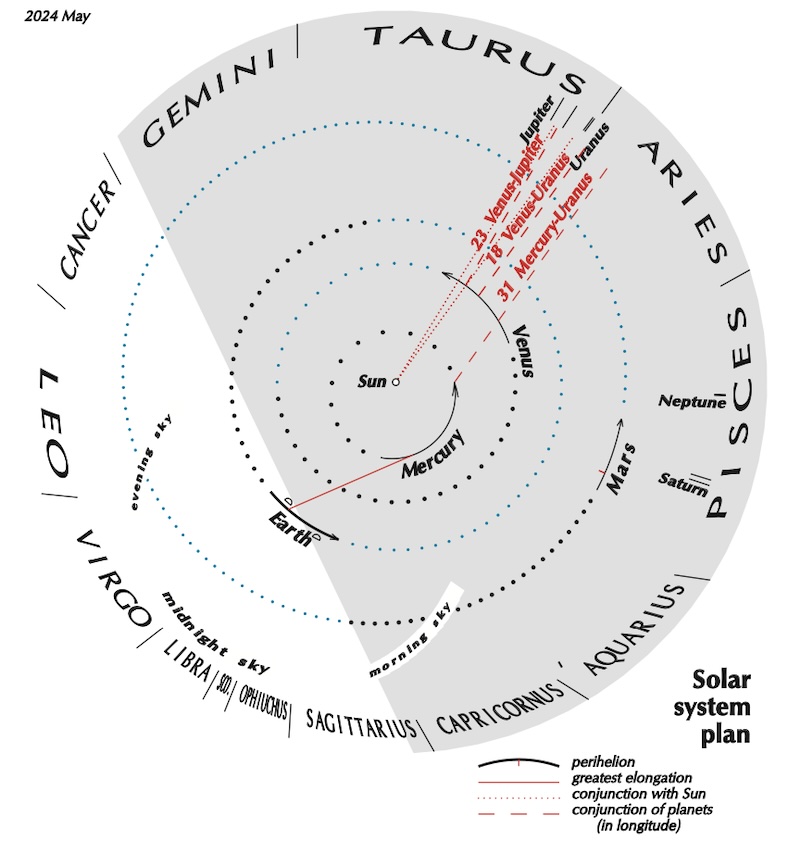 Heliocentric view of solar system, May 2024. Chart via Guy Ottewell’s 2024 Astronomical Calendar. Used with permission.Some resources to enjoy
Heliocentric view of solar system, May 2024. Chart via Guy Ottewell’s 2024 Astronomical Calendar. Used with permission.Some resources to enjoy
For more videos of great night sky events, visit EarthSky’s YouTube page.
Watch EarthSky’s video about Two Great Solar Eclipses Coming Up
Don’t miss anything. Subscribe to daily emails from EarthSky. It’s free!
Visit EarthSky’s Best Places to Stargaze to find a dark-sky location near you.
Post your own night sky photos at EarthSky Community Photos.
Translate Universal Time (UTC) to your time.
See the indispensable Observer’s Handbook, from the Royal Astronomical Society of Canada.
Visit Stellarium-Web.org for precise views from your location.
Almanac: Bright visible planets (rise and set times for your location).
Visit TheSkyLive for precise views from your location.
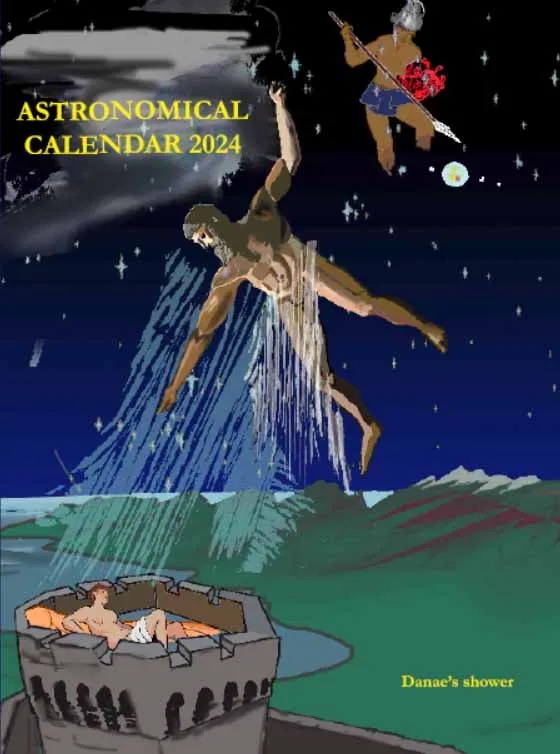 Attention amateur astronomers! Guy Ottewell’s popular and informative Astronomical Calendar for 2024 is available in both electronic and printed versions.
Attention amateur astronomers! Guy Ottewell’s popular and informative Astronomical Calendar for 2024 is available in both electronic and printed versions.Bottom line: Visible planets and night sky guide for May 2024. It is time to see some meteors! The Eta Aquariid meteor shower peaks this weekend and the best mornings to watch are May 5 and 6. Plus, if you are in the Southern Hemisphere, you will see more meteors.
The post Visible planets and night sky guide for May first appeared on EarthSky.
Channel: MrMBB333
You can SEE it!
Thanks for watching, be safe out there.
Become a member: https://www.youtube.com/channel/UCaVp-iXRPfiSxbkhmi56IHQ/join
You have something to share? Go to my official website click on red banner upload all there.
Official website: https://www.mrmbb333.com
Follow me on these other platforms:
X ~ mrmbb333
TikTok ~ https://www.tiktok.com/@mrmbb333
Instagram ~ https://www.instagram.com/mrmbb333/
Facebook ~ mrmbb333
If you want to send me something here's my PO BOX Address:
MRMBB333
2487 S. Gilbert Rd,
Ste 106 - 167
Gilbert, AZ 85295
BUSINESS INQUIRIES: mike@MrMBB333.com
#MrMBB333 #Earthwatchman
Video length: 8:01
Category: Entertainment
563 comments
Channel: Anonymous Official
WATCH - It Begins... Something VERY strange is happening in America EVENTS WORLD NEWS
Have you noticed so many strange things going on lately?
Find more @JasonAChannel
Thanks for watching!
Subscribe - https://youtube.com/anonymous
Website - https://anon.news
Instagram - https://instagram.com/anonymous
Twitter - https://twitter.com/anonymousofcl
Facebook - https://www.facebook.com/anonymousdirect
Please SHARE this as widely as you feel drawn...
Content licensed
Related
Unexplained And Unsettling Encounters That Will Deprive You Of Sleep
The Most Unexplained Places You Won't Believe Actually Exist
Mind Blowing Phenomena Viewers Are Struggling To Explain
The Most Mind Blowing Videos Of 2023
Keywords
end times productions message strange truth world news current events 2024 today this week this month motivation unexplained mind blowing
@EndTimesProductions @-anonymous
Video length: 18:04
Category: Education
464 comments
Channel: MrMBB333
Sure seems like they are looking for something important!
Thanks for watching, be safe out there.
Become a member: https://www.youtube.com/channel/UCaVp-iXRPfiSxbkhmi56IHQ/join
You have something to share? Go to my official website click on red banner upload all there.
Official website: https://www.mrmbb333.com
Follow me on these other platforms:
X ~ mrmbb333
TikTok ~ https://www.tiktok.com/@mrmbb333
Instagram ~ https://www.instagram.com/mrmbb333/
Facebook ~ mrmbb333
If you want to send me something here's my PO BOX Address:
MRMBB333
2487 S. Gilbert Rd,
Ste 106 - 167
Gilbert, AZ 85295
BUSINESS INQUIRIES: mike@MrMBB333.com
#MrMBB333 #Earthwatchman
Video length: 8:17
Category: Entertainment
427 comments
Channel: Anonymous Official
"Something is Definitely Happening on Earth.." | Joe Rogan
Joe Rogan, navigates through a labyrinth of unsettling truths, conspiracies, and existential ponderings. With a blend of skepticism and openness, he reflects on the surreal nature of the world we inhabit, veering into discussions about conspiracy theories, religion, and the possibility of extraterrestrial involvement in human affairs.
Joe Rogan reminisces about Antarctica, the southernmost continent and site of the South Pole, is a virtually uninhabited, ice-covered landmass.
Newsletter (Subscribe):
https://anon.news
Clip taken from JRE
Listen to the Joe Rogan Experience on Spotify
Discussed in this video:
Watch Now before they get to me. | with Joe Rogan
we have 8 days left | with Joe Rogan
Watch NOW before they silence me. | with Joe Rogan
this will AFFECT everyone in 1-2 weeks. | with Joe Rogan
#joerogan #jreclips #podcast #joeroganpodcast #jre
joe rogan ufo
Video length: 18:12
Category: Education
253 comments
This article is yet another example of how PFAS ‘forever chemicals’ are contaminating lands, especially those used for agriculture. In this case, human waste-based fertilizer was applied in neighboring lands, and the runoff supposedly has caused animals to die and land ‘useless’… The fertilizer maker says its products are safe, and that the government supports […]
The post ‘This is Chernobyl’: Texas ranchers say ‘forever chemicals’ in waste-based fertilizers ruined their land appeared first on Strange Sounds.
Tyrannosaurus rexes were mighty dinosaurs with massive skulls, scaly skin, foot-long teeth and tiny arms. They were terrifying carnivores, living in what’s now western North America more than 66 million years ago. T. rexes were among the deadliest of dinosaurs. But were they smart? A study in 2023 claimed that a T. rex could be as smart as a baboon. But a new study disputes that idea, asserting that T. rexes weren’t smart, after all, and behaved more like crocodiles and lizards.
The 2023 study was based on what are called neuron counts, that is, on the number of neurons in the brains of T. rex and other animals. Neuron counts have been used to gain insights into the intelligence of some species. For example, the human brain contains 86 billion neurons, with 16 billion neurons in the cerebral cortex, which plays a key role in things like attention, perception, awareness, thought, memory, language, and consciousness.
But what about T. rex?
The new study considered neuron counts, and on a re-examination of brain sizes and structures in dinosaurs. It was published in the peer-reviewed journal The Anatomical Record on April 26, 2024.
Tyrannosaurus rex studies in 2023 vs. 2024 Animatronic Tyrannosaurus rex at the Natural History museum, London, United Kingdom. Image via Amy-Leigh Barnard/ Unsplash.
Animatronic Tyrannosaurus rex at the Natural History museum, London, United Kingdom. Image via Amy-Leigh Barnard/ Unsplash.In last year’s study, associate professor of psychology at Vanderbilt University Suzana Herculano-Houzel found the T. rex had between 2 and 3 billion neurons. Herculano-Houzel said these neuron counts – comparable to those of baboons – could directly inform on the intelligence of T. rex. She suggested T. rex might be able to pass on knowledge to their young. They might even be able to use tools. Can you imagine? If the idea of a huge predator that used to walk Earth wasn’t terrifying enough, picture them hunting in packs, teaching their descendants and using tools … Goosebumps!
However, an international team of paleontologists, behavioral scientists and neurologists conducted a new study on the brain size and structure of the Tyrannosaurus rex, among other things. The team concluded that these dinos were as smart as reptiles – such as crocodiles and lizards – but not as smart as monkeys. They found the T. rex brain size had been overestimated – especially the forebrain – and that the 2023 estimates of neuron counts for T. rexes were likely way off base.
But how can we reconstruct the biology of an animal that went extinct millions of years ago? The new study doesn’t just focus on the skull of these creatures. A further analysis of the rest of the skeleton, the bone histology, fossils and the descendants of these animals were also taken into account. Team member Hady George of the University of Bristol wrote:
Determining the intelligence of dinosaurs and other extinct animals is best done using many lines of evidence ranging from gross anatomy to fossil footprints, instead of relying on neuron number estimates alone.
How to study an extinct animal?Herculano-Houzel clearly didn’t have a T. rex brain in front of her to study. So, she analyzed the brains of evolutionary descendants of the dinosaurs, such as modern birds, reptiles and turtles. She then compared the results with fossilized brain cases of ancient lizards. She concluded that dinosaurs were as smart as monkeys, because their neuron counts were equivalent to that of some intelligent primates, such as baboons. But neuron count estimates are not a reliable guide to intelligence.
Another thing to consider is whether or not brain tissue fills the entire skull. Team member Cristian Gutiérrez-Ibáñez of the Department of Biological Sciences, University of Alberta, noted the actual brains inside T. rex skulls were much more related to modern crocodiles than birds. And it turns out that crocodiles have big skulls but they contain a significant amount of fluid and other tissue. Only 30% of a croc’s skull contains grey matter.
In addition to this, bird brains are denser, neuron-wise, than reptile brains. So, are 2 billion neurons in a small body the same as in a big body? The answer is no. A big body needs a big brain because it has a lot more body to operate. Gutiérrez said:
It’s clear larger animals need more neurons.
Are brain size and intellect connected?According to Gutiérrez, more neurons doesn’t necessarily mean smarter. For example, giraffes also possess around 2 billion neurons, but they don’t pass on knowledge or use tools. There are other animals that are much smaller, have fewer neurons and can learn tricks (crows), teach their young (ants), repeat what they see or hear from humans (parrots or cockatiels), and even prepare funerals (magpies).
But how can we know for sure how smart T. rex was? Fossils provide some indications on how dinosaurs lived. They tell us that T. rex parents were protective of their young and lived in groups, for example. But there will always be a limitation to what we can know. Gutierrez said:
That’s the one thing that isn’t going to be fossilized … behavior.
Bottom line: We all know Tyrannosaurus rex dinosaurs: they’re huge with scaly skin, big teeth and tiny arms. But how much do we know about their brains? A new study says they weren’t quite as smart as monkeys and were more like crocodiles.
T. rex not as smart as previously claimed, scientists find
New U of A research questions T. Rex intelligence, culture-building
The post Tyrannosaurus rex not so smart, after all first appeared on EarthSky.
Relentless storms bring flooding rains to southern Brazil. pic.twitter.com/MydBPgILRY
— CIRA (@CIRA_CSU) May 1, 2024
Relentless rains have brought horrendous flooding to the Brazilian state of Rio Grande do Sul. Read more about the Brazil floods below. Image via CIRA.
The state of Rio Grande do Sul in Brazil has experienced historic flooding over the past week. At least 29 people have died in the floods with 60 more missing. The governor of the state, Eduardo Leite, called it a “war situation” in his request for help. The city of Lajeado suffered an especially devastating blow, with the Taquari River a full 13 feet (4 meters) above its previous record flood stage from 1941. As you can see in the images here, the 111 feet (34 meters) of floodwaters have covered most of the city.
On May 2, 2024, the military in Brazil reported the partial collapse of a dam on the Rio das Antas. It recommended residents of Santa Tereza near the local rivers leave the area as quickly as possible. In some locations, helicopters have rescued people from the roofs of their homes.
The Brazilian state of Rio Grande do Sul is experiencing some of its worst flooding in its history after days of relentless, torrential rain.
In the last four days of April, the state received about 70% of the precipitation it typically records for the entire month. The Taquari… pic.twitter.com/Ko1UQYTeEc
— Nahel Belgherze (@WxNB_) May 2, 2024
Cidade de Lajeado debaixo d’água. pic.twitter.com/tsQiG2LWmB
— Rafael Gloves (@rafaelgloves) May 2, 2024
South of Brazil is living the worst flood of history. At the city of Lajeado (video below) the river height surpassed the record of 100 feet high from 1941 and 2023. God bless our people. pic.twitter.com/WM9dhXdumv
— Rony Vernet ?? (@RonyVernet) May 2, 2024
Dire situation in Brazil
Massive flood due to heavy rains in Três Coroas of Rio Grande do Sul, Brazil ?? (02.05.2024)
TELEGRAM JOIN ? https://t.co/9cTkji5aZq pic.twitter.com/H2z11WFKkA
— Disaster News (@Top_Disaster) May 2, 2024
Não sabemos de qual cidade é, mas a situação é extremamente grave no Rio Grande do Sul.
A população do RS precisa de ajuda ? pic.twitter.com/shnAhrwnIr
— TEMPO OESTE (@TempoOeste) May 2, 2024
The translation of the post below says:
Taquari Bridge.
One of the most important bridges connecting the interior of the state of RS to the capital, the Taquari River bridge on BR386 currently has water at its edge.
In the images, photos of the bridge now, morning of May 2 and the comparison of the distance from the waters on a normal day.
PONTE DO TAQUARI.
Uma das mais importantes pontes de ligação do interior estado do RS a capital, a ponte do Rio Taquari na BR386 está nesse momento com água no beiral.
Nas imagens, fotos da ponte agora, manhã de 2/05 e o comparativo da distância das águas em dia normal. pic.twitter.com/fzDjw1UrX8
— Sheila Melgarejo/ Conta Nova (@sheilamelgare12) May 2, 2024
Other floods around the world
Brazil is not alone in suffering from floods at the moment. In Europe, areas in Germany and the Netherlands are also dealing with flooding.
#Unwetter #Zollernalbkreis #Bisingen pic.twitter.com/7MNrU7hFSS
— Stolz auf ?? (@derschaumkuss) May 2, 2024
In the Middle East, places such as Oman and Iran also had floodwaters sweep into cities.
???? ?????? ????? ??????? ?? ????? ??????? ?? pic.twitter.com/zrGZZg3mwy
— ????? ??? ?????? (@WordGateWeather) May 2, 2024
And in southeastern Texas, one driver tried to navigate through a flooded parking lot but accidentally drove into a creek. Remember when you encounter a flooded road: Turn around, don’t drown. Fortunately she was okay.
Watched this poor girl drive into the creek right behind our building in College Station. Good news is she's ok. This is why you ALWAYS turn around, don't drown. pic.twitter.com/c6SpergaBy
— Ryan Star (@onairryan) May 2, 2024
Bottom line: Brazil floods have inundated the state of Rio Grande do Sul, with houses washed away and rescues ongoing. Floods have been raging in other parts of the world as well.
Read more: Extreme rainfall and flooding as Earth warms
The post Brazil floods engulf state of Rio Grande do Sul first appeared on EarthSky.
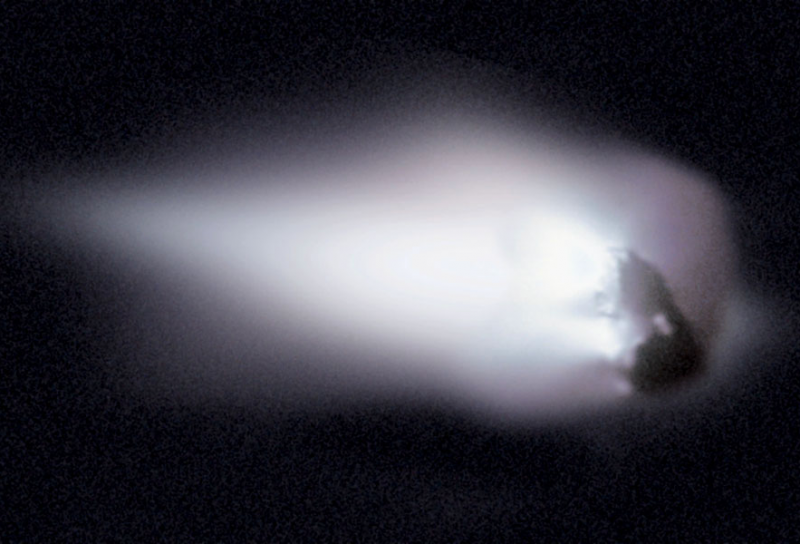 View larger. | The Halley Multicolor Camera on ESA’s Giotto spacecraft captured this image of the nucleus of Comet Halley. This image was the Astronomy Picture of the day for January 4, 2010.Comet Halley visited last in 1986
View larger. | The Halley Multicolor Camera on ESA’s Giotto spacecraft captured this image of the nucleus of Comet Halley. This image was the Astronomy Picture of the day for January 4, 2010.Comet Halley visited last in 1986
The famous comet 1P/Halley – aka Halley’s Comet – swings into the inner solar system about every 76 years. At such times, the sun’s heat causes the comet to loose its icy grip over its mountain-sized conglomeration of ice, dust, and gas. And so, at each pass, the crumbly comet sheds a fresh trail of debris into its orbital stream. It lost about 1/1,000th of its mass during its last flyby, in 1986. And it so happens we intersect Comet Halley’s orbit not once, but twice each year. That’s why – although the comet itself is nowhere near – Halley’s Comet is the parent of not just one, but two well-known annual meteor showers, one in May and one in October.
In early May, we see bits of this comet as the annual Eta Aquariid meteor shower.
Then some six months later, in October, Earth in its orbit again intersects the orbital path of Comet Halley. This time around, these broken-up chunks from the comet burn up in Earth’s atmosphere as the annual Orionid meteor shower.
And, by the way, Halley is pronounced like valley. According to Ian Ridpath:
Many people nowadays say “Hailey”, a legacy of the 1950s rock group Bill Haley and the Comets.
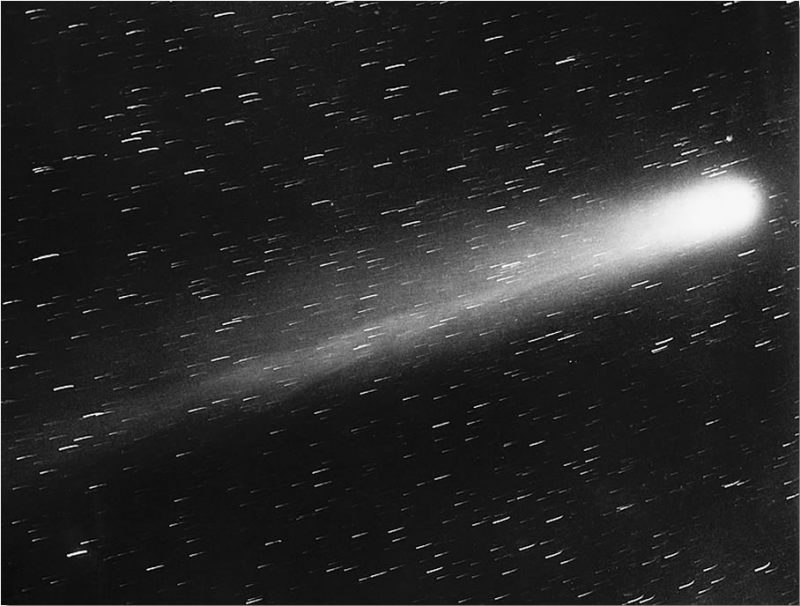 Compare this image to the one at top. Here’s how we saw Comet Halley on May 29, 1910. Image via Wikimedia Commons.
Comet debris litters Comet Halley’s orbit
Compare this image to the one at top. Here’s how we saw Comet Halley on May 29, 1910. Image via Wikimedia Commons.
Comet debris litters Comet Halley’s orbit
Because Halley’s Comet has circled the sun innumerable times over countless millennia, cometary fragments litter its orbit. That’s why the comet doesn’t need to be anywhere near the Earth or the sun in order to produce a meteor shower. Instead, whenever our Earth in its orbit intersects Comet Halley’s orbit, cometary bits and pieces – often no larger than grains of sand or granules of gravel – smash into Earth’s upper atmosphere, to vaporize as fiery streaks across our sky: meteors.
The diagrams below can help you visualize Earth’s orbit with respect to the path of Halley’s Comet.
 The path of Halley’s Comet intersects the earth’s orbit twice each year. In early May it produces the Eta Aquariid meteor shower (left) as the particles leave the inner solar system. Diagram via JPL Horizons Program.
The path of Halley’s Comet intersects the earth’s orbit twice each year. In early May it produces the Eta Aquariid meteor shower (left) as the particles leave the inner solar system. Diagram via JPL Horizons Program.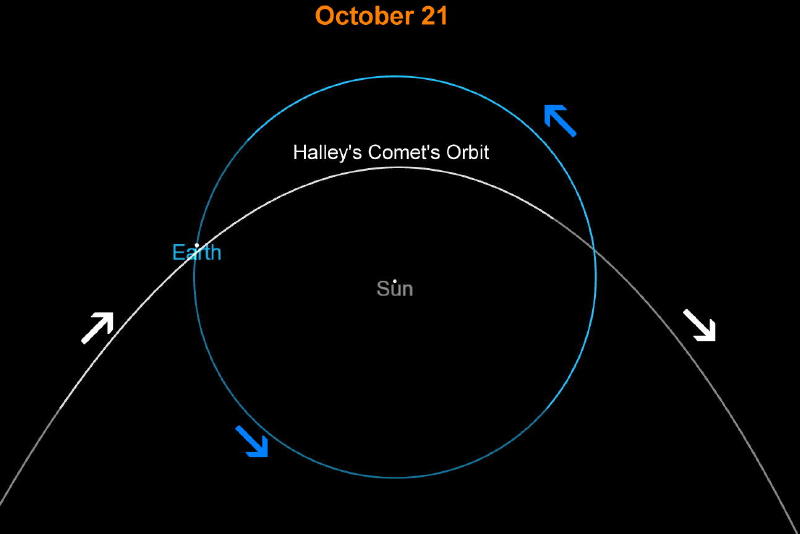 In mid-October, Comet Halley produces the Orionid meteor shower (right) as the particles enter the inner solar system. Diagram via JPL Horizons Program.
In mid-October, Comet Halley produces the Orionid meteor shower (right) as the particles enter the inner solar system. Diagram via JPL Horizons Program. The radiant point of the Eta Aquariid meteor shower is near the star Eta Aquarii in the constellation Aquarius the Water Bearer. The radiant rises in the wee hours after midnight and is still climbing toward its highest point – in the south as seen from the Northern Hemisphere – at dawn. It’s because we’re in a different part of our orbit – and have a unique perspective of the comet’s orbit – that the two meteor showers appear in different parts of the sky. See the illustration below. Chart via EarthSky.
The radiant point of the Eta Aquariid meteor shower is near the star Eta Aquarii in the constellation Aquarius the Water Bearer. The radiant rises in the wee hours after midnight and is still climbing toward its highest point – in the south as seen from the Northern Hemisphere – at dawn. It’s because we’re in a different part of our orbit – and have a unique perspective of the comet’s orbit – that the two meteor showers appear in different parts of the sky. See the illustration below. Chart via EarthSky. The Orionids radiate from a point near the upraised club of the constellation Orion the Hunter. The bright star near the radiant point is ruddy, somber Betelgeuse. You might catch an Orionid meteor any time between about September 26 to November 22. Chart via EarthSky.Where is Comet Halley now?
The Orionids radiate from a point near the upraised club of the constellation Orion the Hunter. The bright star near the radiant point is ruddy, somber Betelgeuse. You might catch an Orionid meteor any time between about September 26 to November 22. Chart via EarthSky.Where is Comet Halley now?
Often, astronomers like to give distances of solar system objects in terms of astronomical units (AU), which is the sun-Earth distance. Halley’s Comet lodges 0.587 AU from the sun at its closest point to the sun (perihelion) and 35.3 AU at its farthest point (aphelion).
In other words, at its farthest, Halley’s Comet resides about 60 times farther from the sun than it does at its closest.
It was last at perihelion in 1986, and will again return to perihelion in 2061.
In December of 2023, the comet reached its farthest point from the sun that binds it in orbit. Then – pulled inexorably by the sun’s gravity – it curved around and is heading back toward the inner solar system again. Comet Halley will be back in 2061.
So the comet is far away. Even so, meteoroids – bits of debris left behind in the comet’s orbit – swim throughout Halley’s Comet’s orbital stream. So each time Earth crosses the orbit of the comet, in May and October, these meteoroids turn into incandescent meteors once they plunge into the Earth’s upper atmosphere.
 A diagram of Halley’s Comet seen from above the solar system plane. Via Ian Ridpath. Used with permission.
A diagram of Halley’s Comet seen from above the solar system plane. Via Ian Ridpath. Used with permission.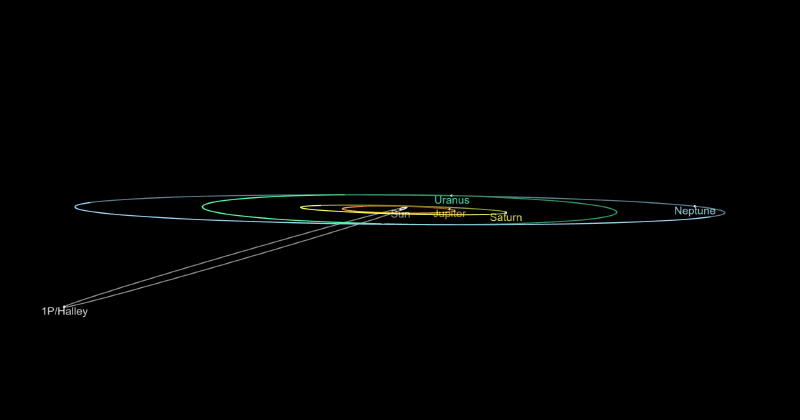 The orbit of Comet Halley. The comet does not stay in the same plane as the planets but is tilted 18 degrees and it revolves around the sun in the opposite direction as the planets. Diagram produced by JPL Horizons Program.Meteor showers and comets
The orbit of Comet Halley. The comet does not stay in the same plane as the planets but is tilted 18 degrees and it revolves around the sun in the opposite direction as the planets. Diagram produced by JPL Horizons Program.Meteor showers and comets
Of course, Halley’s Comet isn’t the only comet that produces a major meteor shower …
Three of the comets in the table below are each responsible for two meteor showers. We’ve already discussed Halley’s Comet. The asteroid 2004 TG10, responsible for the Northern Taurids, is part of the Taurid Complex, which includes Comet Encke, itself producing the Southern Taurids. And, asteroid 2003 EH1, responsible for the Quadrantids appears to be part of the Machholz Complex, which also includes Comet 96P/Machholz, itself producing the Delta Aquariids.
| Meteor Shower | Parent Comet | Peak Date | Orbital Period | Perihelion | Aphelion |
| Quadrantids | 2003 EH1 (asteroid | Jan 4 | 5.52 yrs | 1.19 AU | 5.06 AU |
| Lyrids | Comet Thatcher (1861 G1) | Apr 23 | 413 yrs | 0.92 AU | 110 AU |
| Eta Aquariids | Comet 1P/Halley | May 6 | 75.3 yrs | 0.59 AU | 35.3 AU |
| Delta Aquariids | Comet 96P/Machholz | July 30 | 5.28 yrs | 0.12 AU | 5.94 AU |
| Perseids | Comete 109P/Swift-Tuttle | Aug 13 | 133 yrs | 0.96 AU | 51.2 AU |
| Draconids | Comet 21P/Giacobini-Zinner | Oct 8 | 6.62 yrs | 1.04 AU | 6.01 AU |
| Orionids | Comet 1P/Halley | Oct 21 | 75.3 yrs | 0.59 AU | 35.3 AU |
| S Taurids | Comet 2P/Encke | Nov 6 | 3.30 yrs | 0.33 AU | 4.11 AU |
| N Taurids | 2004 TG10 (asteroid) | Nov 13 | 3.34 AU | 0.31 AU | 4.16 AU |
| Leonids | Comet 55P/Tempel-Tuttle | Nov 17 | 33.2 yrs | 0.98 AU | 19.69 AU |
| Geminids | 3200 Phaethon (asteroid) | Dec 14 | 1.43 yrs | 0.14 AU | 2.40 AU |
| Ursids | Comet 8P/Tuttle | Dec 22 | 13.6 yrs | 1.03 AU | 10.38 AU |
Until recently a comet was a comet, and an asteroid was an asteroid. But the more we have learned about abut them the more the lines between them became blurred. The long-held belief that meteor showers can come only from active comets has been challenged by the discovery of asteroids being the parent objects of meteor showers. Most notably are the asteroids 2003 EH1 generating the Quadrantids and 3200 Phaethon behind the Geminids.
One of three things is going on here, or a combination of them. Perhaps the asteroid was once a comet and at that time expelled material that causes the meteor shower. The comet then became exhausted and all we have left is a small rocky nucleus.
Another possibility is that the asteroid was once part of a comet that at one time expelled material to cause the meteor shower, then the asteroid broke off and the comet was perturbed into a different orbit.
Or maybe the asteroid is still emitting material. A recent example of this is the asteroid Bennu, seen here ejecting material from its surface.
 Asteroid Bennu, as imaged by the OSIRIS-REx spacecraft. Bennu ejected 11 plumes of dust into space from January 6 to February 18 as captured in this composite image. Image via NASA/ Goddard/ University of Arizona/ Lockheed Martin.
Asteroid Bennu, as imaged by the OSIRIS-REx spacecraft. Bennu ejected 11 plumes of dust into space from January 6 to February 18 as captured in this composite image. Image via NASA/ Goddard/ University of Arizona/ Lockheed Martin.Bottom line: The famous Halley’s Comet spawns the Eta Aquariids in early May and the Orionids in October. It’ll return to the inner solar system in 2061. Other comets, and even some asteroids, produce meteor showers.
Read more about Halley’s Comet and find more about the pronunciation of the name
The post Comet Halley, parent of 2 meteor showers first appeared on EarthSky.
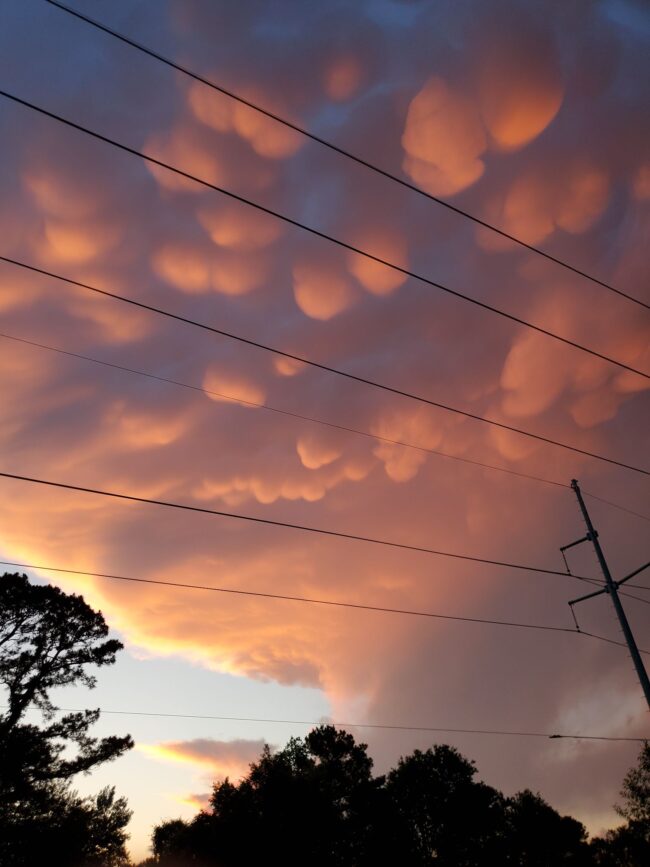 View at EarthSky Community Photos. | Lina Tomlin in Texarkana, Texas, caught these mammatus clouds on April 29, 2024. Lina wrote: “Stepped outside and my jaw dropped. I loved watching this massive storm cell roll by. I saw more ‘bubble’ clouds appear, and as the sun went down they lit up. I’ve never been this close to clouds like that. Thrilling!” Thank you, Lina!Mammatus clouds: Ominous and beautiful
View at EarthSky Community Photos. | Lina Tomlin in Texarkana, Texas, caught these mammatus clouds on April 29, 2024. Lina wrote: “Stepped outside and my jaw dropped. I loved watching this massive storm cell roll by. I saw more ‘bubble’ clouds appear, and as the sun went down they lit up. I’ve never been this close to clouds like that. Thrilling!” Thank you, Lina!Mammatus clouds: Ominous and beautiful
Mammatus clouds are pouch-like protrusions hanging from the undersides of clouds. You’ll usually find them under thunderstorm anvil clouds. But you might see them under other types of clouds as well. They’re composed primarily of ices, and groups of them can extend hundreds of miles in any direction. But they’re fleeting, remaining visible in your local sky for perhaps 10 or 15 minutes at a time.
People associate these cloud pouches with severe weather. And it’s true; they typically appear around, before or after a storm.
In fact, most clouds are formed by rising air. But mammatus clouds are interesting in part because they’re formed by sinking air.
They appear ominous. And they do signify storms. But, in a way that’s so common in nature, their dangerous aspect goes hand-in-hand with a magnificent beauty.
Beautiful, bubbling clouds from 2023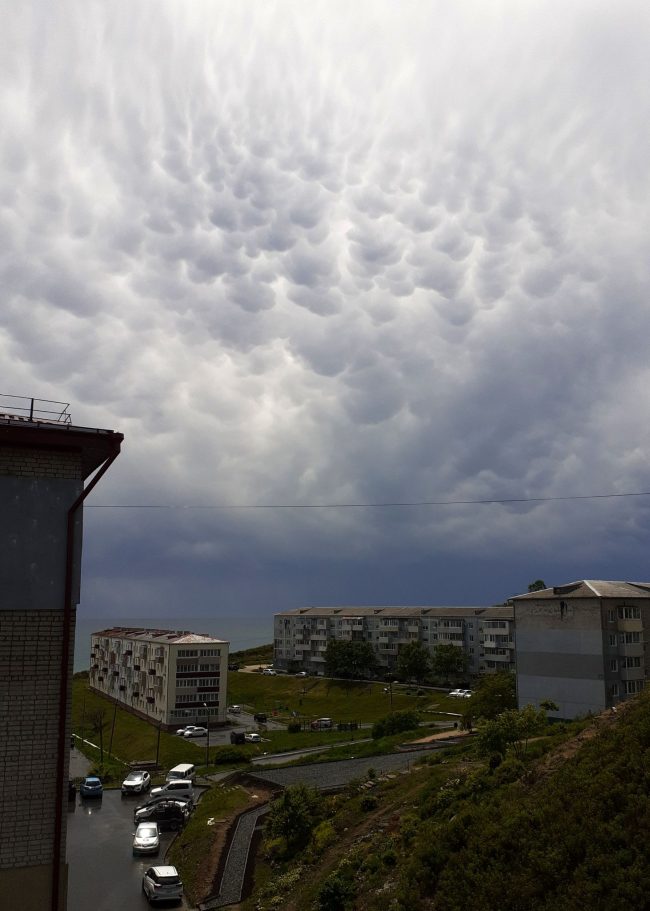 View at EarthSky Community Photos. | Filipp Romanov in Yuzhno-Morskoy, Russia, captured these mammatus clouds on June 4, 2023. Thank you, Filipp!
View at EarthSky Community Photos. | Filipp Romanov in Yuzhno-Morskoy, Russia, captured these mammatus clouds on June 4, 2023. Thank you, Filipp!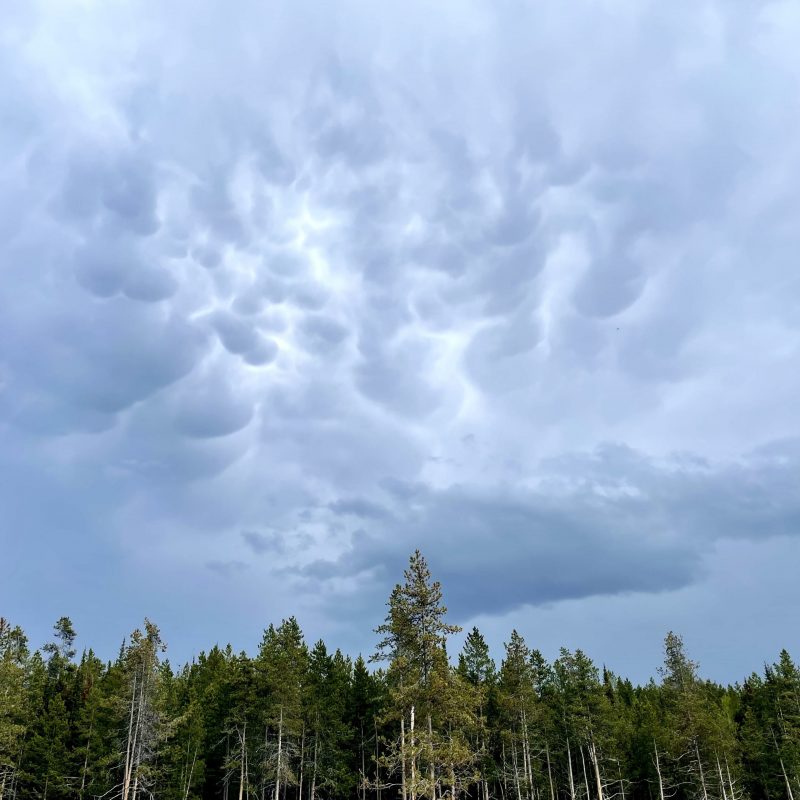 EarthSky’s Kelly Kizer Whitt shared this photo of mammatus clouds from Colter Bay in Grand Teton National Park on May 30, 2023. Mammatus clouds from 2022
EarthSky’s Kelly Kizer Whitt shared this photo of mammatus clouds from Colter Bay in Grand Teton National Park on May 30, 2023. Mammatus clouds from 2022
 View at EarthSky Community Photos. | Peg Yates in Woodbridge, Virginia, took this image on August 22, 2022. Peg wrote: “Mammatus clouds in the western sky when the sun was setting.” Thank you, Peg!
View at EarthSky Community Photos. | Peg Yates in Woodbridge, Virginia, took this image on August 22, 2022. Peg wrote: “Mammatus clouds in the western sky when the sun was setting.” Thank you, Peg!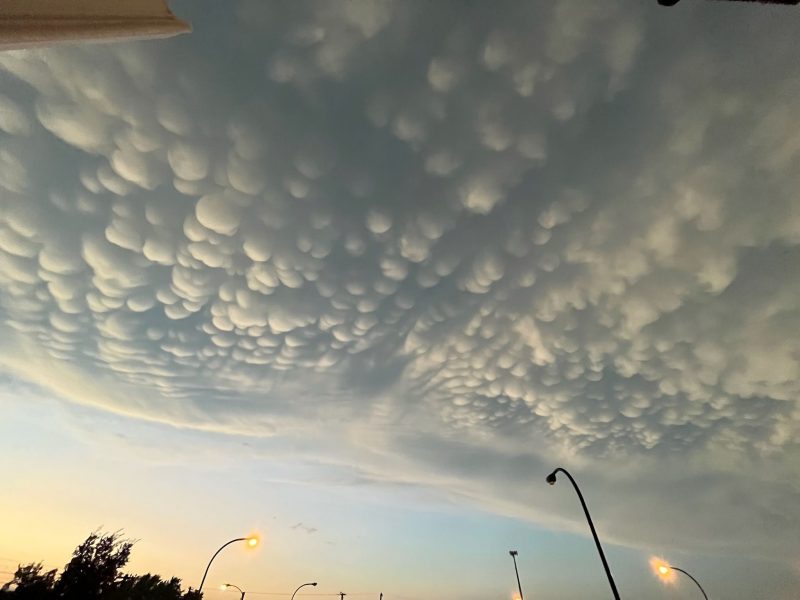 View at EarthSky Community Photos. | Michael Geib caught these mammatus clouds from Akron, Ohio, on July 20, 2022. Thank you, Michael!
View at EarthSky Community Photos. | Michael Geib caught these mammatus clouds from Akron, Ohio, on July 20, 2022. Thank you, Michael! Mammatus clouds from Kelly Kizer Whitt at the Amtrak station in Whitefish, Montana, on July 7, 2022. See the mammatus clouds on the far underside of the storm? Image via Kelly Kizer Whitt.Mammatus clouds from 2021
Mammatus clouds from Kelly Kizer Whitt at the Amtrak station in Whitefish, Montana, on July 7, 2022. See the mammatus clouds on the far underside of the storm? Image via Kelly Kizer Whitt.Mammatus clouds from 2021
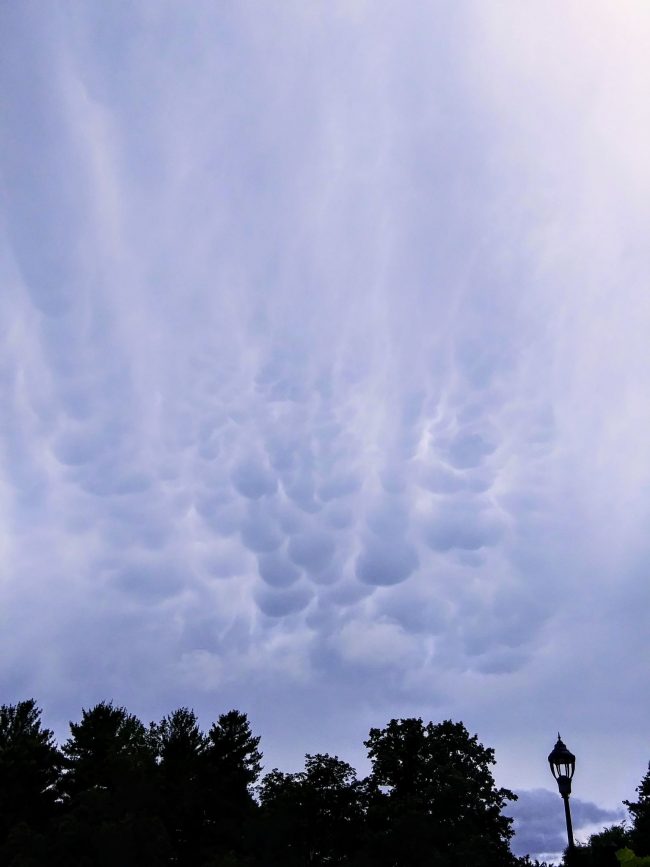 Steve Schultz in Ashville, North Carolina, sent this photograph of mammatus clouds on June 20, 2021. Thank you, Steve!Images from 2020
Steve Schultz in Ashville, North Carolina, sent this photograph of mammatus clouds on June 20, 2021. Thank you, Steve!Images from 2020
 View larger at EarthSky Community Photos. | Christy Turner caught this photo of graduate Cheyann on June 13, 2020, from Calgary, Alberta, Canada. Christy wrote: “Incredible mammatus clouds and a rainbow help complete a graduation photo shoot. Since Cheyann didn’t get a proper occasion to wear her beautiful graduation gown, we scheduled a photo shoot at her grandparent’s farm. What we didn’t count on was nature delivering up an incredible backdrop post-storm.” Thanks, Christy!
View larger at EarthSky Community Photos. | Christy Turner caught this photo of graduate Cheyann on June 13, 2020, from Calgary, Alberta, Canada. Christy wrote: “Incredible mammatus clouds and a rainbow help complete a graduation photo shoot. Since Cheyann didn’t get a proper occasion to wear her beautiful graduation gown, we scheduled a photo shoot at her grandparent’s farm. What we didn’t count on was nature delivering up an incredible backdrop post-storm.” Thanks, Christy!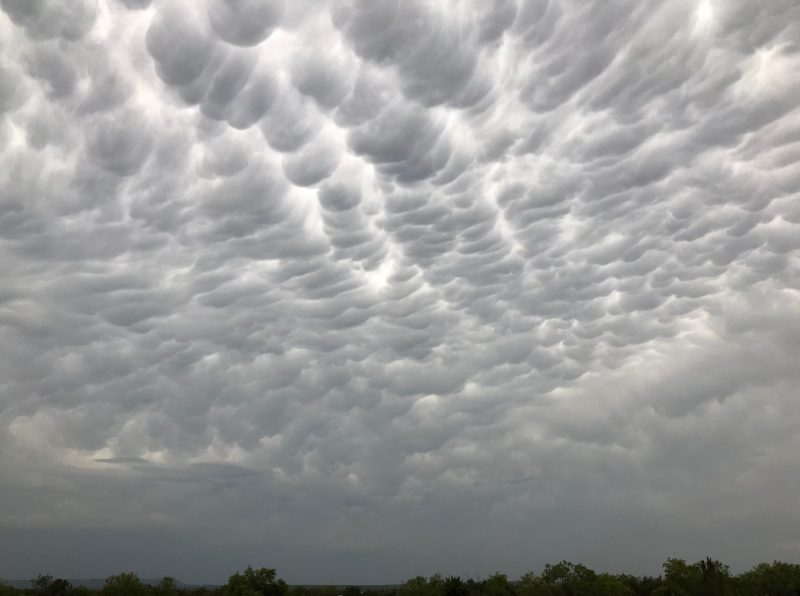 View at EarthSky Community Photos. | Marlane Burns captured this image on May 15, 2020, near Robert Lee, Texas. She said: “Mammatus clouds preceding a northern thunderstorm that came out of nowhere! The wind blew the flies away and the rain settled the dust!”
View at EarthSky Community Photos. | Marlane Burns captured this image on May 15, 2020, near Robert Lee, Texas. She said: “Mammatus clouds preceding a northern thunderstorm that came out of nowhere! The wind blew the flies away and the rain settled the dust!”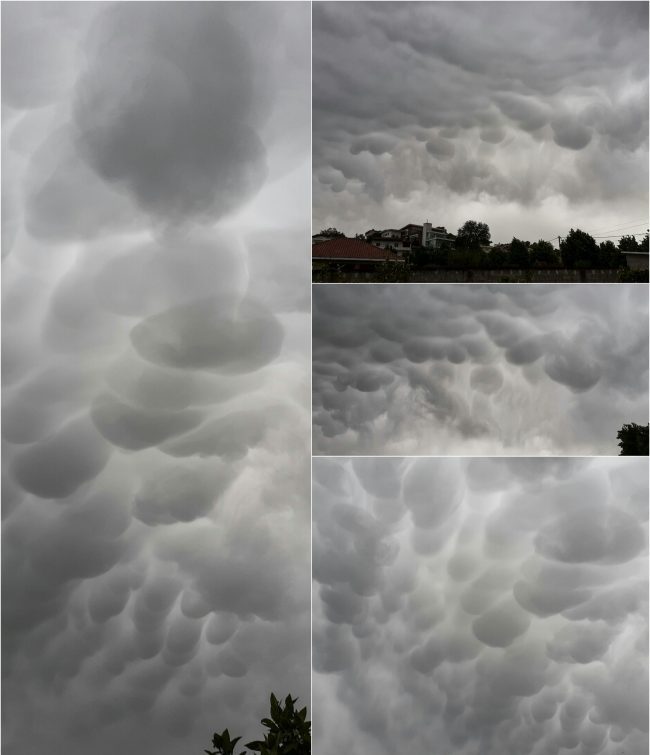 View at EarthSky Community Photos. | Adelina Bathorja in Tirane, Albania, captured these clouds on May 14, 2020. Adelina wrote: “For the first time ever I saw mammatus clouds. Just, wow! It was a spectacular view of cellular and jellyfish patterns.”
View at EarthSky Community Photos. | Adelina Bathorja in Tirane, Albania, captured these clouds on May 14, 2020. Adelina wrote: “For the first time ever I saw mammatus clouds. Just, wow! It was a spectacular view of cellular and jellyfish patterns.”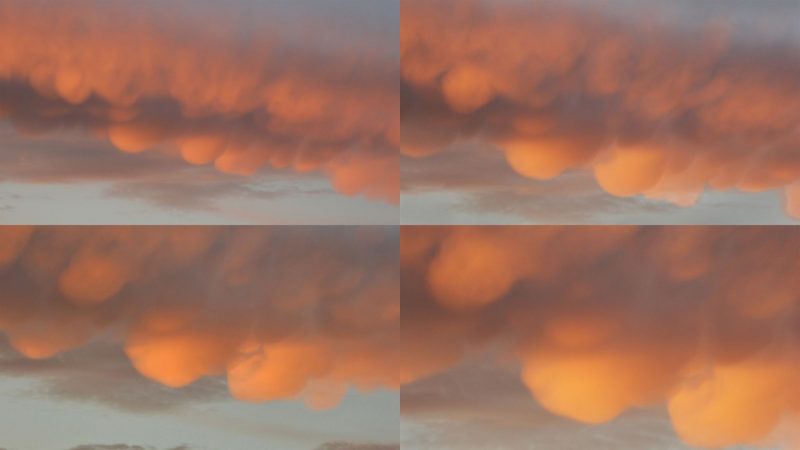 View at EarthSky Community Photos. | Peter Lowenstein captured these spectacular mammatus clouds in Mutare, Zimbabwe, on March 23, 2020. He wrote: “I took an early morning walk in the hope of catching a glimpse of the old moon rising. Instead there was a surprise appearance of mammatus clouds on the underside of a sunrise-illuminated band of altostratus cloud above.”
View at EarthSky Community Photos. | Peter Lowenstein captured these spectacular mammatus clouds in Mutare, Zimbabwe, on March 23, 2020. He wrote: “I took an early morning walk in the hope of catching a glimpse of the old moon rising. Instead there was a surprise appearance of mammatus clouds on the underside of a sunrise-illuminated band of altostratus cloud above.”Bottom line: Mammatus clouds look like bubbling, low-hanging clouds. They’re often associated with thunderstorms. Learn more about them here and see photos.
The post Mammatus clouds are ominous and beautiful first appeared on EarthSky.
Nobel Prize-winning economist Joseph Stiglitz: Fed rate hikes didn’t get at source of inflation… Yep, it didn’t f*cking help… The Swiss government is starting to decrease the rates. First across the world… When are the other countries going to follow? Hey friends, it’s time to wake up! If a few more people choose to support […]
The post Fed rate hikes didn’t get at source of inflation appeared first on Strange Sounds.
The ruins of an almost 300-year-old town have resurfaced as searing temperatures in the Philippines partially dried up a major dam. Pantabangan town was submerged in the 1970s to build a reservoir. But it emerges from the water on extremely rare occasions, when the weather is dry and hot. It comes as almost half the […]
The post The return of the ghosts… Drought dries up dam to reveal centuries-old town in the Philippines appeared first on Strange Sounds.
New sunspot AR3663 erupted this morning, May 3rd @ 0222 UT, producing an X1.6-class solar flare. NASA’s Solar Dynamics Observatory captured the extreme ultraviolet flash: Radiation from the flare ionized the top of Earth’s atmosphere and caused a deep shortwave radio blackout over Australia, Japan, and much of China. Ham radio operators may have noticed […]
The post X-CLASS SOLAR FLARE, DOUBLE CME STRIKE & MYSTERIOUS FLYING OBJECT! Beware of big quakes, satellite and GPS jamming in coming days appeared first on Strange Sounds.
https://strangesounds.substack.com/p/suspicious-this-is-just-the-second
The post Suspicious? This is just the second Boeing whistleblower to die within 2 months appeared first on Strange Sounds.
Either through stupidity or corruption, the window of opportunity to address a major infrastructure problem and potentially save lives is being thrown away. When the people of Mexico City addressed their city council about Coca-Cola’s use of their water, it was ignored. When confronted about the water shortage, the president denied one even existed. Mexican […]
The post The water wars are getting close! As the water crisis In Mexico worsens… It’s Coca-Cola above all… appeared first on Strange Sounds.
EarthSky’s Will Triggs created this 1-minute video summary for you. Life on exoplanet K2-18 b?
NASA’s James Webb Space Telescope completed another scheduled observation of exoplanet K2-18 b on April 26, 2024. These most recent Webb observations reportedly went for eight hours. The observations follow the tentative and highly debated result from September of last year, when Webb reportedly observed a molecule called dimethyl sulfide – a possible life sign – in this exoplanet’s atmosphere. The new Webb observations now need to be analyzed. And it will likely be at least a few months before we hear more about whether Webb found the dimethyl sulfide signal again or more details about the planet itself. But know that this exoplanet is being scrutinized, and that it might become famous as the first place in our Milky Way galaxy – behind our own Earth – where we have found signs of life.
So did Webb spot signs of life on this planet, located only about 124 light-years from Earth, in the direction of the constellation Leo the Lion? On September 11, 2023, NASA announced that Webb had made some exciting discoveries while observing this distant world. They said the planet has methane and carbon dioxide in its atmosphere, which indicates it might be a Hycean world, one with a deep hydrogen atmosphere and global water ocean.
But the extraordinary news was that Webb had found hints of dimethyl sulfide (DMS). On Earth, only life produces dimethyl sulfide, such as bacteria and phytoplankton in oceans.
What will happen next? The finding of dimethyl sulfide needs to be confirmed. Then, scientists have to learn more about the exoplanet itself. While it is in the habitable zone of its star, its environment could still be unfavorable to life. As NASA said, it may have a hostile environment due to its active star, or its ocean may also be too hot to be habitable.
Still, the new discovery is tantalizing.
By the way, the London Times published a new article about exoplanet K2-18b on April 25 and there is also a new video interview (April 26) with Nikku Madhusudhan, a University of Cambridge astrophysicist involved in last year’s research.
 View larger. | Artist’s concept of exoplanet K2-18 b. NASA’s James Webb Space Telescope has found that its deep hydrogen atmosphere contains methane and carbon dioxide. The findings mean that K2-18 b might have a global ocean beneath its atmosphere. Webb also tentatively detected dimethyl sulfide (DMS) in the atmosphere, which on Earth is only produced by life. Image via NASA/ CSA/ ESA/ J. Olmsted (STScI); Science: N. Madhusudhan (Cambridge University).
View larger. | Artist’s concept of exoplanet K2-18 b. NASA’s James Webb Space Telescope has found that its deep hydrogen atmosphere contains methane and carbon dioxide. The findings mean that K2-18 b might have a global ocean beneath its atmosphere. Webb also tentatively detected dimethyl sulfide (DMS) in the atmosphere, which on Earth is only produced by life. Image via NASA/ CSA/ ESA/ J. Olmsted (STScI); Science: N. Madhusudhan (Cambridge University).
While studying the exoplanet K2-18 b, @NASAWebb hinted at a detection of dimethyl sulphide (DMS). On Earth, this molecule is only produced by microbial life. Because the detection needs to be confirmed, the team will follow up with additional observations. https://t.co/lYRNSVgI0M pic.twitter.com/Ui3c1fDbSf
— NASA Exoplanets (@NASAExoplanets) September 11, 2023
More about K2-18 b
K2-18 b is what scientists call a sub-Neptune or mini-Neptune. The exoplanet is 2.6 times larger and 8.6 times more massive than Earth. The new data from Webb show that the exoplanet is also likely a Hycean world. And unlike many sub-Neptunes, scientists say that Hyceans may be habitable. That means the conditions could be right for life to form (it does not mean that we are planning to send earthly life to the exoplanet).
The Webb discovery in September was also the first time that astronomers had discovered carbon molecules in the atmosphere of a planet in its star’s habitable zone.
The September observations were published in The Astrophysical Journal on October 9, 2023. And they have already begun to be cited by other scientists, somewhat widely.
A Hycean world with an ocean?K2-18 b orbits in the habitable zone of a red dwarf star. The habitable zone is the region around a star where temperatures could allow liquid water to exist. To be clear, this doesn’t prove that K2-18 b is actually habitable, although the new findings from Webb support that it is possible.
Also, Hyceans are a newer identified class of exoplanet, and there is still a lot that we don’t know about them. Unlike most sub-Neptunes, however, they may be able to have solid surfaces beneath their deep hydrogen atmospheres. And below the atmosphere, a global water ocean. They would still be hotter than Earth, but perhaps not too hot for life of some kind.
The discovery of methane (CH4) and carbon dioxide (CO2) – and a lack of ammonia (NH3) – support the hypothesis that K2-18 b is a Hycean planet, the researchers said. Lead author Nikku Madhusudhan, an astronomer at the University of Cambridge, said that:
Our findings underscore the importance of considering diverse habitable environments in the search for life elsewhere. Traditionally, the search for life on exoplanets has focused primarily on smaller rocky planets, but the larger Hycean worlds are significantly more conducive to atmospheric observations.
The researchers said that K2-18 b likely has a mantle of high-pressure ice, similar to Neptune. The Webb results support the possibility of a planet-wide ocean on the surface, although it is still possible that the planet is too hot. Or at least too hot for the ocean to be habitable. Only additional observations will help astronomers determine the actual conditions.
Webb detects possible biosignatureThe presence of methane, carbon dioxide and a possible ocean are certainly interesting on their own of course. But Webb also potentially detected something even more tantalizing in the atmosphere of K2-18 b: dimethyl sulfide (DMS). Dimethyl sulfide is an organic sulfur compound. On Earth, it is only produced naturally by biological processes from organisms such as bacteria and phytoplankton in marine environments.
This is still tentative, however. While there is a possible detection, it is less robust than the detections of methane and carbon dioxide. The paper stated:
The potential inference of DMS is of high importance as it is known to be a robust biomarker on the Earth and has been extensively advocated to be a promising biomarker for exoplanets.
Overall, we find CH4 and CO2 to be our most confident detections, followed by DMS, with the abundance estimates reported above. While our results provide important first insights into the chemical composition of K2-18 b, upcoming observations will be able to verify our present findings.
These findings support the Hycean nature of K2-18 b and the potential for biological activity on the planet.
Madhusudhan said:
The possibility of DMS in the atmosphere is highly promising, but we are planning to take another look to robustly establish its presence.
 View larger. | Atmospheric composition of K2-18 b from the Webb telescope. The atmosphere is primarily hydrogen; this graph shows the detections of methane, carbon dioxide and dimethyl sulfide. Image via NASA/ CSA/ ESA/ R. Crawford (STScI)/ J. Olmsted (STScI); Science: N. Madhusudhan (Cambridge University).Most detailed spectrum of a habitable zone sub-Neptune
View larger. | Atmospheric composition of K2-18 b from the Webb telescope. The atmosphere is primarily hydrogen; this graph shows the detections of methane, carbon dioxide and dimethyl sulfide. Image via NASA/ CSA/ ESA/ R. Crawford (STScI)/ J. Olmsted (STScI); Science: N. Madhusudhan (Cambridge University).Most detailed spectrum of a habitable zone sub-Neptune
Webb’s observations are the most detailed yet of a sub-Neptune in the habitable zone. Co-author Subhajit Sarkar of Cardiff University said:
Although this kind of planet does not exist in our solar system, sub-Neptunes are the most common type of planet known so far in the galaxy. We have obtained the most detailed spectrum of a habitable zone sub-Neptune to date, and this allowed us to work out the molecules that exist in its atmosphere.
Savvas Constantinou of the University of Cambridge added:
These results are the product of just two observations of K2-18 b, with many more on the way. This means our work here is but an early demonstration of what Webb can observe in habitable-zone exoplanets.
Future observations with WebbOf course, now we want to know if Webb will be doing any follow-up observations. The answer is yes. The team will use the telescope’s MIRI (Mid-Infrared Instrument) spectrograph to further analyze the planet’s atmosphere. As Madhusudhan said:
Our ultimate goal is the identification of life on a habitable exoplanet, which would transform our understanding of our place in the universe. Our findings are a promising step toward a deeper understanding of Hycean worlds in this quest.
Bottom line: NASA’s Webb telescope looked at the sub-Neptune exoplanet K2-18 b. It found methane, carbon dioxide, a possible ocean, and even … maybe … a biosignature.
Source: Carbon-bearing Molecules in a Possible Hycean Atmosphere
Read more: Hycean planets might be habitable ocean worlds
Read more: Super-Earth, mini-Neptune or sub-Neptune?
The post Did Webb find signs of life on exoplanet K2-18 b? first appeared on EarthSky.
 Here’s a sample of simulated Martian regolith after removal from the simulation chamber at NASA’s Goddard Space Flight Center. In the sample, a solid crust of salt formed on the surface. A new study says methane on Mars may be trapped beneath such crusts, only seeping out when conditions are a bit warmer and the crust seal weakens. Image via NASA/ Alexander Pavlov.On Earth, methane mostly has a biological origin. On Mars, methane has only been discovered in Gale crater, and its origins are unknown.
The Curiosity rover on Mars found strange bursts of methane seeping from the ground.
A new experiment at NASA’s Goddard Space Flight Center shows the methane likely trapped beneath a crust of salt. The methane seeps out when temperatures warm. Or, it might even be Curiosity rover breaking the crust and releasing the methane.
The strange tale of methane on Mars
Here’s a sample of simulated Martian regolith after removal from the simulation chamber at NASA’s Goddard Space Flight Center. In the sample, a solid crust of salt formed on the surface. A new study says methane on Mars may be trapped beneath such crusts, only seeping out when conditions are a bit warmer and the crust seal weakens. Image via NASA/ Alexander Pavlov.On Earth, methane mostly has a biological origin. On Mars, methane has only been discovered in Gale crater, and its origins are unknown.
The Curiosity rover on Mars found strange bursts of methane seeping from the ground.
A new experiment at NASA’s Goddard Space Flight Center shows the methane likely trapped beneath a crust of salt. The methane seeps out when temperatures warm. Or, it might even be Curiosity rover breaking the crust and releasing the methane.
The strange tale of methane on Mars
The NASA Curiosity rover’s explorations of Gale crater on Mars revealed strange behavior of methane seeping from the ground. On Earth, biological processes produce most methane. The origin of methane on Mars is still unclear. On April 22, 2024, researchers said they may have an explanation for the odd bursts of methane from the crater. It may seep out as temperature rises, or it may even be due to the weight of the rover itself. But its origins are still a mystery.
We haven’t found signs of methane anywhere else on Mars. In Gale crater, the methane is trapped beneath frozen, solidified salt in the regolith, the top layer of smashed rock and dust. Scientists think the methane could seep out from under the salty crust when the temperature rises. The rising temperatures could either be during warmer parts of the day or warmer seasons. On the other hand, the methane release could also happen when the weight of the passing rover breaks the salt seal beneath its wheels.
The research team published their peer-reviewed results in the AGU journal JGR Planets on March 9, 2024.
Mysterious methane on MarsMethane in Gale crater exhibits unusual behavior. It appears at night and then disappears during the day. The levels also fluctuate significantly, both during the day and seasonally. Sometimes it spikes to 40 times its usual background levels. And, despite all the seeping, it doesn’t seem to accumulate in the atmosphere beyond trace levels at most. But why?
It’s still a mystery. As Ashwin Vasavada, Curiosity’s project scientist at NASA’s Jet Propulsion Laboratory in California, said:
It’s a story with a lot of plot twists.
Is the methane hiding under solidified salt?The new study doesn’t focus so much on how the methane itself is produced, but rather how it gets released to the surface. What causes the methane to seep out? The new research suggests salt may hold the answer. Not just any salt, but perchlorate specifically. Scientists already know this type of salt is widespread on Mars.
Led by Alexander Pavlov, a planetary scientist at NASA’s Goddard Space Flight Center in Greenbelt, Maryland, the researchers created simulated permafrost with various concentrations of perchlorate. Then, they exposed the samples to different temperatures and air pressures. Lastly, they injected neon – an analog for methane – into the frozen soil. In the experiments, a hard seal of solidified salt formed. This occurred in three to 13 days, but only in samples containing 5 to 10% perchlorate. The pressure of the gas below the salt layer was also higher, meaning the methane was trapped below the salt.
The tests were based on previous observations from 2017. Those tests involved growing microbes in simulated martian permafrost. When the salty ice sublimated – changed directly from a solid to a gas – during warmer temperatures, it left behind a hard crust of salt. That inspired the new experiments. Pavlov said:
We didn’t think much of it at the moment. That’s when it clicked in my mind.
 Sample of simulated martian regolith after it was removed from the simulation chamber at NASA’s Goddard Space Flight Center. In this sample, there wasn’t enough salt to form a crust. Image via NASA/ Alexander Pavlov.How methane seeps out of the ground
Sample of simulated martian regolith after it was removed from the simulation chamber at NASA’s Goddard Space Flight Center. In this sample, there wasn’t enough salt to form a crust. Image via NASA/ Alexander Pavlov.How methane seeps out of the ground
So how does the methane seep out into the atmosphere? The researchers explained how the salt could be the answer for why the methane seeps when it does. When the temperature is a bit warmer, during the day or in warmer seasons, the salty ice would start to sublimate. This would weaken the hard salty seal in the frozen ground, allowing trapped methane to escape. Another intriguing possibility is that the weight of the rover itself could even break the seals as it travels over the landscape.
The researchers note the amounts of perchlorate they added to the experiments are higher than what is in the regolith in Gale crater. That regolith, however, is rich in another kind of salt called sulfate. So now, the research team will experiment with sulfate to see if it will form similar salty crusts.
Curiosity can only sniff for methane periodically with its Sample Analysis at Mars (SAM) onboard laboratory, since its instruments are needed for other tasks most of the time. As Charles Malespin, principal investigator for SAM at Goddard, noted:
Methane experiments are resource intensive, so we have to be very strategic when we decide to do them.
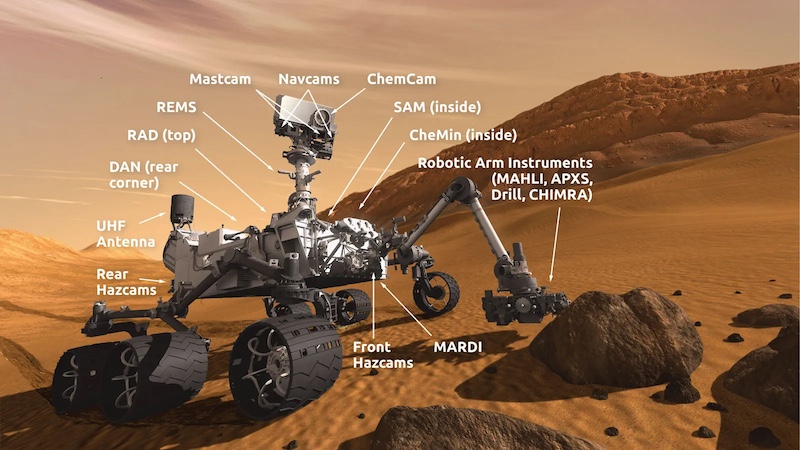 View larger. | Curiosity uses its Sample Analysis at Mars (SAM) laboratory to sniff for and analyze the methane in the atmosphere. Image via NASA/ JPL-Caltech.Methane on Mars: Geological or biological?
View larger. | Curiosity uses its Sample Analysis at Mars (SAM) laboratory to sniff for and analyze the methane in the atmosphere. Image via NASA/ JPL-Caltech.Methane on Mars: Geological or biological?
We don’t know yet if the methane on Mars is geological or biological in origin. At Gale crater, it appears to be produced underground where it’s trapped under the salt crusts. Curiosity will need to do more sampling for us to learn more. Even then, we may need to wait for future spacecraft or rovers with specialized instruments. Ideally, the methane should be measured in multiple locations on Mars. Vasavada said:
Some of the methane work will have to be left to future surface spacecraft that are more focused on answering these specific questions.
Bottom line: New experiments show that methane on Mars, in Gale crater, may seep out of the ground when hard crusts of perchlorate salt temporarily warm up and weaken.
Read more: Mars methane mystery? Depends on the time of day
Read more: Methane on Enceladus: A possible sign of life?
The post The strange case of methane on Mars: Possible new answers first appeared on EarthSky.
The U.S. Air Force has awarded a $13 billion contract to Sierra Nevada Corp to develop a successor to the E-4B, also known as the “Doomsday plane” for its ability to withstand nuclear war. The new project, called Survivable Airborne Operations Center (SAOC), aims to replace the aging E-4B, which dates back to the 1970s. […]
The post U.S. Air Force has awarded $13B contract to Sierra Nevada Corp to develop the new “Doomsday plane” appeared first on Strange Sounds.
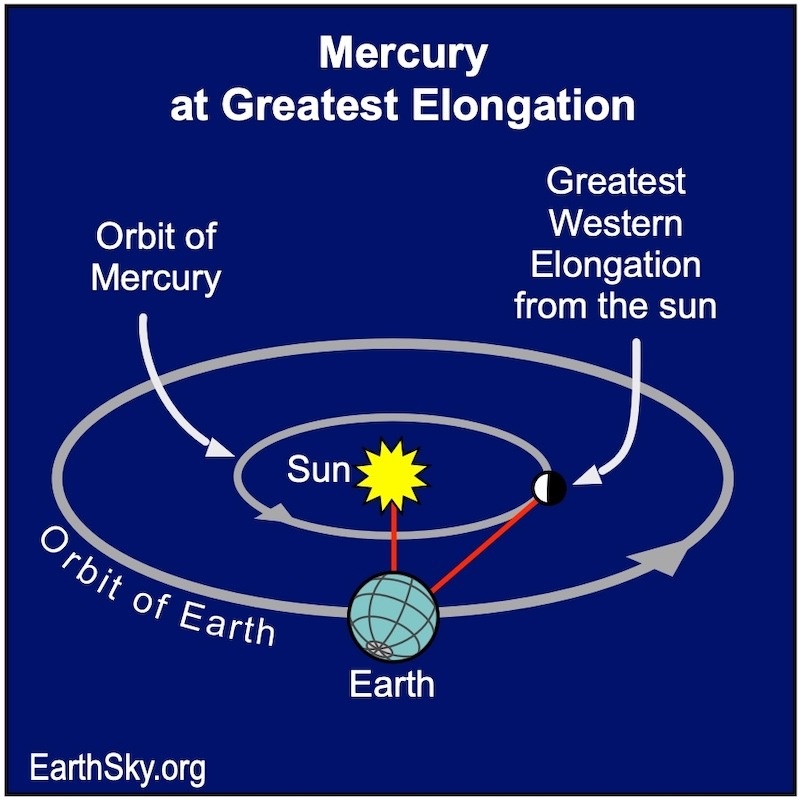 At greatest elongation on May 9, 2024, Mercury lies to one side of the sun as seen from Earth. Moreover, it’s at its greatest distance from the sun on our sky’s dome. Chart via John Jardine Goss/ EarthSky.
At greatest elongation on May 9, 2024, Mercury lies to one side of the sun as seen from Earth. Moreover, it’s at its greatest distance from the sun on our sky’s dome. Chart via John Jardine Goss/ EarthSky.Mercury will reach greatest elongation – its greatest distance from the sun in the morning sky – on May 9, 2024. At that time, it’s 26 degrees from the sunrise.
The innermost planet Mercury orbits the sun every 88 days. And Earth is moving, too. So Mercury goes between us and the sun pretty often, about every 116 days. Indeed, it did this last on April 11, 2024, reaching the point astronomers call inferior conjunction. Since then, Mercury has been speeding ahead of Earth in orbit. It re-emerged in our dawn sky late last month. Now, Mercury will reach its greatest morning elongation – its greatest apparent distance from the rising sun – on May 9, 2024.
Also, due to the angle of the ecliptic – path of the sun, moon and planets – this time of the year, this May 2024 Mercury elongation is better viewed from the Southern Hemisphere because the planet will reach a higher altitude on the sky dome. In fact, this will be the best morning apparition for the Southern Hemisphere. But northern skywatchers can see it, too!
In the meantime, the innermost planet – named for the fleet-footed messenger god of the ancient Romans – will be visible for a few more weeks.
Mercury greatest elongation, May 2024When to watch: Officially, Mercury will became visible toward the end of April 2024 in the morning sky. However, it will be tough to see until it climbs higher in the sky. At greatest elongation – May 9, 2024 – Mercury is farthest from the sunrise on our sky’s dome. And after that, when it’ll be edging back toward the sunrise, it’ll brighten a little bit more, making Mercury easier to spot – although low – in the morning twilight.
Where to look: Look in the sunrise direction, as the sky is getting lighter. Mercury, Mars and Saturn are all lined up before the sunrise.
Greatest elongation is on May 9 at 9:00 UTC (4:00 a.m. CDT). Mercury is shining at a 0.6 magnitude that morning. And it is 26 degrees from the sun.
Through a telescope on and around May 9, Mercury appears 41% illuminated, in a crescent phase, and 8.1 arcseconds across.
Note: Once you spot it, notice that Mercury brightens quickly as May progresses, reaching a magnitude of around -0.7 (bright, but in bright morning twilight) before slipping away in the morning glare before the end of the month.
 Mercury climbs further from the morning sun through May 9, 2024, when it reaches its greatest morning elongation and is 26 degrees from the sun. It’ll be shining at magnitude 0.6. Then, it’ll continue to brighten a bit for the rest of the month until it slips from view. In fact, this will be the best morning apparition of 2024 for Southern Hemisphere observers. It’ll rise about 45 minutes before the sun on May 1 and will rise about 30 minutes before the sun by month’s end. Also, you might also spot Mars higher in the sky in the morning twilight. Chart via EarthSky.
Mercury climbs further from the morning sun through May 9, 2024, when it reaches its greatest morning elongation and is 26 degrees from the sun. It’ll be shining at magnitude 0.6. Then, it’ll continue to brighten a bit for the rest of the month until it slips from view. In fact, this will be the best morning apparition of 2024 for Southern Hemisphere observers. It’ll rise about 45 minutes before the sun on May 1 and will rise about 30 minutes before the sun by month’s end. Also, you might also spot Mars higher in the sky in the morning twilight. Chart via EarthSky.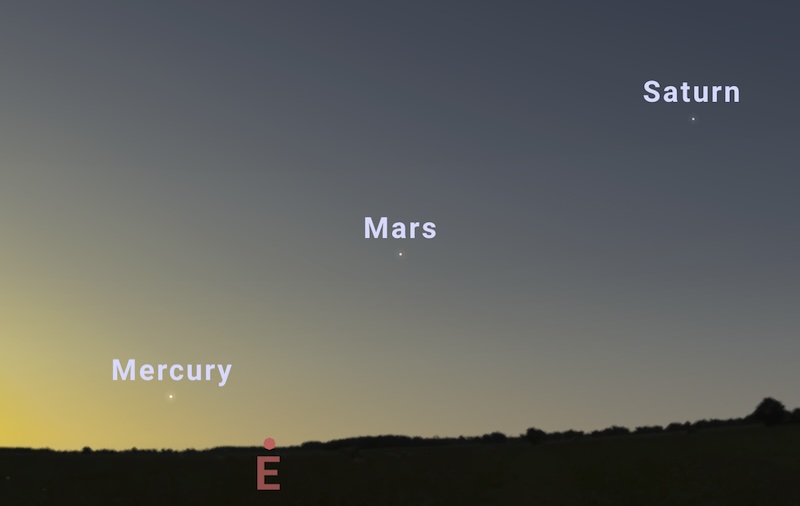 On the morning of greatest elongation, May 9, 2024, Mercury lies low in the morning twilight with Mars and Saturn lined up across the sky dome. Chart via Stellarium.org. Used with permission.Finder charts, Southern Hemisphere
On the morning of greatest elongation, May 9, 2024, Mercury lies low in the morning twilight with Mars and Saturn lined up across the sky dome. Chart via Stellarium.org. Used with permission.Finder charts, Southern Hemisphere
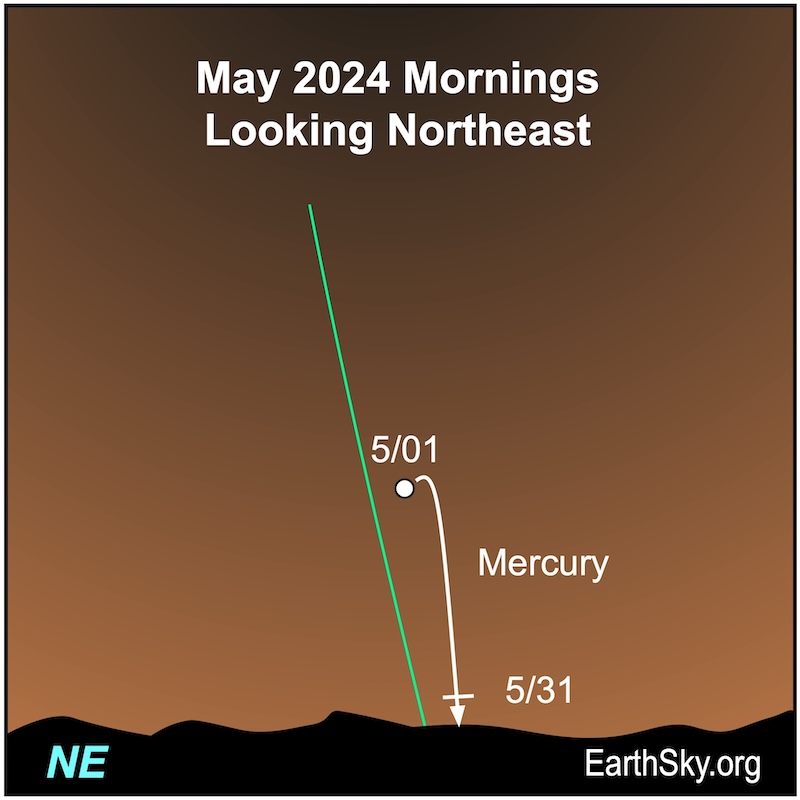 For viewers in the Southern Hemisphere, Mercury appears low in the northeast thirty minutes before sunrise in May, dropping a little closer to the horizon each morning. Chart via EarthSky.
For viewers in the Southern Hemisphere, Mercury appears low in the northeast thirty minutes before sunrise in May, dropping a little closer to the horizon each morning. Chart via EarthSky. On the morning of greatest elongation, May 9, 2024, Mercury lies low in the morning twilight with Mars and Saturn nearby. Chart via Stellarium.org. Used with permission.For precise sun and Mercury rising times at your location:
On the morning of greatest elongation, May 9, 2024, Mercury lies low in the morning twilight with Mars and Saturn nearby. Chart via Stellarium.org. Used with permission.For precise sun and Mercury rising times at your location:
Old Farmer’s Almanac (U.S. and Canada)
timeanddate.com (worldwide)
Stellarium (online planetarium program)
Note: Dates are listed based on UTC times
Jan 12, 2024: Greatest elongation (morning)
Feb 28, 2024: Superior conjunction (passes behind sun from Earth)
Mar 24, 2024: Greatest elongation (evening)
Apr 11, 2024: Inferior conjunction (races between Earth and sun)
May 9, 2024: Greatest elongation (morning)
Jun 14, 2024: Superior conjunction (passes behind sun from Earth)
Jul 22, 2024: Greatest elongation (evening)
Aug 19, 2024: Inferior conjunction (races between Earth and sun)
Sep 5, 2024: Greatest elongation (morning)
Sep 30, 2024: Superior conjunction (passes behind sun from Earth)
Nov 16, 2024: Greatest elongation (evening)
Dec 5, 2024: Inferior conjunction (races between Earth and sun)
Dec 25, 2024: Greatest elongation (morning)
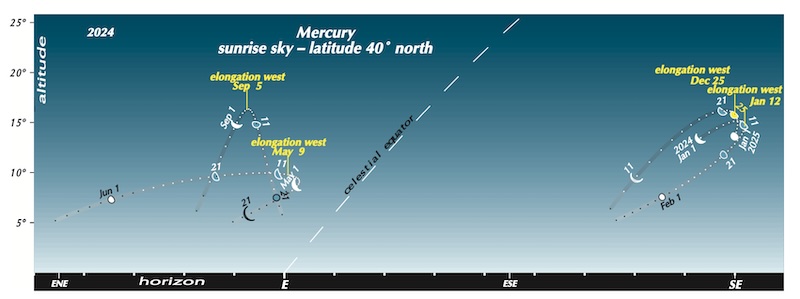 Mercury’s greatest morning elongations in 2024 – from the Northern Hemisphere – as viewed through a powerful telescope. The planet images are at the 1st, 11th and 21st of each month. Here, dots show the actual positions of the planet for every day. Chart via Guy Ottewell’s 2024 Astronomical Calendar. Used with permission.
Mercury’s greatest morning elongations in 2024 – from the Northern Hemisphere – as viewed through a powerful telescope. The planet images are at the 1st, 11th and 21st of each month. Here, dots show the actual positions of the planet for every day. Chart via Guy Ottewell’s 2024 Astronomical Calendar. Used with permission.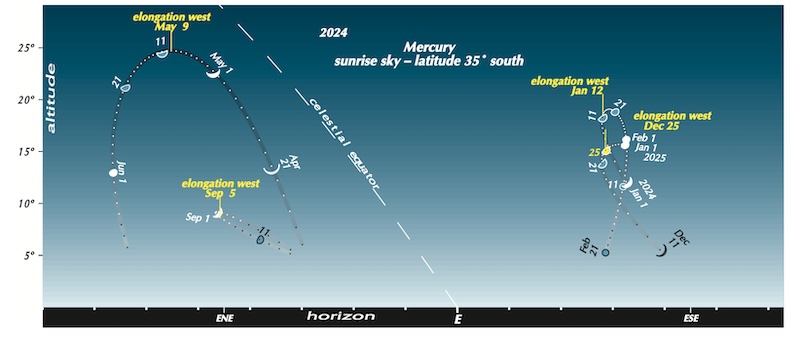 Mercury’s greatest morning elongations in 2024 from the Southern Hemisphere, as viewed through a powerful telescope. The planet images are at the 1st, 11th and 21st of each month. Here, dots show the actual positions of the planet for every day. Chart via Guy Ottewell’s 2024 Astronomical Calendar. Used with permission.A comparison of elongations
Mercury’s greatest morning elongations in 2024 from the Southern Hemisphere, as viewed through a powerful telescope. The planet images are at the 1st, 11th and 21st of each month. Here, dots show the actual positions of the planet for every day. Chart via Guy Ottewell’s 2024 Astronomical Calendar. Used with permission.A comparison of elongations
Mercury’s greatest elongations are not equal. Indeed, some are “greater” than others. For example, the distance of Mercury from the sun on our sky’s dome varies from about 28 degrees (maximum) to 18 degrees (minimum).
Also, Mercury elongations are better or worse depending on the time of the year they occur and your location on Earth. So, for both hemispheres, spring evenings and autumn mornings are best.
As an illustration, the chart below – from a Northern Hemisphere perspective – might help you visualize these differences.
 Mercury elongations compared. Here, gray areas represent evening apparitions (eastward elongation). Blue areas represent morning apparitions (westward elongation). The top figures are the maximum elongations, reached at the top dates shown beneath. Curves show the altitude of the planet above the horizon at sunrise or sunset, for latitude 40 degrees north (thick line) and 35 degrees south (thin line). Likewise, maxima are reached at the parenthesized dates below (40 degrees north bold). Chart via Guy Ottewell’s 2024 Astronomical Calendar. Used with permission.Heliocentric solar system, May 2024
Mercury elongations compared. Here, gray areas represent evening apparitions (eastward elongation). Blue areas represent morning apparitions (westward elongation). The top figures are the maximum elongations, reached at the top dates shown beneath. Curves show the altitude of the planet above the horizon at sunrise or sunset, for latitude 40 degrees north (thick line) and 35 degrees south (thin line). Likewise, maxima are reached at the parenthesized dates below (40 degrees north bold). Chart via Guy Ottewell’s 2024 Astronomical Calendar. Used with permission.Heliocentric solar system, May 2024
 Heliocentric view of solar system, May 2024. Chart via Guy Ottewell’s 2024 Astronomical Calendar. Used with permission.Seasons make a difference
Heliocentric view of solar system, May 2024. Chart via Guy Ottewell’s 2024 Astronomical Calendar. Used with permission.Seasons make a difference
So, in the autumn for either hemisphere, the ecliptic – or path of the sun, moon and planets – makes a narrow angle to the horizon in the evening. Conversely, it makes a steep slant, nearly perpendicular, in the morning. So – in autumn from either hemisphere – morning elongations of Mercury are best. Then, Mercury appears higher above the horizon and farther from the glow of the sun. Conversely, evening elongations in autumn are, however, harder to see.
On the other hand, in the spring for either hemisphere, the situation reverses. Then, the ecliptic and the horizon meet at a sharper angle on spring evenings and at a narrower angle on spring mornings. So, in springtime for either hemisphere, evening elongations of Mercury are best. Meanwhile, morning elongations in springtime are harder to see.
Bottom line: Mercury reaches its greatest elongation – greatest distance from the sunrise – on May 9, 2024. Look east at dawn. It’ll brighten through most of May before disappearing from the morning sky before the end of the month.
The post Mercury farthest from the sunrise on May 9 first appeared on EarthSky.
Those in charge of the levers of power in our world today have the ability to make decisions that affect a lot of people. Shedding light on some of the factors that influence those decisions in light of various disasters and catastrophic events is particularly relevant to collapse. The idea of Elite Panic seems to […]
The post We’re watching the elite panic in real time… appeared first on Strange Sounds.
 View larger. | ESA’s Mars Express orbiter captured this view of Martian spiders at the South Pole on October 4, 2020. The “spiders” form when sunlight causes deposits of carbon dioxide ice to warm up and turn to gas, which then builds up and breaks through slabs of overlying ice. The gas and dark dust fall back to the surface, creating the spider-like formations. Image via ESA/ TGO/ CaSSIS.The European Space Agency (ESA) released more images of the enigmatic, geologic “spiders” and Inca City at the South Pole of Mars.
The Mars spiders aren’t lifeforms.. They’re dark patches resembling spiders, seen from above by spacecraft, created by geysers of carbon dioxide gas and dust, erupting through layers of ice on Mars.
Inca City on Mars is where the spiders are found. This is scientists’ name for a series of hollows and ridges that resemble an ancient Incan ruin. This, too, is a natural geological formation, scientists say, and not made by ancient Martians.
There are spiders on Mars
View larger. | ESA’s Mars Express orbiter captured this view of Martian spiders at the South Pole on October 4, 2020. The “spiders” form when sunlight causes deposits of carbon dioxide ice to warm up and turn to gas, which then builds up and breaks through slabs of overlying ice. The gas and dark dust fall back to the surface, creating the spider-like formations. Image via ESA/ TGO/ CaSSIS.The European Space Agency (ESA) released more images of the enigmatic, geologic “spiders” and Inca City at the South Pole of Mars.
The Mars spiders aren’t lifeforms.. They’re dark patches resembling spiders, seen from above by spacecraft, created by geysers of carbon dioxide gas and dust, erupting through layers of ice on Mars.
Inca City on Mars is where the spiders are found. This is scientists’ name for a series of hollows and ridges that resemble an ancient Incan ruin. This, too, is a natural geological formation, scientists say, and not made by ancient Martians.
There are spiders on Mars
Have you read about the Mars spiders? No, they’re not a creepy crawly form of life. And they have nothing to do with David Bowie’s iconic album The Rise and Fall of Ziggy Stardust and the Spiders from Mars. The Martian spiders are geologic features on the red planet’s surface. They formed by geysers of carbon dioxide gas at Mars’ South Pole. The European Space Agency’s Mars Express orbiter acquired some new images of these fascinating formations and the “city” they inhabit, which scientists call Inca City (formerly Angustus Labyrinthus). This “city” isn’t a true city and wasn’t built by ancient Martians. It’s a large network of linear and geometric ridges that resemble ancient Incan ruins. ESA released the new images on April 24, 2024.
The Martian spidersThe spiders are irregular dark shapes on the landscape that look like spiders with multiple tendril-like legs. Typically, they range from about 147 feet (45 meters) to 1/2 mile (one km) in size. When first found, they looked like they might be some form of vegetation. But closer inspection by orbiting spacecraft, however, revealed what they really are, which is still fascinating: deposits of carbon dioxide gas and dark dust that form from geyser-like eruptions.
In the Martian winter at the South Pole, carbon dioxide forms layers on the surface. And carbon dioxide in the form of ice is the lowest layer. In spring, sunshine causes the ice to turn into carbon dioxide gas. The gas gradually builds up beneath slabs of ice. Eventually, it breaks through the ice as tall geysers. The gas also contains the dark dust, which falls back onto the surface. Consequently, the spots of spray from the gas and dust look like spiders.
In addition, there are other spider-like or web-like patterns below the ice. Scientists say the same processes likely create those as well.
 View larger. | This oblique view from Mars Express shows Inca City in the top right corner. Although the formation resembles ancient Incan ruins, scientists say it is natural in origin. Image via ESA/ DLR/ FU Berlin.
View larger. | This oblique view from Mars Express shows Inca City in the top right corner. Although the formation resembles ancient Incan ruins, scientists say it is natural in origin. Image via ESA/ DLR/ FU Berlin.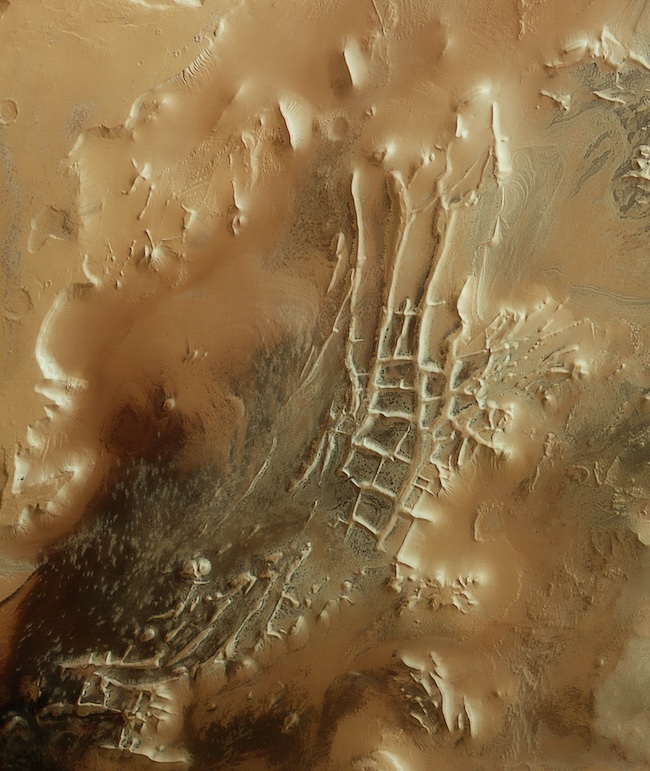 View larger/ full context image. | Overhead view of Inca City from Mars Express on February 27, 2024. Can you spot the many “spiders” inside the formation and outside on the landscape? Image via ESA/ DLR/ FU Berlin.Martian spiders and Inca City
View larger/ full context image. | Overhead view of Inca City from Mars Express on February 27, 2024. Can you spot the many “spiders” inside the formation and outside on the landscape? Image via ESA/ DLR/ FU Berlin.Martian spiders and Inca City
Most of the spiders are on the outskirts of a geological formation called Inca City. But quite a few are inside the city, too. The “city” – also formally known as Angustus Labyrinthus – is a long series of linear and geometric ridges or “walls” that are reminiscent of archaeological ruins of the ancient Incas on Earth.
But to be clear, scientists don’t think Inca City is an artificial ruin. That said, they’re not exactly sure how it formed, either. Theories include sand dunes that hardened over time to form the ridges or magma or sand seeping through fractured bedrock. Or the ridges might be eskers, that is, long, winding ridges of stratified sand and gravel, which occur in glaciated and formerly glaciated regions of Europe and North America.
An ancient impact crater?One possible clue is the ridges appear to form part of a larger circle. That circle would be about 53 miles (85 km) in diameter and would likely be the remains of an ancient impact crater. The impact may have created faults in the surface that then filled up with lava. The faults then wore away over billions of years, leaving behind the ridges.
The landscape near Inca City features “swirling ovals.” Those also may have formed when layered deposits of material slowly wore away over time. In addition, there are flat-topped mesas and hills nearby, standing over 4,500 feet (1,400 meters) tall.
While the spiders and city don’t really have anything to do with Martians – living or dead – they are a fascinating glimpse at some of the geological processes on the red planet. Mars is full of surprises!
Bottom line: Martian spiders? Inca City? Both geologic features on Mars. The European Space Agency (ESA) just released new images of them. Take a look!
Read more: Mars has spidery channels at the South Pole
Read more: Winter wonderland on Mars
The post See the Martian spiders of Inca City in new images first appeared on EarthSky.
Haiti health system is on its knees as gangs attack hospitals and medical supplies are getting scarce. This shows how political instability and gang activity can lead to the annihilation of a country’s infrastructure and support systems… On a recent morning at a hospital in the heart of gang territory in Haiti’s capital, a woman […]
The post Soon spreading into western countries? Haiti health system nears collapse as medicine dwindles, gangs attack hospitals appeared first on Strange Sounds.
Again, they blame ‘climate change’ even if this devastating fish mass die-off is clearly due to a bad reservoir/ water management… Hundreds of thousands of fish have died in a reservoir in southern Vietnam’s Dong Nai province, with locals and media reports suggesting a brutal heatwave and the lake’s management are to blame. Like much […]
The post Soon it’s going to be people! Millions of fish dead after reservoir dries up in weaponized heat wave in Vietnam appeared first on Strange Sounds.
Channel: MrMBB333
https://www.youtube.com/@ROCKSTARPREACHER �
Ordinary people that saw extraordinary things!!
Thanks for watching, be safe out there.
Become a member: https://www.youtube.com/channel/UCaVp-iXRPfiSxbkhmi56IHQ/join
You have something to share? Go to my official website click on red banner upload all there.
Official website: https://www.mrmbb333.com
Follow me on these other platforms:
X ~ mrmbb333
TikTok ~ https://www.tiktok.com/@mrmbb333
Instagram ~ https://www.instagram.com/mrmbb333/
Facebook ~ mrmbb333
If you want to send me something here's my PO BOX Address:
MRMBB333
2487 S. Gilbert Rd,
Ste 106 - 167
Gilbert, AZ 85295
BUSINESS INQUIRIES: mike@MrMBB333.com
#MrMBB333 #Earthwatchman
Video length: 16:18
Category: Entertainment
1664 comments
Channel: Anonymous Official
WATCH - So, the TRUTH is finally out. (israel is f*cked) *ALERT MESSAGE 2024-2025*
message strange truth world news current events may 2024 today this week this month motivation
In this video, When Netanyahu demanded that the protests against Israel be stopped, the US government complied because our members of Congress have all been bought and paid for with tax dollars given to the American Israeli Political Action Committee, known as AIPAC. AIPAC openly brags about this on their official website, because they don’t have to register under the Foreign Agents Registration Act, which requires agents of foreign principals to register and provide transparency.
Newsletter (Subscribe):
https://anon.news
Speakers:
Greg Reese
FOLLOW FOR MORE:
YouTube @-anonymous
Twitter https://twitter.com/anonymousofcl
Subscribe and Activate the � beside the subscribe button to get a notification! Leave a comment what you think.
Please SHARE this as widely as you feel drawn...
Content licensed
Related:
A Message to Israel
A Message to Israel
A Message to Israel
Keywords:
end times productions message strange truth world news current events april 2024 today this week this month motivation america CIA government israel-hamas
@RedactedNews
Video length: 9:26
Category: Education
812 comments
https://strangesounds.substack.com/p/nothing-to-see-here
The post Nothing to see here… appeared first on Strange Sounds.
Channel: Anonymous Official
INSIDER: "What's Coming Is WORSE Than A WW3" (warning)
message strange truth world news current events 2024 today this week this month motivation
Insider Explains Why America Is Entering A Horrific Financial Crisis... As the global economic landscape evolves, cracks in America's financial foundation have begun to surface, threatening to plunge the nation into an unprecedented crisis. Drawing upon years of experience and intimate knowledge of the inner workings of the economy, our insider sheds light on the root causes and ominous indicators that signal imminent turmoil.
From unsustainable debt levels to systemic vulnerabilities within key industries, our insider dissects the intricate web of factors driving America towards the brink of economic collapse. With a keen eye for detail and a knack for deciphering complex financial jargon, they provide a chilling analysis of the interconnected forces fueling this impending disaster.
But this exposé is not merely a harbinger of doom; it serves as a wake-up call to policymakers, investors, and everyday citizens alike. By confronting the stark realities of America's economic challenges head-on, we can begin to chart a course towards recovery and resilience.
Speakers
Ray Dalio
Newsletter (Subscribe):
https://anon.news
SUBSCRIBE @-anonymous for more - https://www.youtube.com/anonymous
WEBSITE - https://anon.news
FACEBOOK - https://facebook.com/anonymousdirect
INSTAGRAM - https://instagram.com/anonymous
TWITTER - https://twitter.com/anonymousOfcl
In this video:
Ray Dalio Insider
Ray Dalio Message
Ray Dalio Warning
Ray Dalio Last warning
Subscribe and Activate the � beside the subscribe button to get a notification! Leave a comment what you think.
Please SHARE this as widely as you feel drawn...
Content licensed
Video length: 29:16
Category: Education
278 comments
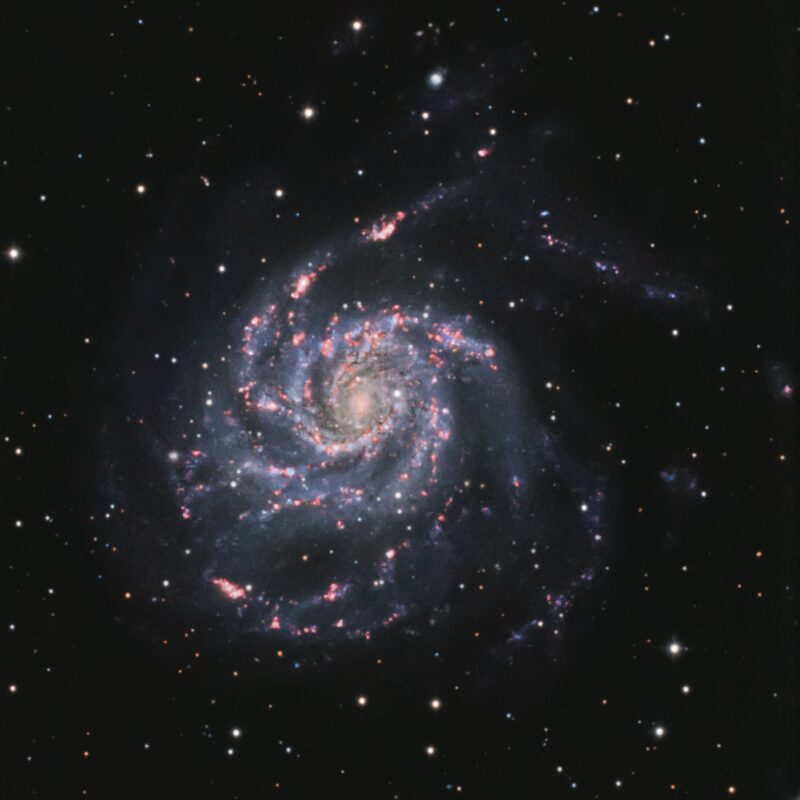 View at EarthSky Community Photos. | Andrea Iorio in Rome and Fernando Linsalata in Rimini, Italy, combined their data for this image of the Pinwheel galaxy (M101) on April 13. Andrea wrote: “The Pinwheel galaxy is a face-on spiral galaxy 21 million light-years from Earth in the constellation Ursa Major. The Pinwheel is a large galaxy, with a diameter of 170,000 light-years and around a trillion stars. It has many hydrogen-alpha regions (red spots in this image), created by large numbers of extremely bright and hot young stars.” Thank you, Andrea! See more of our editor’s picks from March’s deep-sky photos below.Stunning deep-sky photos from our community
View at EarthSky Community Photos. | Andrea Iorio in Rome and Fernando Linsalata in Rimini, Italy, combined their data for this image of the Pinwheel galaxy (M101) on April 13. Andrea wrote: “The Pinwheel galaxy is a face-on spiral galaxy 21 million light-years from Earth in the constellation Ursa Major. The Pinwheel is a large galaxy, with a diameter of 170,000 light-years and around a trillion stars. It has many hydrogen-alpha regions (red spots in this image), created by large numbers of extremely bright and hot young stars.” Thank you, Andrea! See more of our editor’s picks from March’s deep-sky photos below.Stunning deep-sky photos from our community
The EarthSky community has many talented astrophotographers who capture stunning images of the deep sky. So enjoy this gallery of some of the best deep-sky photos we received in April 2024. Do you have some of your own deep-sky images to share? You can submit them to us here. We love to see them!
Deep-sky photos of diffuse nebulae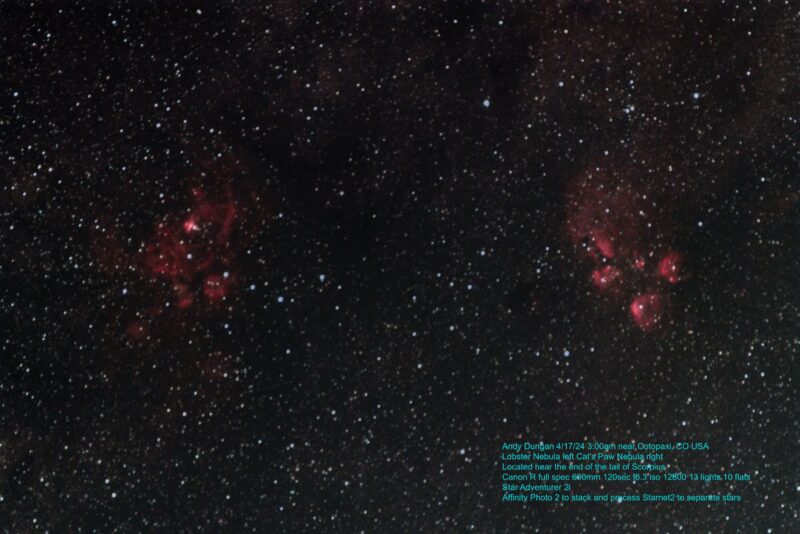 View at EarthSky Community Photos. | Andy Dungan near Cotopaxi, Colorado, captured this wide-field view of the constellation Scorpius the Scorpion on April 17. Andy wrote: “The Lobster nebula is on the left and the Cat’s Paw nebula on the right. Both are close to the end of the tail of the Scorpion. What fun to look at the night sky.” Thank you, Andy!
View at EarthSky Community Photos. | Andy Dungan near Cotopaxi, Colorado, captured this wide-field view of the constellation Scorpius the Scorpion on April 17. Andy wrote: “The Lobster nebula is on the left and the Cat’s Paw nebula on the right. Both are close to the end of the tail of the Scorpion. What fun to look at the night sky.” Thank you, Andy!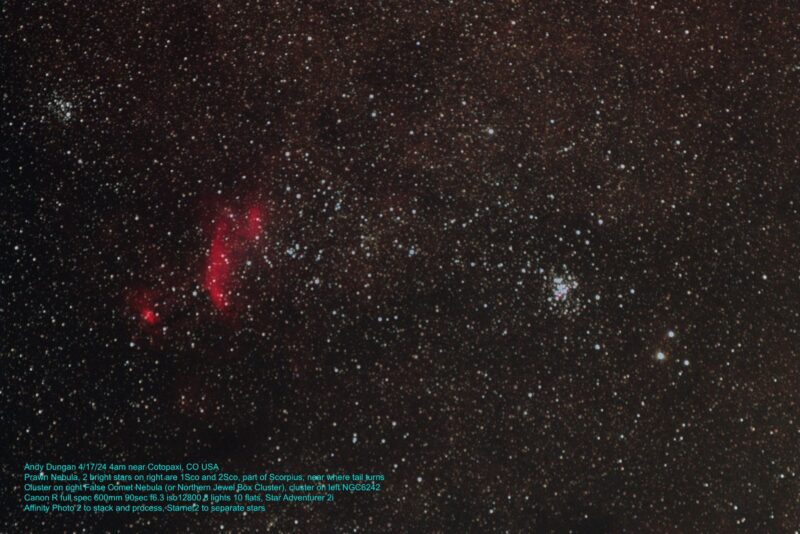 View at EarthSky Community Photos. | Andy Dungan near Cotopaxi, Colorado, also captured this wide-field view of Scorpius the Scorpion on April 17. Andy wrote: “The reddish glow is the Prawn nebula. Also, the 2 bright stars on the right are 1 Scorpii and 2 Scorpii. The False Comet cluster (or the Northern Jewel Box) is to their left. I had little time to take these pics. I started around 4 a.m. and astronomical twilight begins by 4:30 a.m. this time of year.” Thank you, Andy!The Orion Molecular Complex with passing rocket debris
View at EarthSky Community Photos. | Andy Dungan near Cotopaxi, Colorado, also captured this wide-field view of Scorpius the Scorpion on April 17. Andy wrote: “The reddish glow is the Prawn nebula. Also, the 2 bright stars on the right are 1 Scorpii and 2 Scorpii. The False Comet cluster (or the Northern Jewel Box) is to their left. I had little time to take these pics. I started around 4 a.m. and astronomical twilight begins by 4:30 a.m. this time of year.” Thank you, Andy!The Orion Molecular Complex with passing rocket debris
 View at EarthSky Community Photos. | Jason Dain in Doaktown, New Brunswick, Canada, caught this scene in the constellation Orion the Hunter on April 7. Jason wrote: “This appears to be an upper stage deorbit burn of the Falcon 9 rocket launch as it passes through Orion.” Thank you, Jason!Deep-sky photos of galaxies
View at EarthSky Community Photos. | Jason Dain in Doaktown, New Brunswick, Canada, caught this scene in the constellation Orion the Hunter on April 7. Jason wrote: “This appears to be an upper stage deorbit burn of the Falcon 9 rocket launch as it passes through Orion.” Thank you, Jason!Deep-sky photos of galaxies
 View at EarthSky Community Photos. | Ahmad Aliqabi in Alkut, Wasit, Iraq, captured this telescopic view of Messier 51 on April 6. Also known as the Whirlpool galaxy, it lies in the constellation Canes Venatici. Thank you, Ahmad!
View at EarthSky Community Photos. | Ahmad Aliqabi in Alkut, Wasit, Iraq, captured this telescopic view of Messier 51 on April 6. Also known as the Whirlpool galaxy, it lies in the constellation Canes Venatici. Thank you, Ahmad!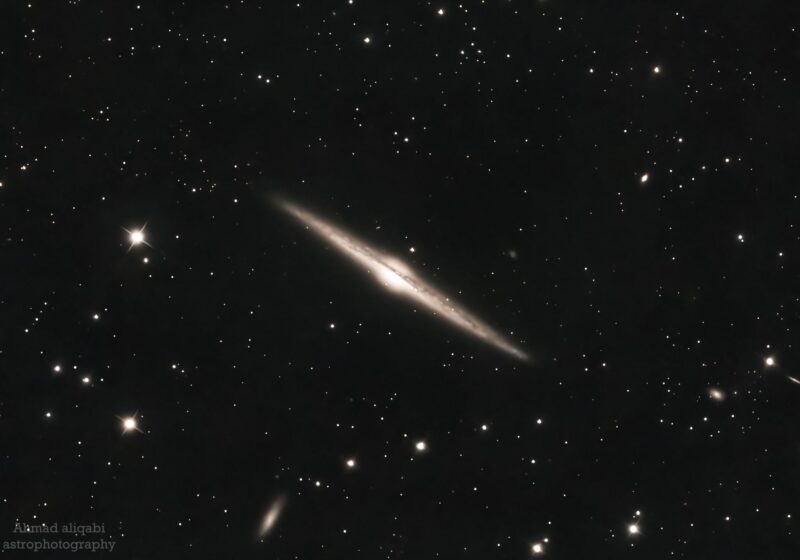 View at EarthSky Community Photos. | Ahmad Aliqabi in Alkut, Wasit, Iraq, also captured NGC 4565, the Needle galaxy, on April 6. It lies in the constellation Coma Berenices. Thank you, Ahmad!
View at EarthSky Community Photos. | Ahmad Aliqabi in Alkut, Wasit, Iraq, also captured NGC 4565, the Needle galaxy, on April 6. It lies in the constellation Coma Berenices. Thank you, Ahmad! View at EarthSky Community Photos. | Richard Cofer in Aiken, South Carolina, captured spiral galaxy Messier 88 in Coma Berenices on April 12. Thank you, Richard!Groups of galaxies
View at EarthSky Community Photos. | Richard Cofer in Aiken, South Carolina, captured spiral galaxy Messier 88 in Coma Berenices on April 12. Thank you, Richard!Groups of galaxies
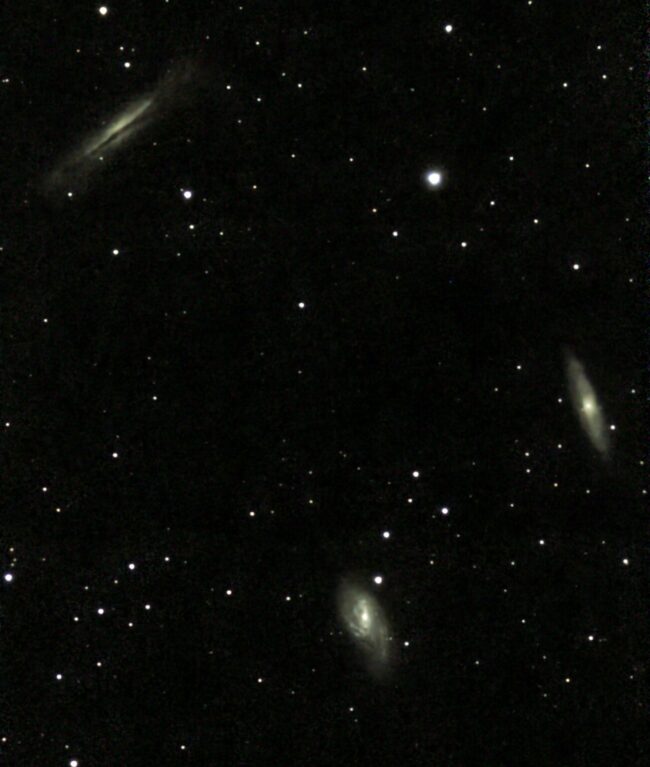 View at EarthSky Community Photos. | Fred Holman in Contoocook, New Hampshire, captured the Leo Triplet of galaxies on April 10. Fred wrote: “M65, M66 and NGC 3628 are a small group of galaxies about 35 million light-years away in the constellation Leo.” Thank you, Fred!
View at EarthSky Community Photos. | Fred Holman in Contoocook, New Hampshire, captured the Leo Triplet of galaxies on April 10. Fred wrote: “M65, M66 and NGC 3628 are a small group of galaxies about 35 million light-years away in the constellation Leo.” Thank you, Fred!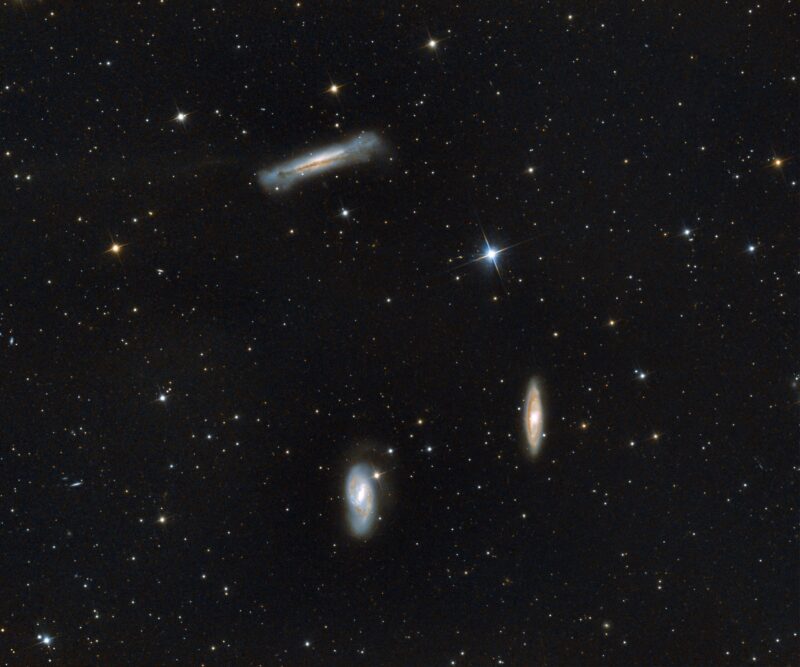 View at EarthSky Community Photos. | Mohamed Al Adhamei in Kut, Iraq, also captured the Leo Triplet on April 5. Mohamed wrote: “NGC 3628 (top) is a spiral galaxy 5 million light-years away. William Herschel discovered it in 1784. It extends over approximately 300,000 light-years.” Thank you, Mohamed!
View at EarthSky Community Photos. | Mohamed Al Adhamei in Kut, Iraq, also captured the Leo Triplet on April 5. Mohamed wrote: “NGC 3628 (top) is a spiral galaxy 5 million light-years away. William Herschel discovered it in 1784. It extends over approximately 300,000 light-years.” Thank you, Mohamed!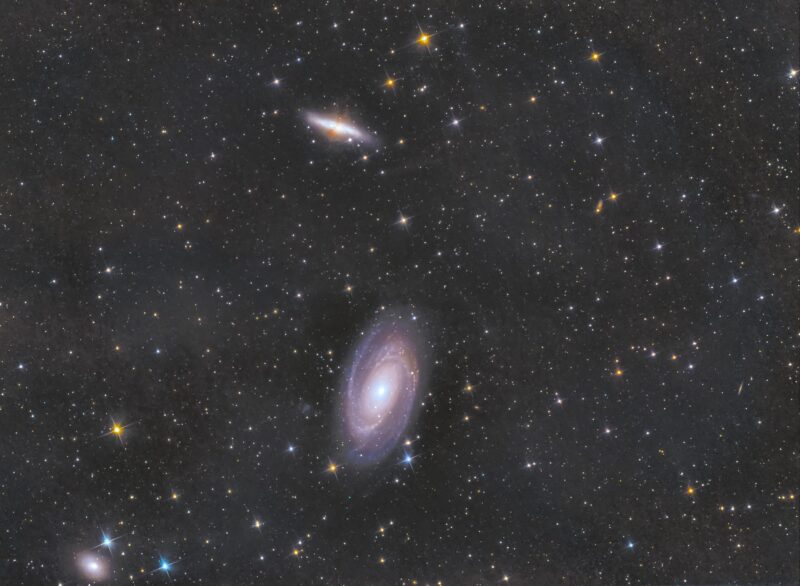 View at EarthSky Community Photos. | Mohamed Al Adhamei in Kut, Iraq, captured galaxies M81 and M82 in Ursa Major on April 12. Mohamed wrote: “The Cigar galaxy (M82, top) is 12 million light-years away. Scientists expect a future collision and merger between this galaxy and the larger M81.” Thank you, Mohamed!
View at EarthSky Community Photos. | Mohamed Al Adhamei in Kut, Iraq, captured galaxies M81 and M82 in Ursa Major on April 12. Mohamed wrote: “The Cigar galaxy (M82, top) is 12 million light-years away. Scientists expect a future collision and merger between this galaxy and the larger M81.” Thank you, Mohamed! View at EarthSky Community Photos. | Ron Haggett in Yuma, Arizona, captured these galaxies on April 3. Ron wrote: “Markarian’s Chain is a stretch of galaxies that forms part of the Virgo Cluster. When viewed from Earth, the galaxies lie along a smoothly curved line. Near the center are a pair of interacting galaxies about 50 million light-years away, known as Markarian’s Eyes.” Thank you, Ron!And a supernova in a distant galaxy
View at EarthSky Community Photos. | Ron Haggett in Yuma, Arizona, captured these galaxies on April 3. Ron wrote: “Markarian’s Chain is a stretch of galaxies that forms part of the Virgo Cluster. When viewed from Earth, the galaxies lie along a smoothly curved line. Near the center are a pair of interacting galaxies about 50 million light-years away, known as Markarian’s Eyes.” Thank you, Ron!And a supernova in a distant galaxy
 View at EarthSky Community Photos. | Eliot Herman of Tucson, Arizona, used a large remote telescope in Australia to capture a supernova. This is supernova 2024 ggi in the constellation Hydra the Water Snake from April 14, just 3 days after its discovery. Eliot wrote: “New supernova in a galaxy that is relatively close. This supernova is continuing to brighten, to be the brightest of 2024 to date.” Thank you, Eliot!
View at EarthSky Community Photos. | Eliot Herman of Tucson, Arizona, used a large remote telescope in Australia to capture a supernova. This is supernova 2024 ggi in the constellation Hydra the Water Snake from April 14, just 3 days after its discovery. Eliot wrote: “New supernova in a galaxy that is relatively close. This supernova is continuing to brighten, to be the brightest of 2024 to date.” Thank you, Eliot!Bottom line: Enjoy this gallery of deep-sky photos for April 2024 from our EarthSky community. And if you have a great photo to share, send it in. We love to see them!
Share your recent Earth or sky photo at EarthSky Community Photos.
The post Deep-sky photos for April 2024: Editor’s picks first appeared on EarthSky.
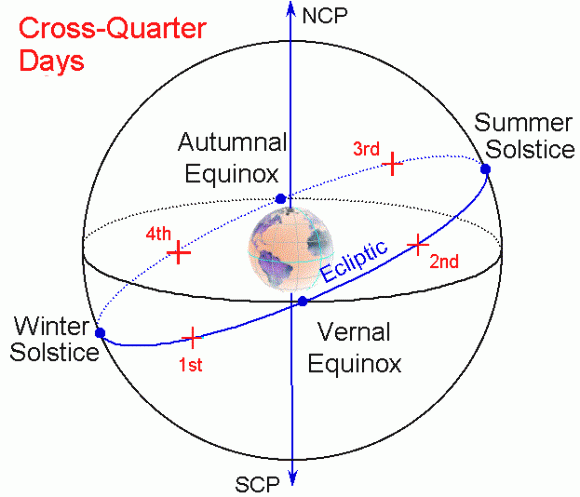 Equinoxes, solstices and cross-quarter days are all hallmarks of Earth’s orbit around the sun. May Day is the 2nd cross-quarter day of the year. Illustration via NASA.
May Day is May 1
Equinoxes, solstices and cross-quarter days are all hallmarks of Earth’s orbit around the sun. May Day is the 2nd cross-quarter day of the year. Illustration via NASA.
May Day is May 1
You might not realize it, but May Day – an ancient spring festival in the Northern Hemisphere – is an astronomy holiday. It’s one of the year’s four cross-quarter days. That is, it’s a day that falls more or less midway between an equinox and solstice. In this case, it’s between the March equinox and June solstice.
The other cross-quarter days are Groundhog Day on February 2, Lammas on August 1, and Halloween on October 31.
May Day also stems from the Celtic festival of Beltane. It was related to the waxing power of the sun as we in the Northern Hemisphere move closer to summer. At Beltane, people drove livestock through lit fires and people danced around them. They were all moving in the same direction that the sun crosses the sky.
In Hawaii, May Day is Lei Day, a statewide celebration of the aloha spirit and the giving of the flower lei.
May Day and maypolesOf course, wrapping a maypole with colorful ribbons is perhaps the best known of all May Day traditions. In the Middle Ages, English villages all had maypoles. They were part of the rejoicing and raucous merrymaking of May Day.
Maypoles came in many sizes. And there was competition among the villages to show whose maypole was the tallest. In small towns, maypoles were usually set up for the day. But they were erected permanently in London and the larger towns.
Here’s a WikiHow on how to do a maypole dance
 A May Day celebration showing children dancing around a maypole. This took place on the Village Green in Tewin, near Welwyn Garden City, United Kingdom. Image via Paul Barnett/ Wikimedia Commons. (CC BY-SA 2.0 DEED).
A May Day celebration showing children dancing around a maypole. This took place on the Village Green in Tewin, near Welwyn Garden City, United Kingdom. Image via Paul Barnett/ Wikimedia Commons. (CC BY-SA 2.0 DEED). Maypole dancing at the village’s fair at Bishopstone, East Sussex, with the tower of St Andrew’s parish church in the background. Image via Kevin Gordon/ Wikimedia Commons (CC BY-SA 2.0 DEED).May baskets can brighten someone’s day
Maypole dancing at the village’s fair at Bishopstone, East Sussex, with the tower of St Andrew’s parish church in the background. Image via Kevin Gordon/ Wikimedia Commons (CC BY-SA 2.0 DEED).May baskets can brighten someone’s day
We’re not too far away from a time in the late 20th century when people left homemade May baskets filled with spring flowers and sweets on others’ doorsteps, usually anonymously. I can remember doing this as a child. Maybe it’s a tradition that can be revived.
I love this for a May craft for kids! #maydayhttps://t.co/00NGF4L1I8
— HomeschoolSuperFreak (@HSSuperFreak) April 18, 2023
Bottom line: May 1 is one of four cross-quarter days, midway between an equinox and a solstice. So, happy May Day 2024!
Read more: Halloween is a cross-quarter day
Read more: Groundhog Day is an astronomy holiday
The post Happy May Day! Today is an astronomy holiday first appeared on EarthSky.
 The radiant point of the Eta Aquariid meteor shower is near the star Eta Aquarii in the constellation Aquarius the Water Bearer. The radiant, where meteors appear to stream from, rises in the wee hours after midnight and is still climbing toward its highest point at dawn. That highest point is in the south as viewed from the Northern Hemisphere, and closer to overhead for the Southern Hemisphere. That’s why the Southern Hemisphere sees more meteors (the radiant is higher up), and it’s why – for all of us around the globe – the hours before dawn are best for this shower.
The radiant point of the Eta Aquariid meteor shower is near the star Eta Aquarii in the constellation Aquarius the Water Bearer. The radiant, where meteors appear to stream from, rises in the wee hours after midnight and is still climbing toward its highest point at dawn. That highest point is in the south as viewed from the Northern Hemisphere, and closer to overhead for the Southern Hemisphere. That’s why the Southern Hemisphere sees more meteors (the radiant is higher up), and it’s why – for all of us around the globe – the hours before dawn are best for this shower.The famous Eta Aquariid meteor shower – one of the year’s major meteor showers – peaks every year in early May. In 2024, the peak centers around May 5 and 6. You will probably see more meteors from Earth’s Southern Hemisphere than Northern Hemisphere. Why?
Eta aquariid meteors stream from the constellation AquariusIf you traced the paths of Eta Aquariid meteors backward on the sky’s dome, you’d find that these meteors appear to stream from an asterism, or recognizable pattern of stars, known as the Water Jar in the constellation Aquarius the Water Bearer. See chart at the top of this post.
This spot in the sky is the radiant point of the Eta Aquariid meteor shower. The meteors seem to emanate from the vicinity of the Water Jar, before spreading out and appearing in all parts of the sky.
Water Jar rises about the same time worldwideBecause the Water Jar is on the celestial equator – an imaginary great circle directly above the Earth’s equator – the radiant of the Eta Aquariid shower rises due east as seen from all over the world. Moreover, the radiant rises at about the same time worldwide, around 1:40 a.m. local time (2:40 a.m. daylight-saving-time) in early May, around the shower’s typical peak date.
So you’d think the shower would be about the same as seen from around the globe. But it’s not.
The sun rises later in the Southern HemisphereThe reason it’s not is that sunrise comes later to the Southern Hemisphere (where it’s autumn in May) and earlier to the Northern Hemisphere (where it’s spring in May).
A later sunrise means more dark time to watch meteors. And it also means the radiant point of the Eta Aquariid shower has a chance to climb higher into the predawn sky as seen from more southerly latitudes. That’s why the tropics and southern temperate latitudes tend to see more Eta Aquariid meteors than we do at mid-northern latitudes.
Cruise to a southerly latitude, anyone?
Everything you need to know: Eta Aquariid meteor shower
Do you still have questions?EarthSky’s Deborah Byrd and Kelly Kizer Whitt took some time yesterday to chat about questions from our readers and viewers about this meteor shower. Eta Aquariid Q and A here!
Bottom line: Everyone around the globe can enjoy the Eta Aquariid meteor shower in early May. Best for the Southern Hemisphere! The peak in 2024 is on the mornings of May 5 and 6.
Read more: EarthSky’s annual meteor shower guide
The post Eta Aquariid meteors are richer from the Southern Hemisphere first appeared on EarthSky.
 On April 28, 2024, a Falcon 9 rocket delivered 23 more SpaceX Starlink satellites to low-Earth orbit. Image via SpaceX.Upcoming SpaceX Starlink launches in May 2024
On April 28, 2024, a Falcon 9 rocket delivered 23 more SpaceX Starlink satellites to low-Earth orbit. Image via SpaceX.Upcoming SpaceX Starlink launches in May 2024
Starlink Group 6-55: May 2, 2024, 9:17 pm – 1:48 am EDT
Falcon 9 Block 5 | Cape Canaveral Space Force Station, Florida | DATE/TIME MAY CHANGE
Starlink Group 8-2: May 3, 2024, 7:59 pm – 12:30 am PDT
Falcon 9 Block 5 | Vandenberg Space Force Station, California | DATE/TIME MAY CHANGE
Starlink Group 6-56: May 6, 2024, 11:34 am – 3:34 pm EDT
Falcon 9 Block 5 | Cape Canaveral Space Force Station, Florida | DATE/TIME MAY CHANGE
Starlink Group 6-57: May 7, 2024, 6:09 pm – 10:09 pm EDT
Falcon 9 Block 5 | Kennedy Space Center, Florida | DATE/TIME MAY CHANGE
Starlink Group 7-28: May 2024, Time & Date TBD
Falcon 9 Block 5 | Cape Canaveral Space Force Station, Florida | DATE/TIME MAY CHANGE
Starlink Group 7-29: May 2024, Time & Date TBD
Falcon 9 Block 5 | Cape Canaveral Space Force Station, Florida | DATE/TIME MAY CHANGE
Starlink Group 8-3: May 2024, Time & Date TBD
Falcon 9 Block 5 | Vandenberg Space Force Station, California | DATE/TIME MAY CHANGE
Starlink Group 8-4: May 2024, Time & Date TBD
Falcon 9 Block 5 | Cape Canaveral Space Force Station, Florida | DATE/TIME MAY CHANGE
Starlink Group 8-5: May 2024, Time & Date TBD
Falcon 9 Block 5 | Cape Canaveral Space Force Station, Florida | DATE/TIME MAY CHANGE
Starlink Group 7-30: May 2024, Time & Date TBD
Falcon 9 Block 5 | Cape Canaveral Space Force Station, Florida | DATE/TIME MAY CHANGE
Starlink Group 7-19: May 2024, Time & Date TBD
Falcon 9 Block 5 | Vandenberg Space Force Station, California | DATE/TIME MAY CHANGE
Starlink Group 7-20: May 2024, Time & Date TBD
Falcon 9 Block 5 | Vandenberg Space Force Station, California | DATE/TIME MAY CHANGE
Starlink Group 7-21: May 2024, Time & Date TBD
Falcon 9 Block 5 | Vandenberg Space Force Station, California | DATE/TIME MAY CHANGE
Starlink Group 7-22: May 2024, Time & Date TBD
Falcon 9 Block 5 | Vandenberg Space Force Station, California | DATE/TIME MAY CHANGE
Starlink Group 7-23: May 2024, Time & Date TBD
Falcon 9 Block 5 | Vandenberg Space Force Station, California | DATE/TIME MAY CHANGE
Starlink Group 7-24: May 2024, Time & Date TBD
Falcon 9 Block 5 | Vandenberg Space Force Station, California | DATE/TIME MAY CHANGE
Starlink Group 7-25: May 2024, Time & Date TBD
Falcon 9 Block 5 | Cape Canaveral Space Force Station, Florida | DATE/TIME MAY CHANGE
Starlink Group 7-26: May 2024, Time & Date TBD
Falcon 9 Block 5 | Cape Canaveral Space Force Station, Florida | DATE/TIME MAY CHANGE
Starlink Group 7-27: May 2024, Time & Date TBD
Falcon 9 Block 5 | Cape Canaveral Space Force Station, Florida | DATE/TIME MAY CHANGE
You can watch a livestream of the Starlink launches on SpaceX’s X account.
Watch this space for updates!
After launch, look for a train of lightsFollowing every Starlink launch, the internet buzzes with people asking:
What’s that long line of lights in the sky that looks like a train?
What you’re seeing is the Starlink satellites moving into a higher orbit. You can check to see if they will pass over your area using the Find Starlink website.
Growing numbers amid controversyAccording to Wikipedia, as of early March 2024, Starlink consists of over 6,000 mass-produced small satellites in low Earth orbit that communicate with designated ground transceivers. They provide internet access to more than 2 million subscribers.
Love ’em or hate ’em, these Starlink satellites are part of SpaceX’s vision for a global internet communication satellite constellation. They deliver high-speed internet service worldwide, mainly to locations where ground-based internet is unreliable, unavailable or expensive. The private company is well-known for launching batches back-to-back, several times a month, regularly lofting 60 satellites at a time. And SpaceX plans to build up to perhaps as many as 30,000 eventually.
Most thought it was exciting to see the first few Starlink satellites traveling together in the night sky. But then more were launched, and then more. And astronomers began to worry.
Because Starlinks are bright, astronomers say they’re photobombing astronomical images. Therefore, they have the potential to interfere with the professional astronomical observations that have brought us our modern-day view of the cosmos. And although SpaceX has tried to address the issue, they remain far from what astronomers say is acceptable.
Bottom line: Get a list of all the SpaceX Starlink launches for May 2024 from both the West and East Coasts. Find out how to watch the livestream, and get updates, too.
Read more from EarthSky: Starlink satellites can look like a plume or train of light
The post List of SpaceX Starlink launches for May 2024 first appeared on EarthSky.
Up next is the Eta Aquariid meteor shower before dawn on May 5 and 6.
May 2024 meteors … the Eta AquariidsWhen to watch: New moon will fall a few days after the peak of the 2024 Eta Aquariid shower. So, mornings around the peak will be dark and moonless. The best mornings to watch are May 5 and 6, 2024, in the hours before dawn. Why before dawn? See “Radiant” below.The American Meteor Society is listing 8:43 UTC on May 5 as the shower’s predicted** peak time. But times vary between different experts. And the peak of this shower stretches out over several days. So you can expect elevated numbers of meteors a few days before and after the peak time.
Nearest moon phase: New moon will fall at 03:22 UTC on May 8. So a thin waning crescent moon will not obscure the 2024 Eta Aquariids on the mornings around the predicted peak.
Radiant: Will rise in the wee hours, climbing toward its highest point at dawn. That’s why before dawn will be the best time to watch this shower.
Duration of shower: April 15 to May 27.
Expected meteors at peak, under ideal conditions: In the southern half of the U.S., you might see 10 to 20 meteors per hour under a dark sky, with no moon, when the radiant is high in the sky. Farther south – at latitudes in the Southern Hemisphere – you might see two to three times that number.
Note: The Eta Aquariids’ radiant will be on the ecliptic, which will ride low in the sky on spring mornings as seen from the Northern Hemisphere. That’s why this shower favors the Southern Hemisphere. It’s often that hemisphere’s best meteor shower of the year.
Read more: All you need to know about Eta Aquariid meteors
 The radiant point of the Eta Aquariid meteor shower will be near the star Eta Aquarii in the constellation Aquarius the Water Bearer. The radiant will rise in the wee hours after midnight and will continue climbing toward its highest point at dawn. That highest point will be in the south as viewed from the Northern Hemisphere, closer to overhead for the Southern Hemisphere. That’s why the Southern Hemisphere will see more meteors (the radiant will be higher up), and it’s why – for all of us around the globe – the hours before dawn will be best for this shower.June 2024 daytime meteor shower … the Arietids
The radiant point of the Eta Aquariid meteor shower will be near the star Eta Aquarii in the constellation Aquarius the Water Bearer. The radiant will rise in the wee hours after midnight and will continue climbing toward its highest point at dawn. That highest point will be in the south as viewed from the Northern Hemisphere, closer to overhead for the Southern Hemisphere. That’s why the Southern Hemisphere will see more meteors (the radiant will be higher up), and it’s why – for all of us around the globe – the hours before dawn will be best for this shower.June 2024 daytime meteor shower … the Arietids
Most meteor showers are easy to observe. Just find a dark sky, and look up! But what about meteor showers that happen in the daytime, when the sun is up? The Arietids are sometimes said to be the most active daytime meteor shower. In 2024, their predicted** peak will be the morning of June 7. You might catch some Arietids that morning in the dark hour before dawn.
When to watch: Watch from May 29 to June 17. There’s a predicted** peak on June 7, 2024. Watch for them in the sunrise direction in the dark hour before dawn breaks.
Nearest moon phase: In 2024, a new moon occurs at 12:38 UTC on June 6. So the mornings around the peak will be completely moon free.
Radiant: The shower’s radiant point – the point in the sky from which the meteors appear to radiate – is in the constellation Aries the Ram. You’ll find this constellation in the east before sunrise.
Duration of shower: May 29 to June 17.
Expected meteors at peak: This is tricky for daytime meteor showers because once the sun comes up, you won’t be able to see them. But the Arietids have a strong zenithal hourly rate (ZHR)! Meteor counts with radar and radio echoes have indicated a rate of 60 meteors per hour, and perhaps as high as 200 meteors per hour.
Note: The Arietids are sometimes said to be the most active daytime meteor shower.
Read more: Arietids, most active daytime meteor shower
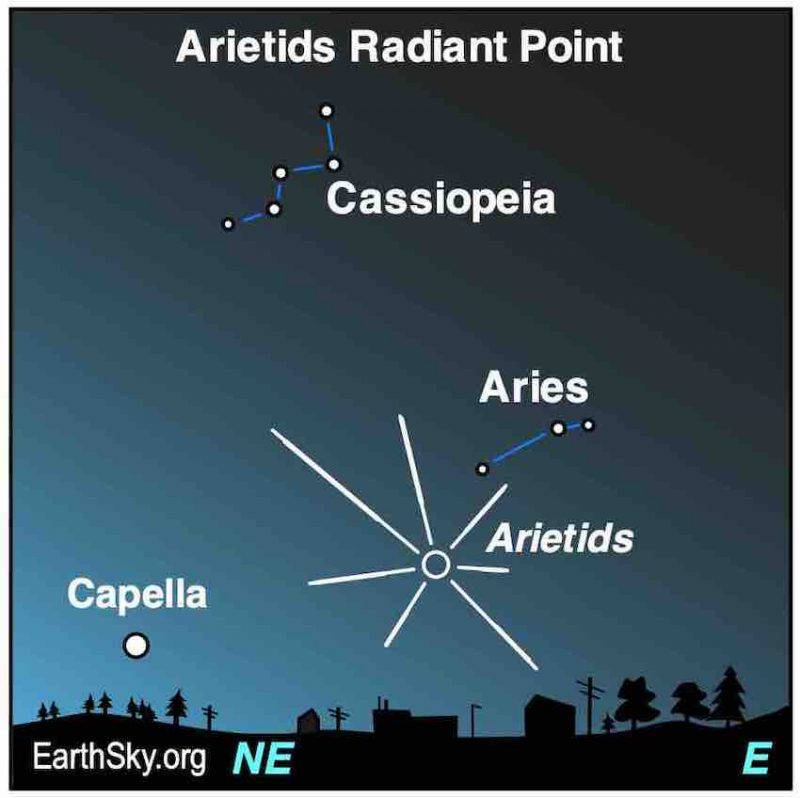 The Arietids are an active shower, but they’re visible mostly in daytime. Watch for them in the sunrise direction in the dark hour before dawn from May 29 to June 17. You’ll be looking for meteors that shoot up from the horizon. The radiant is below the constellation Aries the Ram. Chart by John Jardine Goss.Late July to mid-August 2024 meteors … the Delta Aquariids
The Arietids are an active shower, but they’re visible mostly in daytime. Watch for them in the sunrise direction in the dark hour before dawn from May 29 to June 17. You’ll be looking for meteors that shoot up from the horizon. The radiant is below the constellation Aries the Ram. Chart by John Jardine Goss.Late July to mid-August 2024 meteors … the Delta Aquariids
Predicted peak: The peak is predicted** for July 30, 2024, at 15:16 UTC. But this shower doesn’t have a noticeable peak. It rambles along steadily from late July through early August, joining forces with the August Perseids.
When to watch: Watch late July through early August, mid-evening to dawn.
Duration of shower: July 18 to August 21.
Radiant: Rises in mid-evening, highest around 2 a.m. and low in the sky by dawn. See chart below.
Nearest moon phase: In 2024, last quarter moon falls at 2:52 UTC on July 28. Take advantage of the moon-free evenings in late July for watching the Delta Aquariids (and the early Perseids).
Expected meteors at peak, under ideal conditions: The Delta Aquariids’ maximum hourly rate can reach 15 to 20 meteors in a dark sky with no moon. You’ll typically see plenty of Delta Aquariids mixed in with the Perseids, if you’re watching in early August.
Note: Like May’s Eta Aquariids, July’s Delta Aquariids favors the Southern Hemisphere. Skywatchers at high northern latitudes tend to discount it. But the shower can be excellent from latitudes like those in the southern U.S. Delta Aquariid meteors tend to be fainter than Perseid meteors. So a moon-free dark sky is essential. About 5% to 10% of the Delta Aquariid meteors leave persistent trains, glowing ionized gas trails that last a second or two after the meteor has passed.
Read more: All you need to know about Delta Aquariid meteors
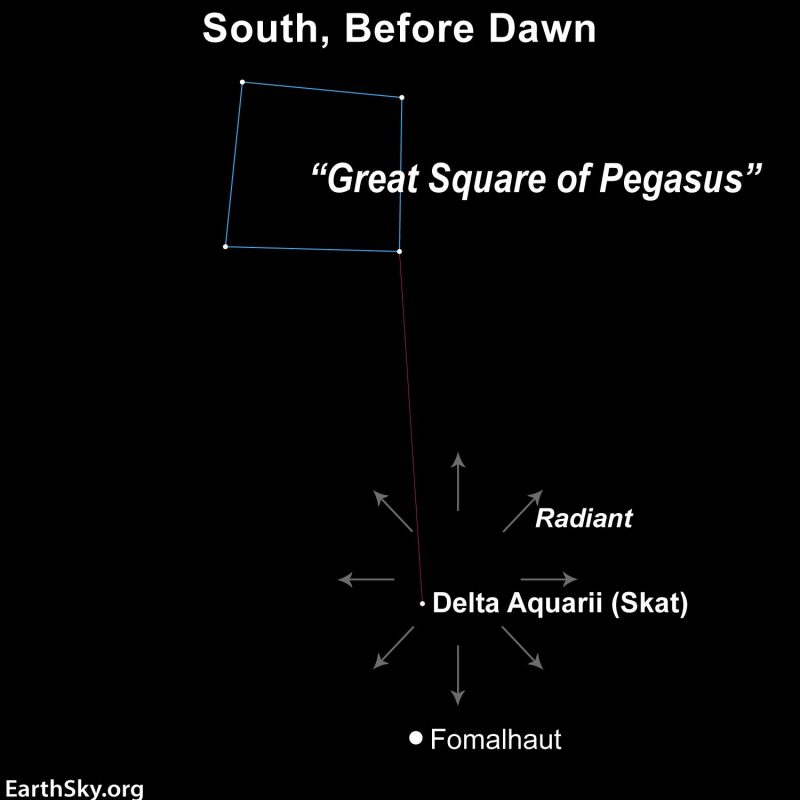 Delta Aquariid meteors radiate from near the star Skat, aka Delta Aquarii, in the constellation Aquarius the Water Bearer. This star is near bright Fomalhaut. In late July to early August, Fomalhaut is highest around 2 a.m. (on your clock no matter where you are). It’s southward from the Northern Hemisphere, closer to overhead from the Southern Hemisphere. Fomalhaut appears bright and solitary in the sky. To find it, draw a line roughly southward through the stars on the west side of the Great Square of Pegasus.Mid-July to mid-August 2024 meteors … the Perseids
Delta Aquariid meteors radiate from near the star Skat, aka Delta Aquarii, in the constellation Aquarius the Water Bearer. This star is near bright Fomalhaut. In late July to early August, Fomalhaut is highest around 2 a.m. (on your clock no matter where you are). It’s southward from the Northern Hemisphere, closer to overhead from the Southern Hemisphere. Fomalhaut appears bright and solitary in the sky. To find it, draw a line roughly southward through the stars on the west side of the Great Square of Pegasus.Mid-July to mid-August 2024 meteors … the Perseids
Predicted peak: The peak is predicted** for August 12, 2024, at 14:00 UTC. So the mornings of August 11, 12 and 13 are probably your best bet.
When to watch: The moon will be a 1st quarter and 50% illuminated during 2024’s peak of the Perseid meteor shower. So the best time to watch for Perseids will be starting around midnight until dawn. This shower rises to a peak gradually, then falls off rapidly. And Perseid meteors tend to strengthen in number as late night deepens into the wee hours before dawn. The shower is often best just before dawn.
Radiant: The radiant rises in the middle of the night and is highest at dawn. See chart below.
Nearest moon phase: First quarter moon falls at 15:19 UTC on August 12. And a 1st quarter moon sets around midnight, so you’ll have dark skies after then until dawn.
Duration of shower: July 14 to September 1.
Expected meteors at peak, under ideal conditions: Under a dark sky with no moon, skywatchers frequently report 90 meteors per hour, or more. The August Perseid meteor shower is rich and steady, from early August through the peak. The meteors are colorful. And they frequently leave persistent trains. All of these factors make the Perseid shower perhaps the most beloved meteor shower for the Northern Hemisphere.
Read more: All you need to know about Perseid meteors
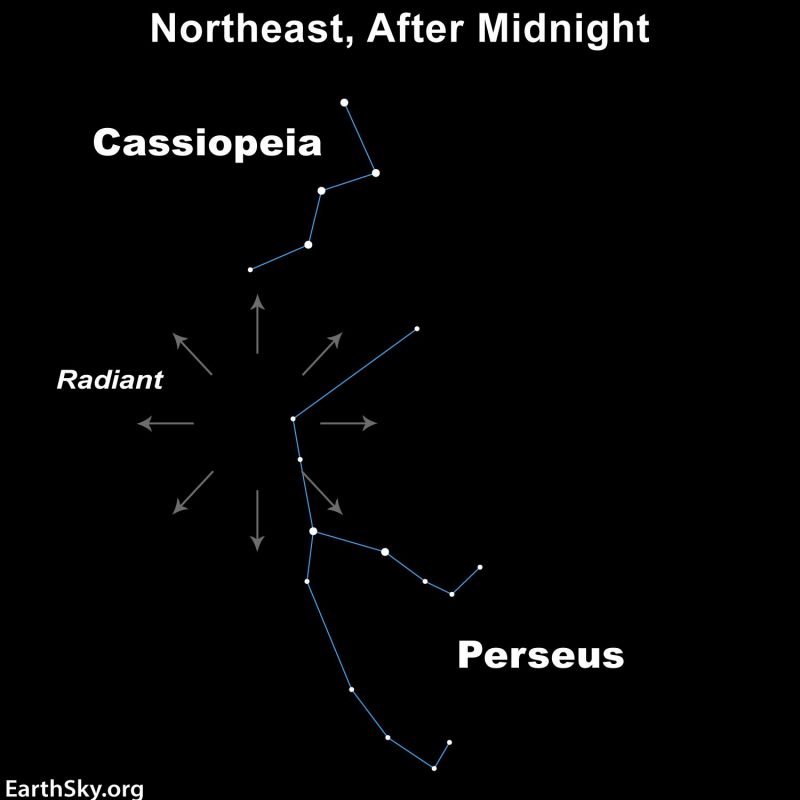 Perseid meteors radiate from a point in the constellation Perseus the Hero. The radiant rises in late evening and is highest at dawn. Remember … you don’t have to find a shower’s radiant point to see meteors. The meteors will be flying in all parts of the sky.Early October meteors … the Draconids
Perseid meteors radiate from a point in the constellation Perseus the Hero. The radiant rises in late evening and is highest at dawn. Remember … you don’t have to find a shower’s radiant point to see meteors. The meteors will be flying in all parts of the sky.Early October meteors … the Draconids
Predicted peak: The peak is predicted** for October 8, 2024, at 3 UTC.
When to watch: The best time to watch the Draconids in 2024 is the evening of October 7 through the wee hours of the morning on October 8. The waxing crescent moon (27% illuminated) will set before 9 p.m. your local time. So you can watch for meteors in a moonless sky.
Overall duration of shower: October 6 through 10.
Radiant: Highest in the sky in the evening hours. See chart below.
Nearest moon phase: First quarter moon is 18:55 UTC on October 10.
Expected meteors at peak, under ideal conditions: Under a dark sky with no moon, you might catch 10 Draconid meteors per hour.
Note: The Draconid shower is a real oddity, in that the radiant point stands highest in the sky as darkness falls. That means that, unlike many meteor showers, more Draconids are likely to fly in the evening hours than in the morning hours after midnight. This shower is usually a sleeper, producing only a handful of languid meteors per hour in most years. But watch out if the Dragon awakes! In rare instances, fiery Draco has been known to spew forth many hundreds of meteors in a single hour. That possibility keeps many skywatchers outside – even in moonlight – during this shower.
Read more: All you need to know about Draconid meteors
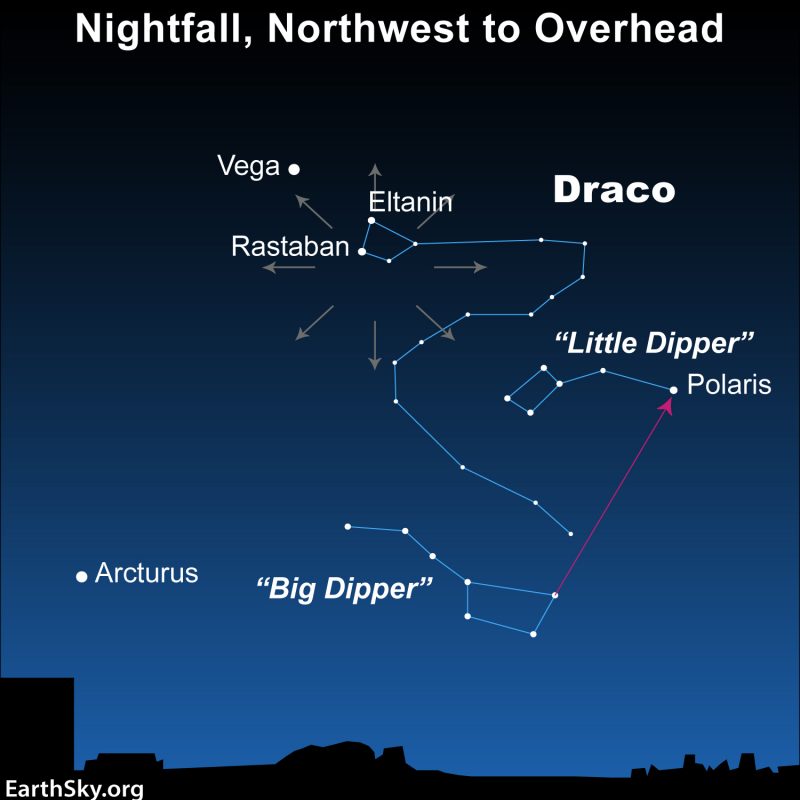 The radiant point for the Draconid meteor shower almost coincides with the head of the constellation Draco the Dragon in the northern sky. That’s why you can view the Draconids best from the Northern Hemisphere. This chart faces northward at nightfall in October. The Big Dipper sits low in the northwest. From the southern U.S. and comparable latitudes, in October, obstructions on your northern horizon might hide the Big Dipper from view. From farther south – say, the Southern Hemisphere – you won’t see the Dipper at all in the evening at this time of year. But, if you can spot it low in the sky, use the Big Dipper to star-hop to the star Polaris. Polaris marks the end star in the handle of the Little Dipper. Got all these stars? Then you should also be able to spot Eltanin and Rastaban, the Draconids’ radiant point, high in the northwest sky at nightfall in early October. Draconid meteors radiate from near these stars, which are known as the Dragon’s Eyes.Late October meteors … the Orionids
The radiant point for the Draconid meteor shower almost coincides with the head of the constellation Draco the Dragon in the northern sky. That’s why you can view the Draconids best from the Northern Hemisphere. This chart faces northward at nightfall in October. The Big Dipper sits low in the northwest. From the southern U.S. and comparable latitudes, in October, obstructions on your northern horizon might hide the Big Dipper from view. From farther south – say, the Southern Hemisphere – you won’t see the Dipper at all in the evening at this time of year. But, if you can spot it low in the sky, use the Big Dipper to star-hop to the star Polaris. Polaris marks the end star in the handle of the Little Dipper. Got all these stars? Then you should also be able to spot Eltanin and Rastaban, the Draconids’ radiant point, high in the northwest sky at nightfall in early October. Draconid meteors radiate from near these stars, which are known as the Dragon’s Eyes.Late October meteors … the Orionids
Predicted peak: The peak is predicted** for October 20, 2024, at 18:14 UTC.
When to watch: Watch for Orionid meteors on both the mornings of October 20 and 21, starting after midnight through the wee hours before dawn.
Overall duration of shower: September 26 to November 22.
Radiant: The radiant rises before midnight and is highest in the sky around 2 a.m. See chart below.
Nearest moon phase: The full moon falls at 11:26 UTC on October 17. So, at the Orionids’ peak, the the waning gibbous moon will interfere with the meteor shower.
Expected meteors at peak, under ideal conditions: Under a dark sky with no moon, the Orionids exhibit a maximum of about 10 to 20 meteors per hour.
Note: These fast-moving meteors occasionally leave persistent trains. The Orionids sometimes produce bright fireballs.
Read more: Everything you need to know Orionid meteors
 If you trace Orionid meteors backward on the sky’s dome, they seem to radiate from the upraised club of the famous constellation Orion the Hunter. This is the shower’s radiant point. The bright star near the radiant point is reddish Betelgeuse. Chart via Chelynne Campion/ EarthSky.October into early November … the South and North Taurids
If you trace Orionid meteors backward on the sky’s dome, they seem to radiate from the upraised club of the famous constellation Orion the Hunter. This is the shower’s radiant point. The bright star near the radiant point is reddish Betelgeuse. Chart via Chelynne Campion/ EarthSky.October into early November … the South and North Taurids
Predicted peak: The South Taurids’ predicted** peak is November 5, 2024, at 7:00 UTC. The North Taurids’ predicted** peak is November 12, 2024, at 6:00 UTC. Both the South and North Taurids don’t have very definite peaks. They ramble along in October and November and are especially noticeable from late October into early November, when they overlap.
When to watch: Best around midnight, and on the days around November 5 when the moon won’t interfere.
Overall duration of shower: The South Taurids run from about September 23 to November 12. North Taurids are active from about October 13 to December 2.
Radiant: Rises in early evening, highest in the sky around midnight. See chart below.
Nearest moon phases: In 2024, the first quarter moon falls at 5:55 UTC on November 9. The new moon is at 12:47 UTC on November 1, and it’s before the predicted peak of the South Taurids on November 5, so the days around then will be the best days to watch for Taurid meteors. However, the waxing crescent moon – 3 days before a full moon at 21:29 UTC on November 15 – will interfere with most meteors around the November 12 peak of the North Taurids. You’ll catch Taurid meteors throughout October and November. Visit Sunrise Sunset Calendars to see moon rising times for your location. Be sure to check the moon rising time box.
Expected meteors at peak, under ideal conditions: Under dark skies with no moon, both the South and North Taurid meteor showers produce about five meteors per hour (10 total when they overlap). Also, watch for fireballs.
Note: Taurid meteors tend to be slow-moving but sometimes very bright. The showers sometimes produce fireballs, which made their cyclical reappearance in 2022. The American Meteor Society pointed to “a seven-year periodicity” with Taurid fireballs. 2008 and 2015 both produced them. 2022 did as well. The Taurid fireball display, in 2015, was really fun! Photos and video of 2015 Taurid fireballs here.
Read more: All you need to know about the Taurid meteors
 The Taurid meteors consist of 2 streams, the South Taurid meteors and North Taurid meteors. Both streams appear to originate from the constellation Taurus the Bull. Typically, you see the maximum numbers at or around midnight, when Taurus is highest in the sky.Mid-November meteors … the Leonids
The Taurid meteors consist of 2 streams, the South Taurid meteors and North Taurid meteors. Both streams appear to originate from the constellation Taurus the Bull. Typically, you see the maximum numbers at or around midnight, when Taurus is highest in the sky.Mid-November meteors … the Leonids
https://earthsky.org/wp-admin/edit.php
Predicted peak: The peak is predicted** for November 18, 2024, at 5:00 UTC.
When to watch: Watch late on the night of November 17 until dawn on November 18. The morning of November 17 might be worthwhile, too.
Duration of shower: November 3 through December 2.
Radiant: Rises around midnight, highest in the sky at dawn.
Nearest moon phase: In 2024, the full moon falls at 21:29 UTC on November 15. So the bright waning gibbous moon will wash out some meteors in 2024.
Expected meteors at peak, under ideal conditions: Under a dark sky with no moon, you might see 10 to 15 Leonid meteors per hour.
Note: The famous Leonid meteor shower produced one of the greatest meteor storms in living memory. Rates were as high as thousands of meteors per minute during a 15-minute span on the morning of November 17, 1966. That night, Leonid meteors did, briefly, fall like rain. Some who witnessed it had a strong impression of Earth moving through space, fording the meteor stream. Leonid meteor storms sometimes recur in cycles of 33 to 34 years. But the Leonids around the turn of the century – while wonderful for many observers – did not match the shower of 1966. And, in most years, the Lion whimpers rather than roars.
Read more: All you need to know about Leonid meteors
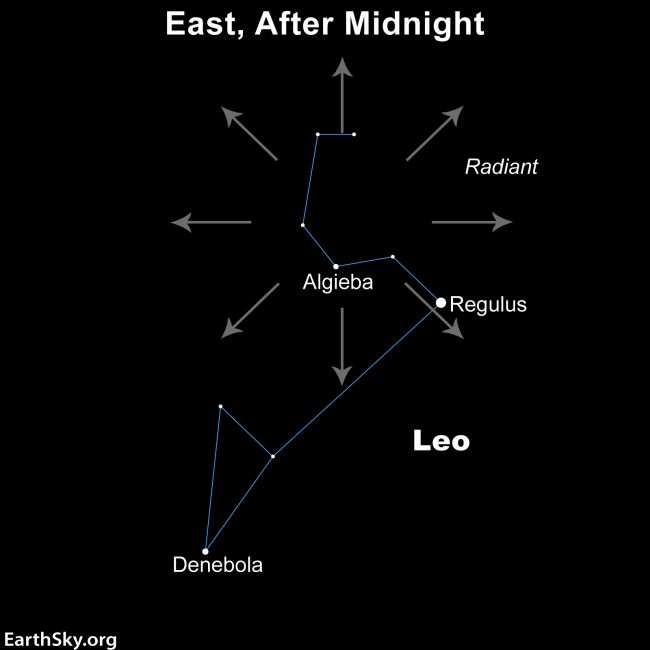 Leonids stream from a single point in the sky – their radiant point – in the constellation Leo the Lion. Leo rises just before midnight in mid-November. Regulus, the brightest star in Leo the, dots a backwards question mark of stars known as the Sickle.Early to mid-December meteors … the Geminids
Leonids stream from a single point in the sky – their radiant point – in the constellation Leo the Lion. Leo rises just before midnight in mid-November. Regulus, the brightest star in Leo the, dots a backwards question mark of stars known as the Sickle.Early to mid-December meteors … the Geminids
Predicted peak: is predicted** for December 13, 2024, at 21:00 UTC.
When to watch: Since the radiant rises in mid-evening, you can watch for Geminids all night around the peak dates of December 13. However, an almost full moon will compete with the Geminids in 2024. Luckily, a lot of Geminid meteors are bright. Find a way to block out the bright moon when watching the sky.
Overall duration of shower: November 19 to December 24.
Radiant: Rises in mid-evening, highest around 2 a.m. See chart below.
Nearest moon phase: In 2024, the full moon falls at 9:02 UTC on December 15. So there will be a moonlit sky during the peak of the 2024 Geminid meteor shower.
Expected meteors at peak, under ideal conditions: Under a dark sky with no moon, you might catch 120 Geminid meteors per hour.
Note: The bold, white, bright Geminids give us one of the Northern Hemisphere’s best showers, especially in years when there’s no moon. They’re also visible, at lower rates, from the Southern Hemisphere. The meteors are plentiful, rivaling the August Perseids.
Read more: All you need to know about Geminid meteors
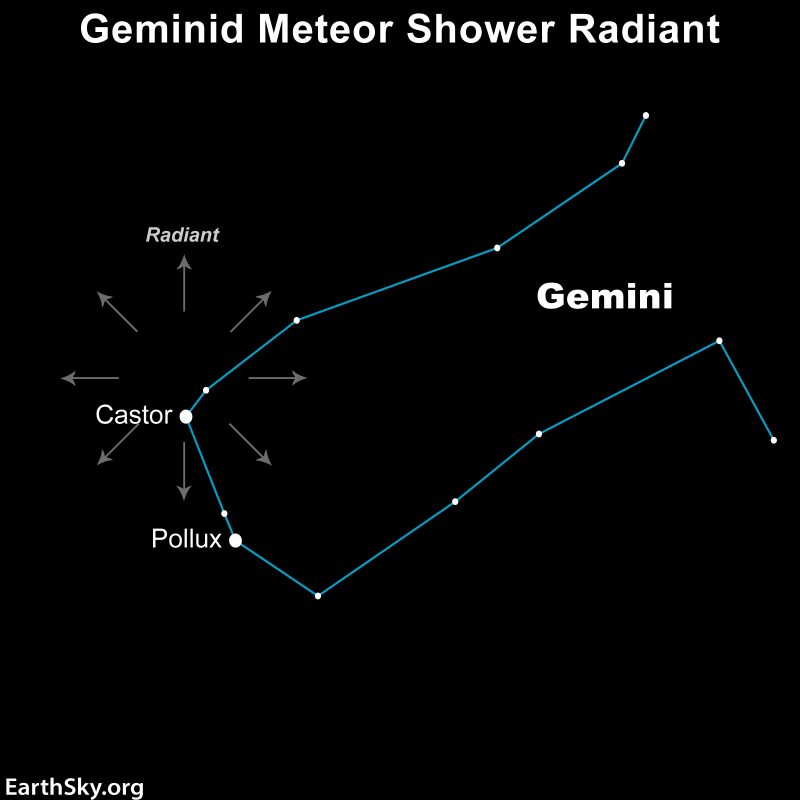 Geminid meteors radiate from near the bright star Castor in the constellation Gemini the Twins, in the east on December evenings.Meteor shower around the December solstice … the Ursids
Geminid meteors radiate from near the bright star Castor in the constellation Gemini the Twins, in the east on December evenings.Meteor shower around the December solstice … the Ursids
Predicted peak: is predicted** for December 22, 2024, at 5:22 UTC.
When to watch: Watch for Ursid meteors in the early morning hours of December 22.
Duration of shower: Ursids range from December 13 to 24, so you might see some intermingling with the Geminids’ peak.
Radiant: Circumpolar at northerly latitudes.
Nearest moon phase: A last quarter moon occurs at 22:18 UTC on December 22. So the moon – at 54% illumination – may interfere with the Ursids after midnight until dawn. Try to block out the moon after it rises around midnight.
Expected meteors at peak, under ideal conditions: Under a dark sky with no moon, the Ursids offer perhaps five to 10 meteors per hour.
Note: This low-key meteor shower – which always peaks around the solstice – is somewhat overlooked due to the holiday season. Its hourly rate is lower than that of the popular Geminid shower, which peaks over a week before.
Read more: Ursid meteors peak around December solstice
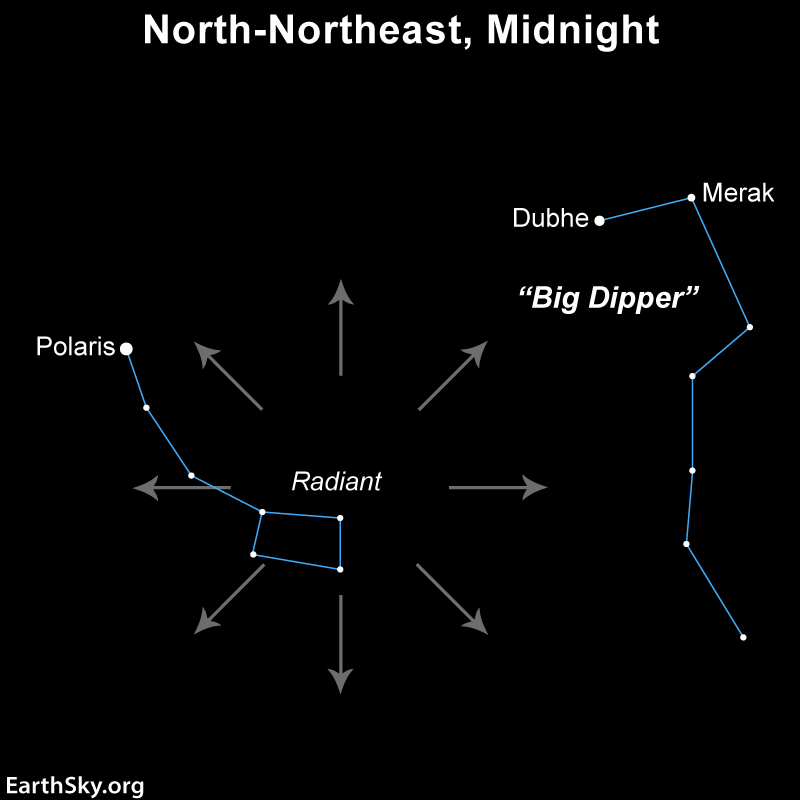 The Ursids are named for their radiant point in the constellation Ursa Minor, which contains the Little Dipper. And the Little Dipper contains the North Pole. So for the Northern Hemisphere, the radiant is above the horizon all night long. Chart via Chelynne Campion/ EarthSky.Early January 2025 meteors … the Quadrantids
The Ursids are named for their radiant point in the constellation Ursa Minor, which contains the Little Dipper. And the Little Dipper contains the North Pole. So for the Northern Hemisphere, the radiant is above the horizon all night long. Chart via Chelynne Campion/ EarthSky.Early January 2025 meteors … the Quadrantids
When to watch: The best night for the 2024 Quadrantids is January 2-3. (The predicted peak** is 19 UTC on January 3).
Nearest moon phase: A first quarter moon will come at 23:56 UTC on January 6, 2025 (CST) so the moon will be a waxing crescent and set late on January 2 and not interfere with the Quadrantid meteors.
Radiant: Rises in the north-northeast after midnight and is highest up before dawn. The radiant point for the Quadrantids is in a now-obsolete constellation, Quadrans Muralis the Mural Quadrant. Nowadays, we see the radiant near the famous Big Dipper asterism. Because the Quadrantid radiant is far to the north on the sky’s dome, this is mostly a far-northern shower, not as good for the Southern Hemisphere.
Expected meteors at peak, under ideal conditions: Under a dark sky with no moon, when the radiant is high in the sky, the Quadrantids can (briefly) produce over 100 meteors per hour.
Duration of shower: The Quadrantid meteor shower runs from mid-November through mid-January each year, according to this 2017 article in the journal Icarus. You might see a Quadrantid streak by any time during that interval. But most activity is centered on the peak.
Note: The Quadrantid shower is one of four major meteor showers each year with a sharp peak (the other three are the Lyrids, Leonids, and Ursids).
Read more: All you need to know about Quadrantid meteors
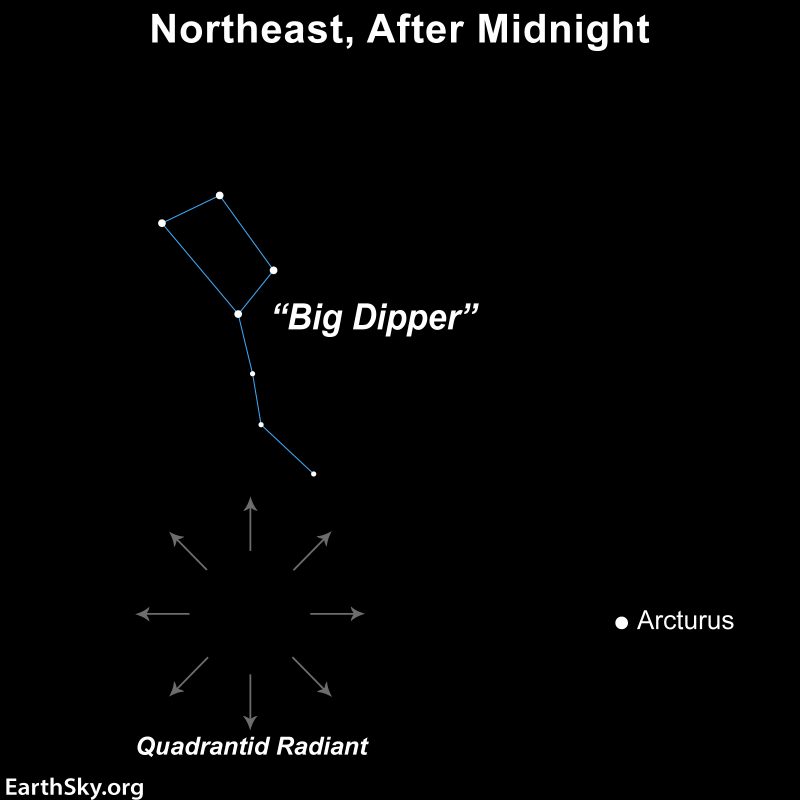 The radiant point for the Quadrantid meteor shower is far to the north in the sky and so best seen from Earth’s Northern Hemisphere. From mid-northern latitudes, the radiant point for the Quadrantid meteor shower climbs over the horizon after midnight and is highest up before dawn.April 2025 meteors … the Lyrids
The radiant point for the Quadrantid meteor shower is far to the north in the sky and so best seen from Earth’s Northern Hemisphere. From mid-northern latitudes, the radiant point for the Quadrantid meteor shower climbs over the horizon after midnight and is highest up before dawn.April 2025 meteors … the Lyrids
When to watch in 2025: Late evening April 21 until dawn April 22 will be best. The predicted** peak is 16 UTC on April 22. The peak of the Lyrids is narrow (no weeks-long stretches of meteor-watching, as with some showers). In 2025, the last quarter moon falls at 1:36 UTC on April 21. So meteor watching will be impacted by a thick waning crescent moon.
Radiant: Rises before midnight, highest in the sky at dawn.
Nearest moon phase: Last quarter moon falls at 1:36 UTC on April 21. So a fat waning crescent moon will be in the sky during the peak morning for the 2025’s Lyrid meteor shower.
Duration of shower: April 15 to April 29.
Expected meteors at peak, under ideal conditions: In a dark sky with no moon, you might see 10 to 15 Lyrids per hour. The Lyrids are known for uncommon surges that can sometimes bring rates of up to 100 per hour! Read more about Lyrid outbursts.
Note for Southern Hemisphere: This shower’s radiant point is far to the north on the sky’s dome. So the Southern Hemisphere will see fewer Lyrid meteors. Still, you might see some!
Read more: All you need to know about Lyrid meteors Lyrid meteors radiate from near the bright star Vega in the constellation Lyra the Harp. You don’t need to identify Vega or Lyra in order to watch the Lyrid meteor shower. But you do need to know when the radiant rises, in this case in the northeast before midnight. That’s why the Lyrids are typically best between midnight and dawn.
Lyrid meteors radiate from near the bright star Vega in the constellation Lyra the Harp. You don’t need to identify Vega or Lyra in order to watch the Lyrid meteor shower. But you do need to know when the radiant rises, in this case in the northeast before midnight. That’s why the Lyrids are typically best between midnight and dawn.
How high up are meteors when they begin to glow?
Find a Dark Sky Place, from the International Dark Sky Association
Heavens-Above: Satellite predictions customized to your location
Stellarium Online: Star maps customized to your location
Dark Site Finder, from astrophotographer Kevin Palmer
EarthSky’s tips for meteor-watchers
Why do meteor showers have a radiant point?
Meteor shower guide: photos from the EarthSky community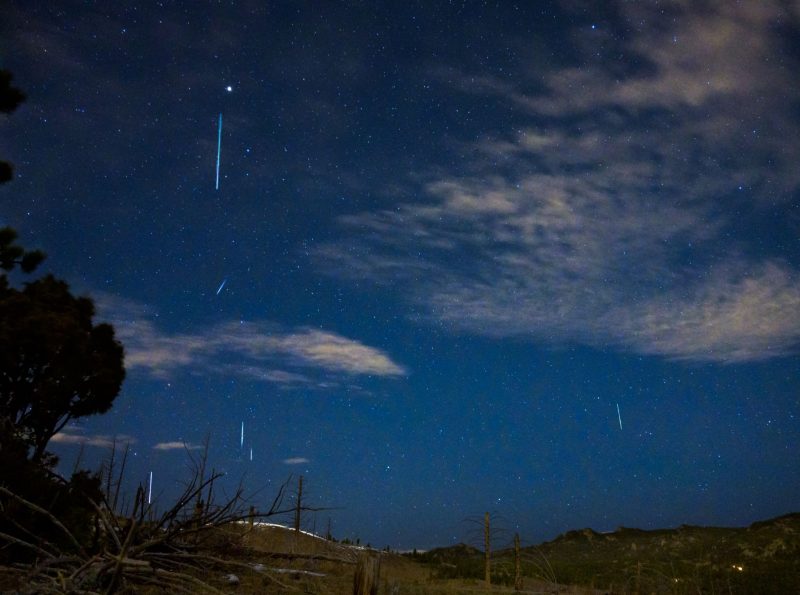 View at EarthSky Community Photos. | Photographer Thomas Hollowell in Colorado caught these Lyrid meteors on the morning of April 22, 2020, and said: “The 6 meteors in this frame were stacked in Photoshop on a set of 3 background frames.” Thanks, Thomas!
View at EarthSky Community Photos. | Photographer Thomas Hollowell in Colorado caught these Lyrid meteors on the morning of April 22, 2020, and said: “The 6 meteors in this frame were stacked in Photoshop on a set of 3 background frames.” Thanks, Thomas!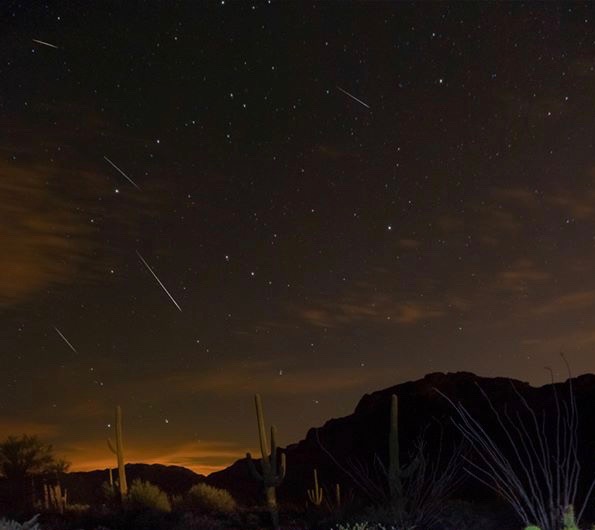 Draconids near Tucson, Arizona, in 2013, by our friend Sean Parker Photography.
Draconids near Tucson, Arizona, in 2013, by our friend Sean Parker Photography.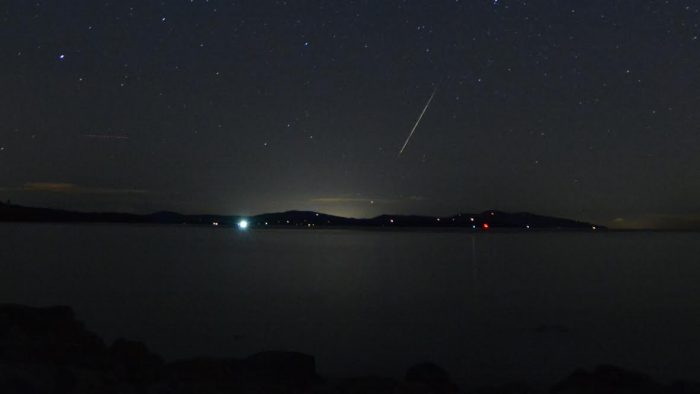 James Younger sent in this photo during the 2015 peak of the Leonid meteor shower. It’s a meteor over the San Juan Islands in the Pacific Northwest.
James Younger sent in this photo during the 2015 peak of the Leonid meteor shower. It’s a meteor over the San Juan Islands in the Pacific Northwest.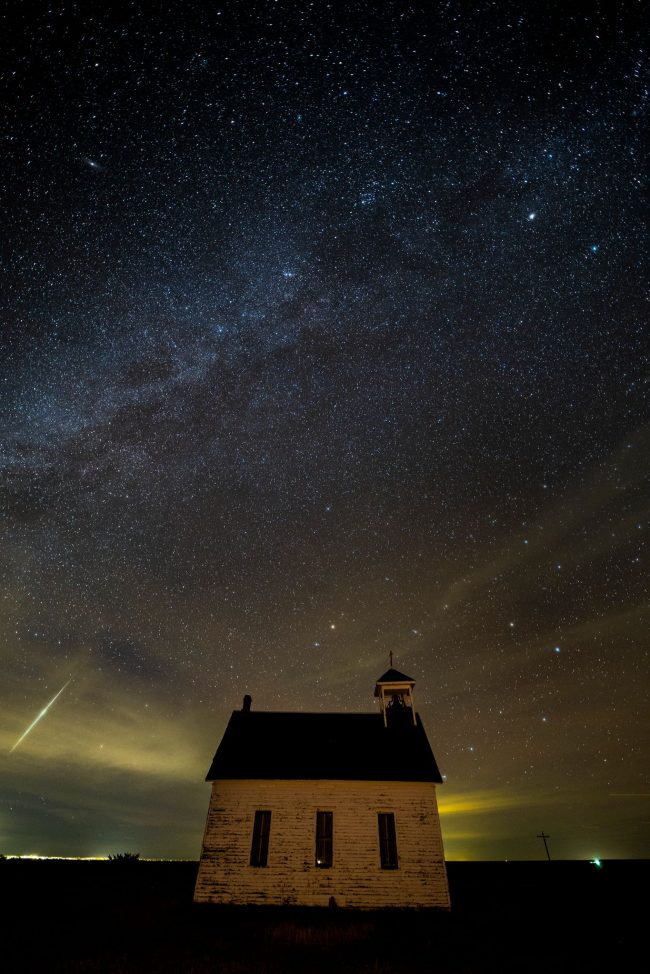 View at EarthSky Community Photos. | William Mathe captured this image on December 20, 2019, in Lindon, Colorado. He wrote: “My wife and I made a 100-mile jaunt out into the eastern plains to try to capture one or more meteors from the Ursid meteor shower. We took this image facing due north. As you can see, just to the right of the little white church is Ursa Major pointing up to Polaris, and just to the left is a green ‘fireball’ meteor that lit up the sky for a second or two.” Thank you, William!
View at EarthSky Community Photos. | William Mathe captured this image on December 20, 2019, in Lindon, Colorado. He wrote: “My wife and I made a 100-mile jaunt out into the eastern plains to try to capture one or more meteors from the Ursid meteor shower. We took this image facing due north. As you can see, just to the right of the little white church is Ursa Major pointing up to Polaris, and just to the left is a green ‘fireball’ meteor that lit up the sky for a second or two.” Thank you, William! Quadrantid radiant composite via Scott MacNeill of Frosty Drew Observatory in Charleston, Rhode Island.Meteor shower words of wisdom
Quadrantid radiant composite via Scott MacNeill of Frosty Drew Observatory in Charleston, Rhode Island.Meteor shower words of wisdom
A wise person once said that meteor showers are like fishing. You go, you enjoy nature … and sometimes you catch something.
Bottom line: The Eta Aquariid meteor shower will be best before dawn on May 5 and 6. You’ll have dark skies to watch the Eta Aquariids. Your 2024 meteor shower guide here.
**Peak times for meteor showers provided by Robert Lunsford of the American Meteor Society. Note that predictions for meteor shower peak times may vary. Back to top.
The post Meteor shower guide 2024: Up next the Eta Aquariids first appeared on EarthSky.
This page is updated constantly via RSS!
Recent Comments